1946
Marlborough Fine Art was founded in 1946 in London by Frank Lloyd and Harry Fischer. Both had emigrated to Britain from Austria during the outbreak of war and first met in 1940 as soldiers in the Pioneer Corps of the British Army. In Vienna, Lloyd's family had been antique and picture dealers for three generations, while Fischer dealt in antiquarian books. The gallery opened at 17-18 Old Bond Street in London, selling antiquarian books and a few paintings and initially exhibiting works mainly by Impressionists, Post-Impressionist and French Modern masters. After opening the gallery, they were joined in 1948 by David Somerset, Duke of Beaufort.
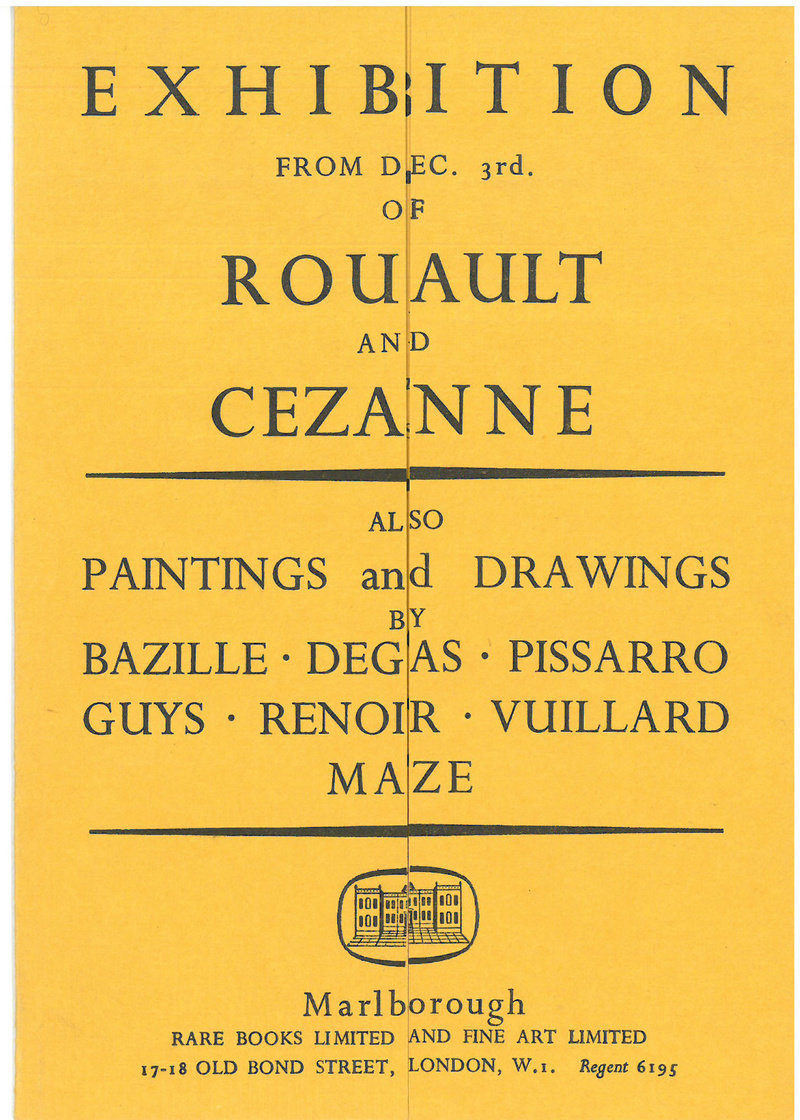
Exhibition invite for Roualt and Cezanne: Paintings and Drawings by Bazille, Degas, Pissarro, Guys, Renoir, and Vuillard, December 3, 1947, Marlborough Fine Art, London.

Exhibition catalogue for Summer Exhibition: Paintings and Drawings by Cezanne, Corot, Degas, Gauguin, Modigliani, Renoir and Van Gogh, Summer 1948, Marlborough Fine Art, London.
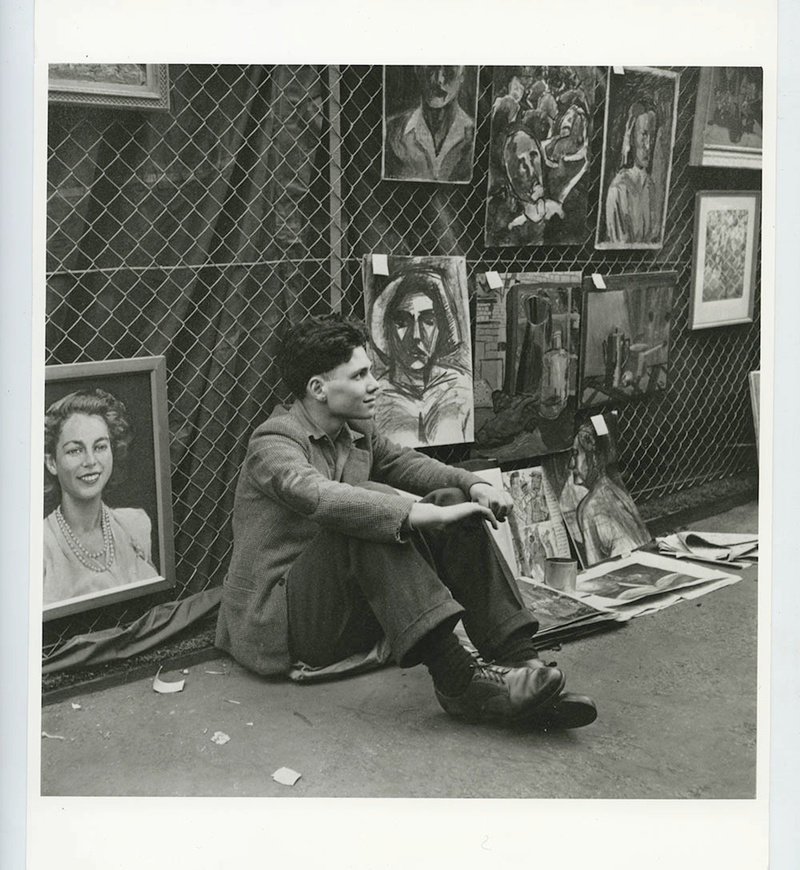
Frank Auerbach at the LCC Open Air Exhibition, July 1948, Embankment Gardens, London. Photo: C Daniel Farson.
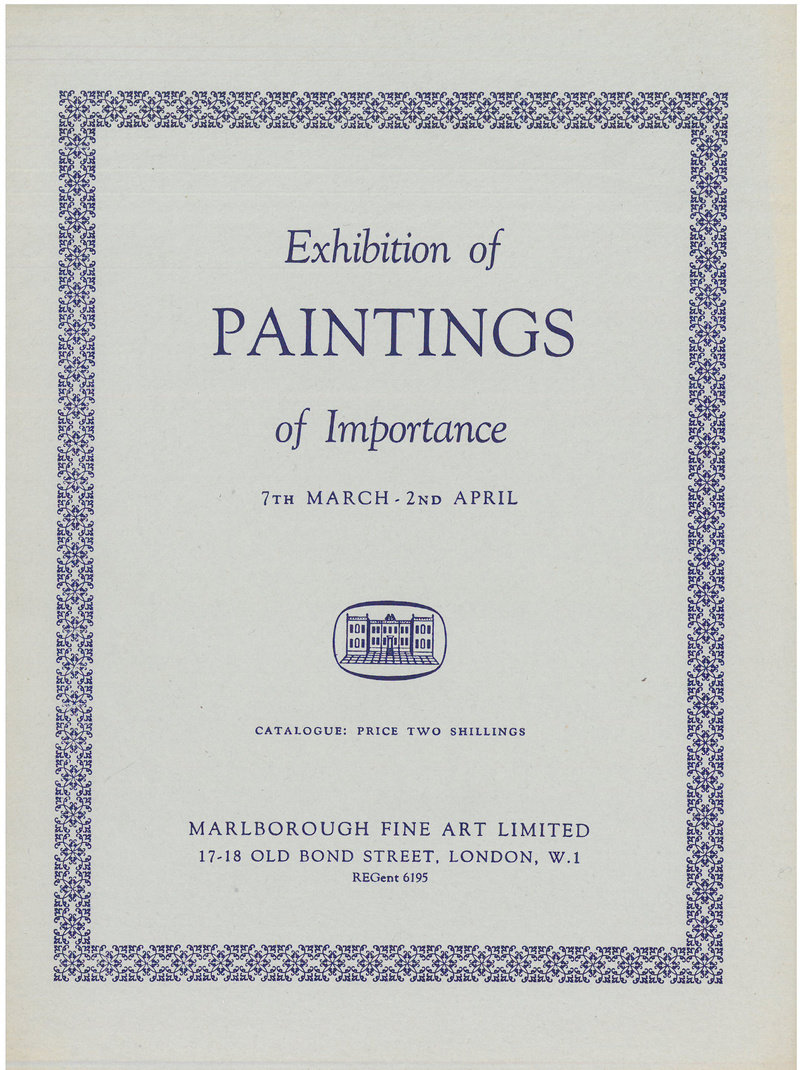
Exhibition catalogue for Exhibition of Paintings of Importance, March 7 - April 2, 1949, Marlborough Fine Art, London.

Inside cover of exhibition catalogue for Exhibition of Paintings of Importance, March 7 - April 2, 1949, Marlborough Fine Art, London.
1950
In the early 1950s, Marlborough organized exhibitions devoted to European masters of the 19th and 20th centuries, including significant exhibitions by Mary Cassatt, Jean-Baptiste Camille Corot, Claude Monet, Camille Pissarro, Alfred Sisley, Paul Signac, Auguste Renoir and Vincent van Gogh, amongst many others.
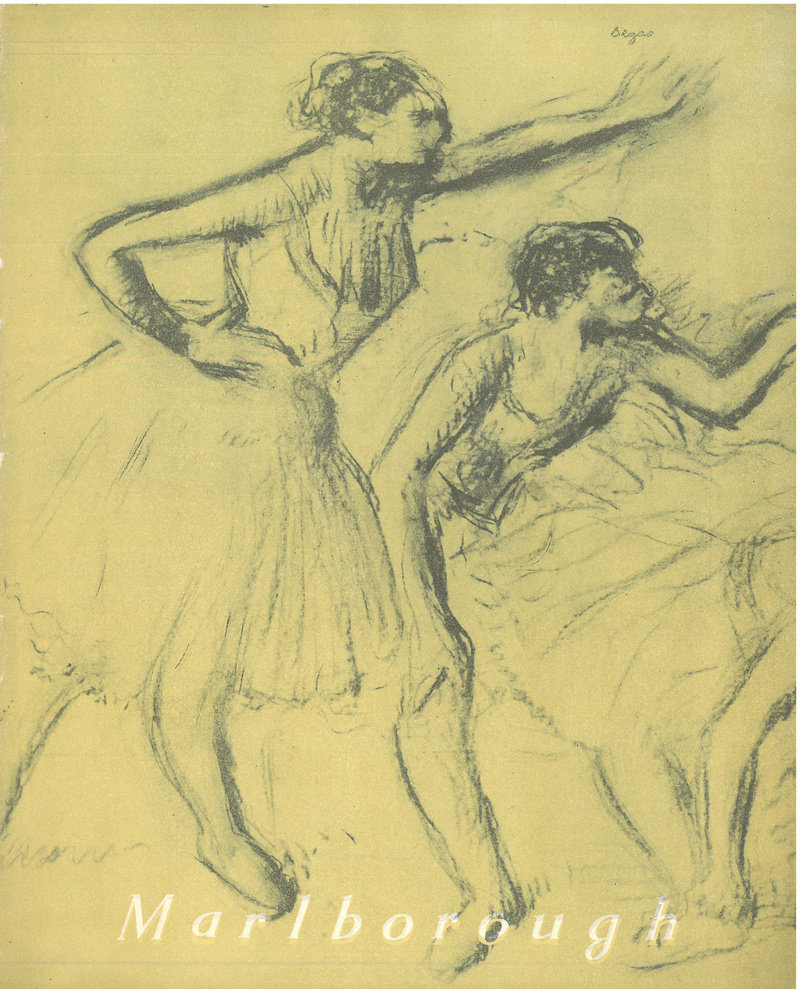
Exhibition catalogue for French Masters of the 19th and 20th Century, November - December 1950, Marlborough Fine Art, London.
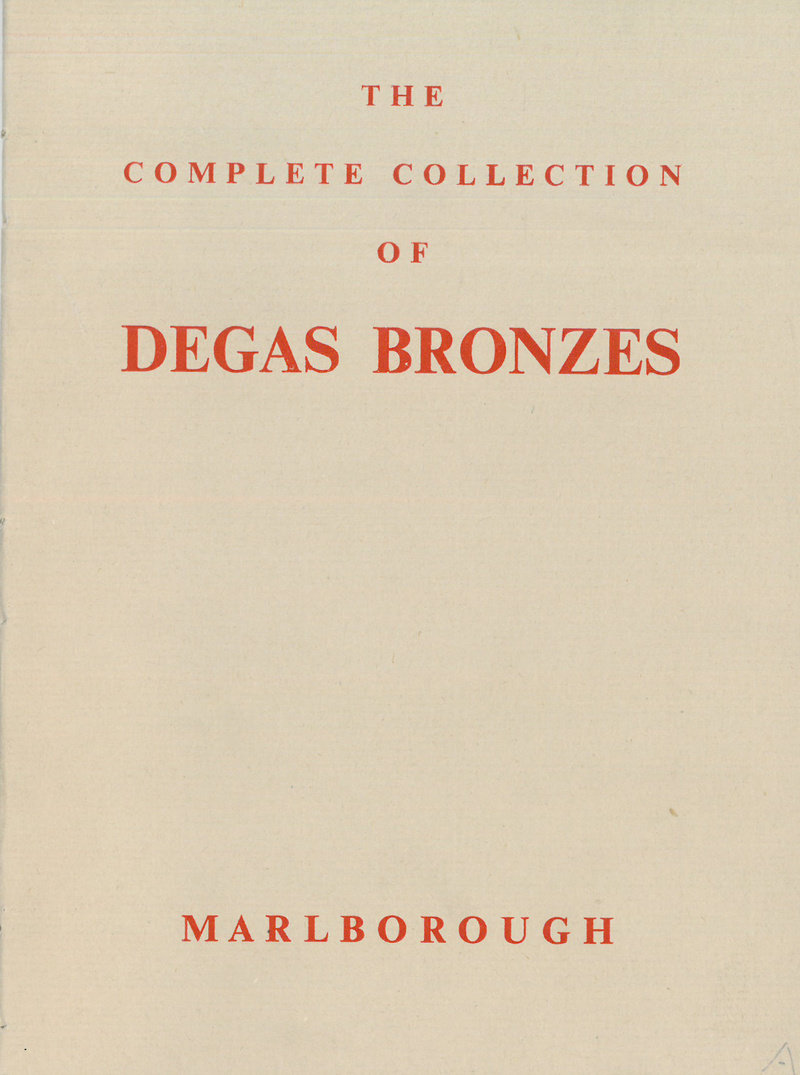
Exhibition catalogue from The Complete Collection of Degas Bronzes, December 7 - 22, 1951, Marlborough Fine Art, London.
In 1951, Marlborough Fine Art, London presented a highly esteemed exhibition of the complete collection of bronzes by French modern master Edgar Degas. Degas' iconic mixed media work, Little Dancer Aged Fourteen, 1880-1, cast c. 1922, rendered in painted bronze and dressed in a real muslin skirt and silk hair-ribbon, was sold from Marlborough’s exhibition to the Tate Gallery, where it still resides today.
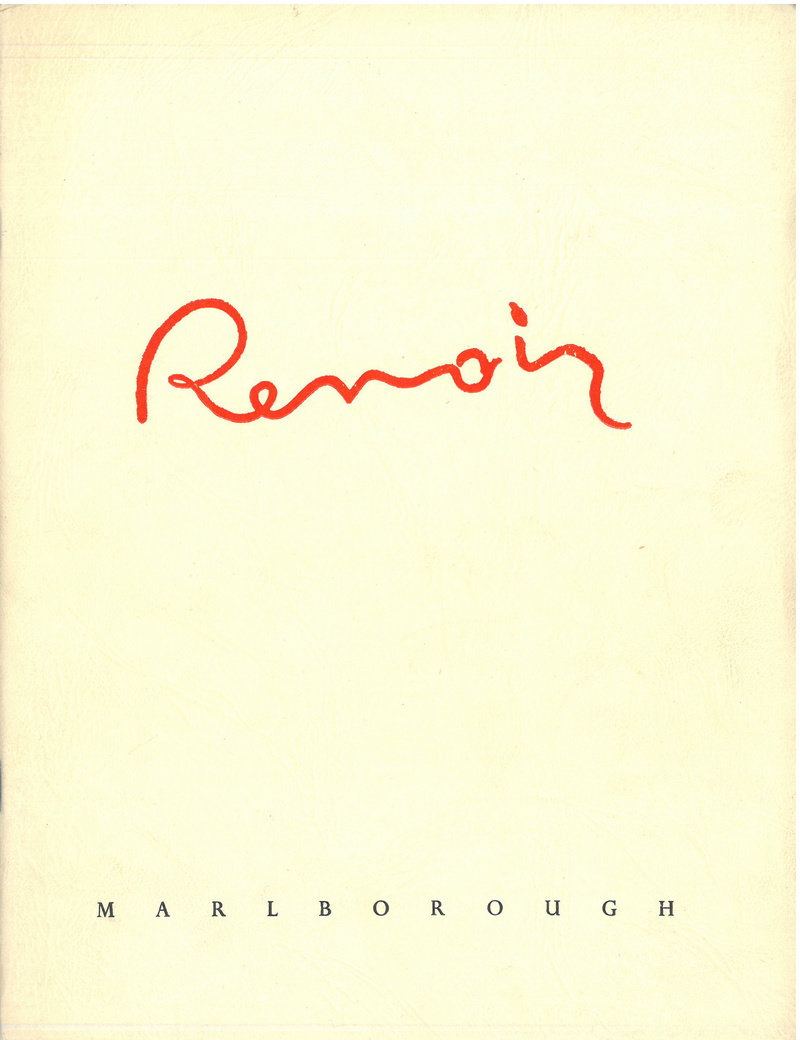
Exhibition catalogue for Renoir, April - May 1951, Marlborough Fine Art, London.
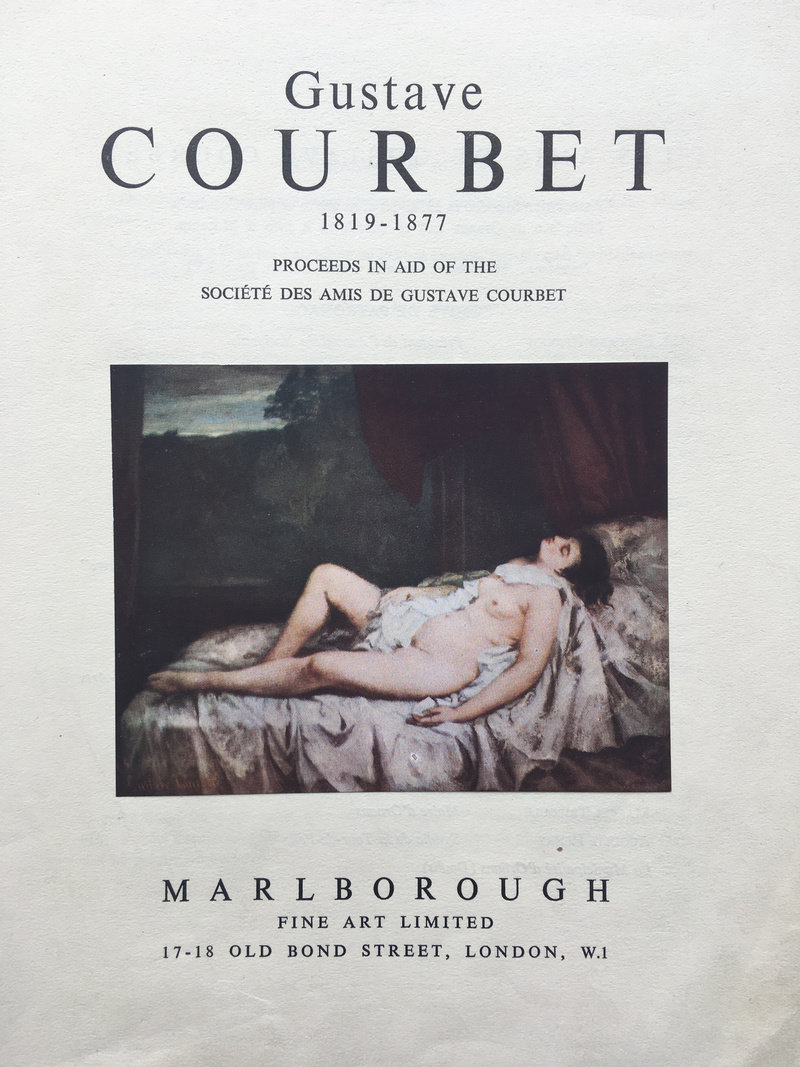
Exhibition invite for Gustave Courbet 1819—1877, May - June 1953, Marlborough Fine Art, London.
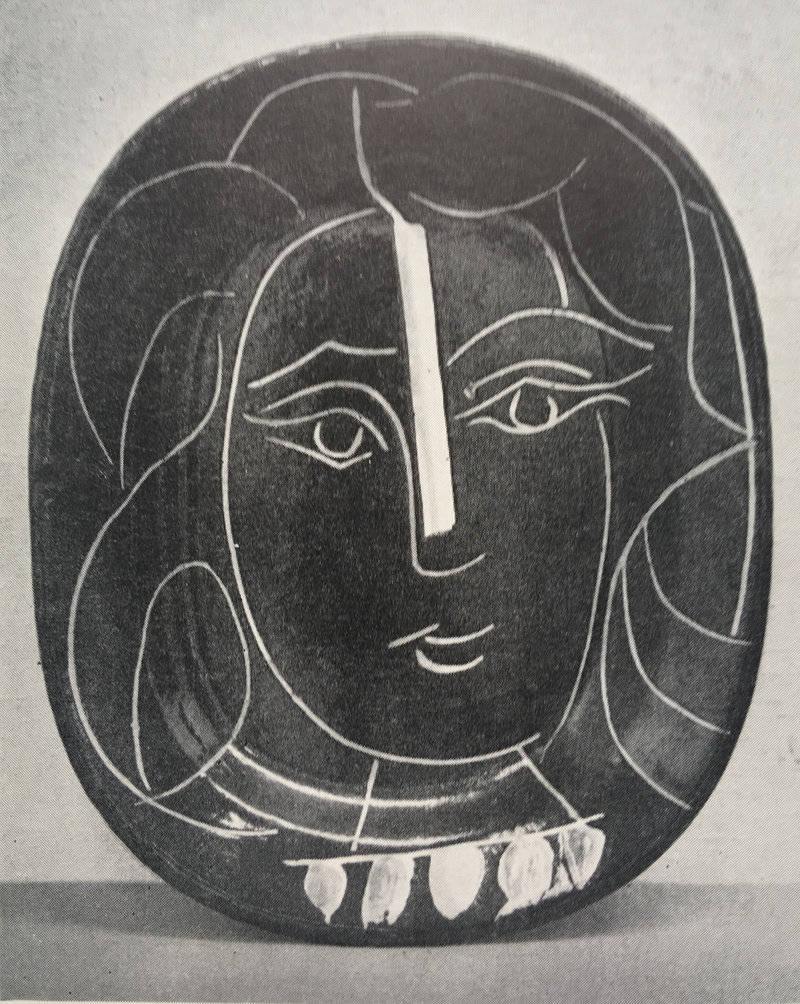
Artwork from Picasso Pottery, September 16 - October 9, 1954, Marlborough Fine Art, London.

Exhibition catalogue from Picasso Pottery, September 16 - October 9, 1954, Marlborough Fine Art, London.

‘The Ever-Creative Picasso,' The Sphere, September 25, 1954. Press for Picasso Pottery held from September 16 through October 9, 1954, at Marlborough Fine Art, London.
“At the Marlborough Fine Art Gallery, in Bond Street, until October 9, are thirty-five examples of the well-publicised but rarely seen pottery of M. Picasso. This picture shows a rectangular dish with a goat's head. Picadors and bulls figure throughout the collection, together with the familiar fish, and a seeming newcomer to the Picasso fauna: the goat."
‘The Ever-Creative Picasso,' The Sphere, September 25, 1954. Press for Picasso Pottery held from September 16 through October 9, 1954, at Marlborough Fine Art, London.
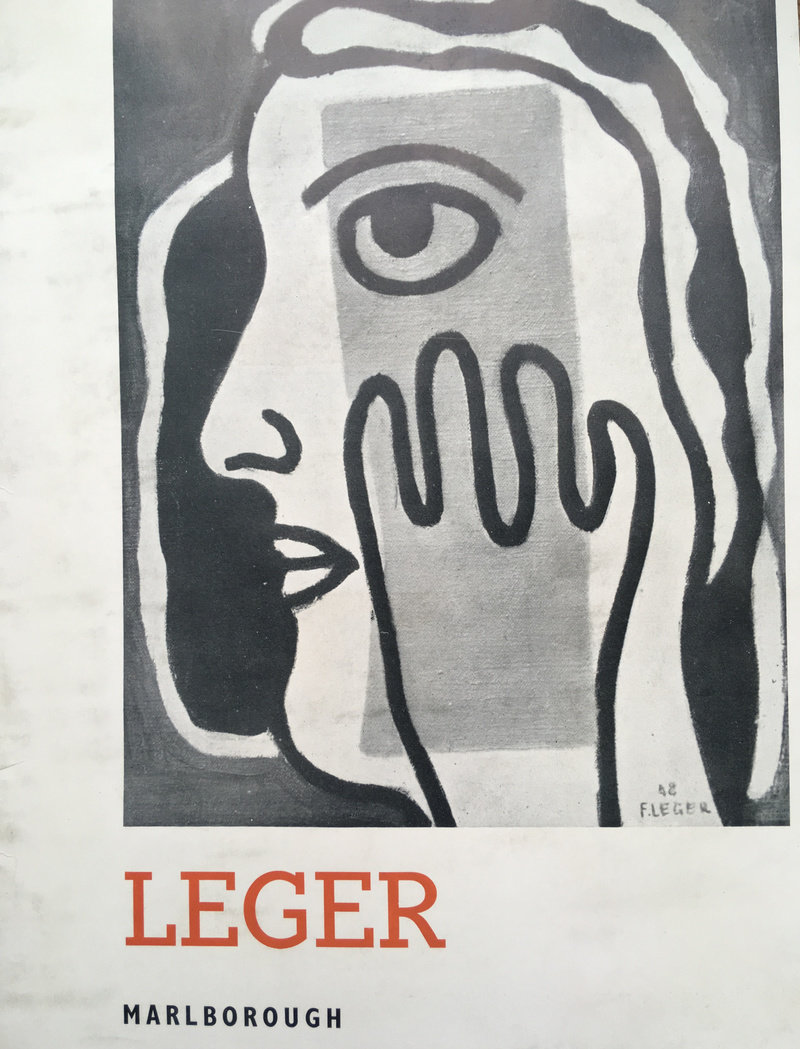
Exhibition catalogue from Leger, December 1954 - January 1955, Marlborough Fine Art, London.
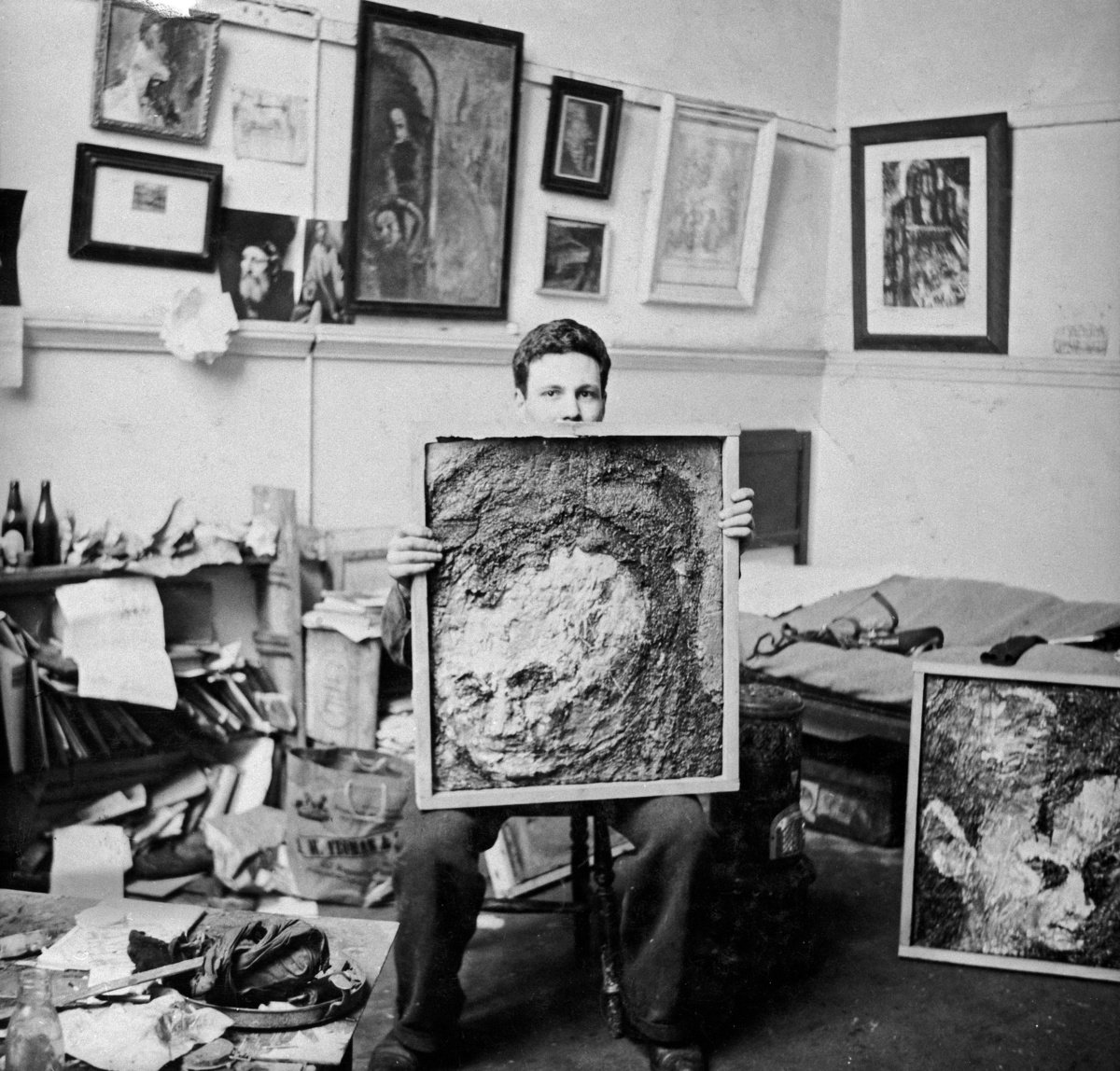
Marlborough artist Frank Auerbach in his studio with portraits of Leon Kossoff.
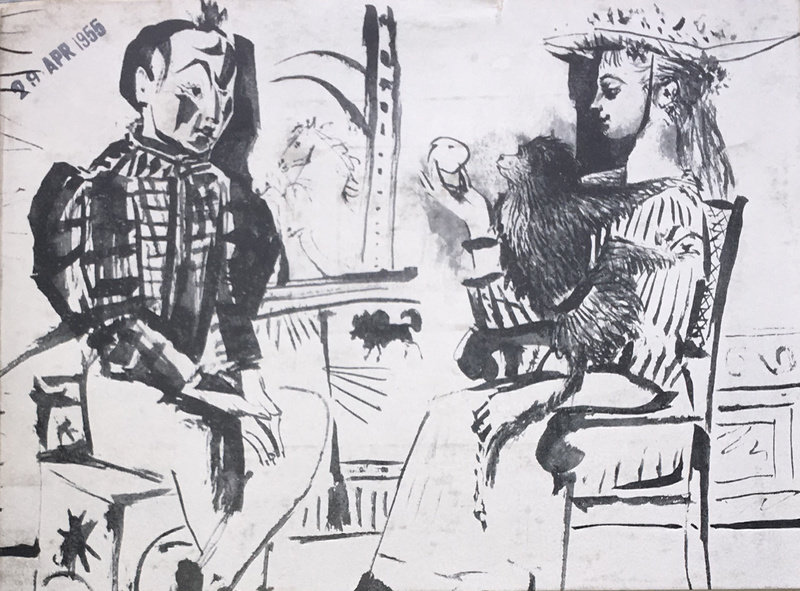
Exhibition invite for Picasso: Drawing and Bronzes, April 1955, Marlborough Fine Art, London.
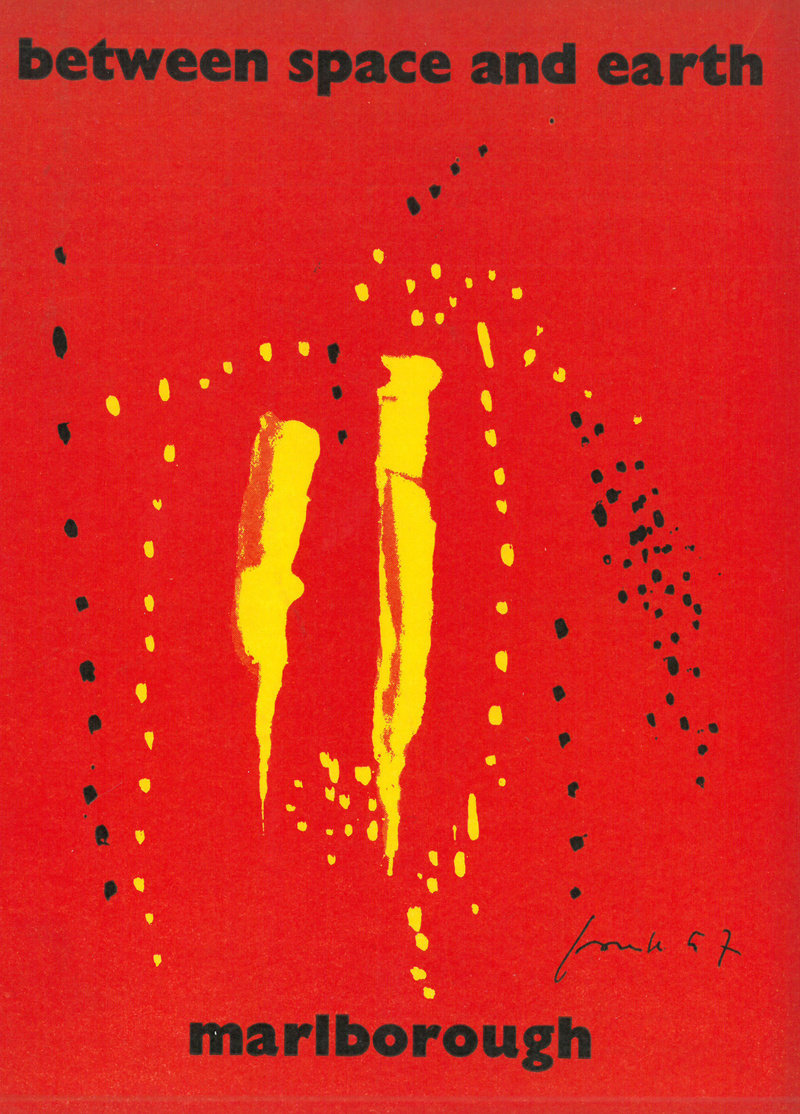
Exhibition catalogue for Between Space and Earth, Trends in modern Italian art (front cover), Marlborough Fine Art, London.
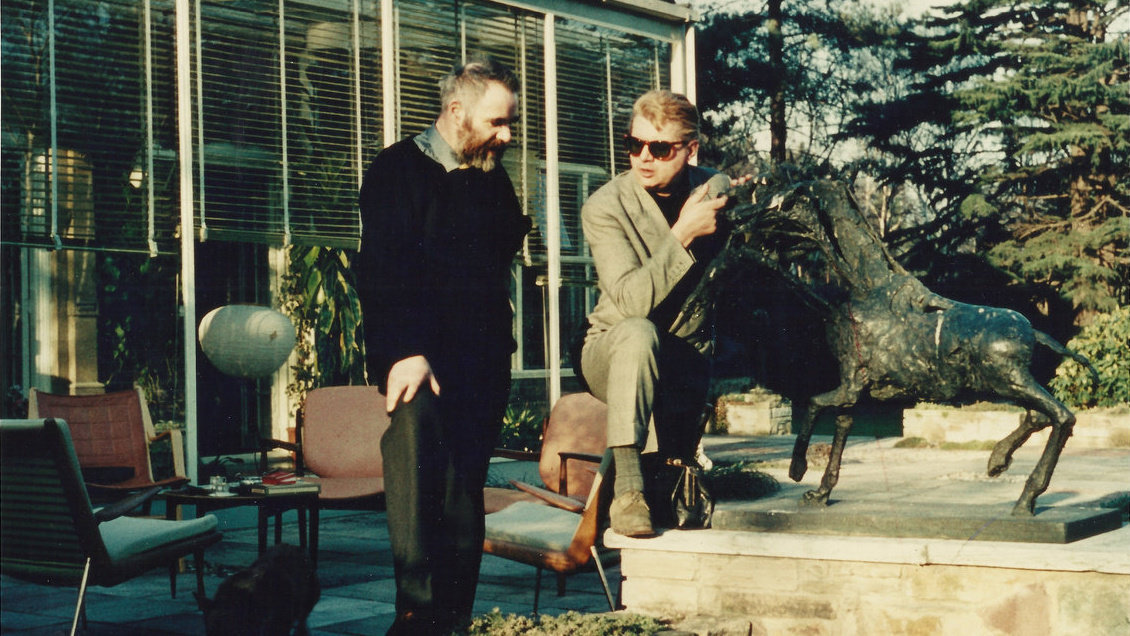
Marlborough artists Victor Pasmore and Francis Bacon viewing a Germaine Richier sculpture at Coombe Pines, Kingston Hill, Surrey, c. 1958. Photo: Gilbert Lloyd.
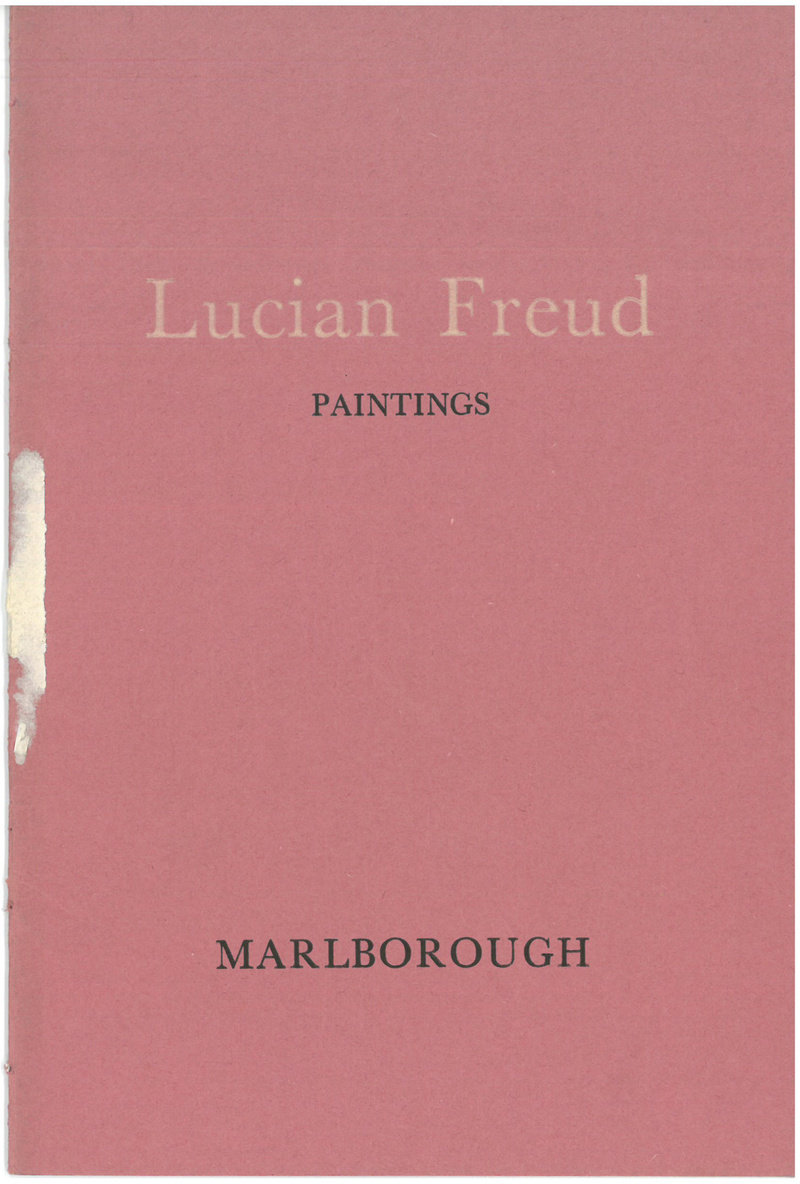
Exhibition catalogues for Lucian Freud: Paintings, March - April 1958, Marlborough Fine Art, London
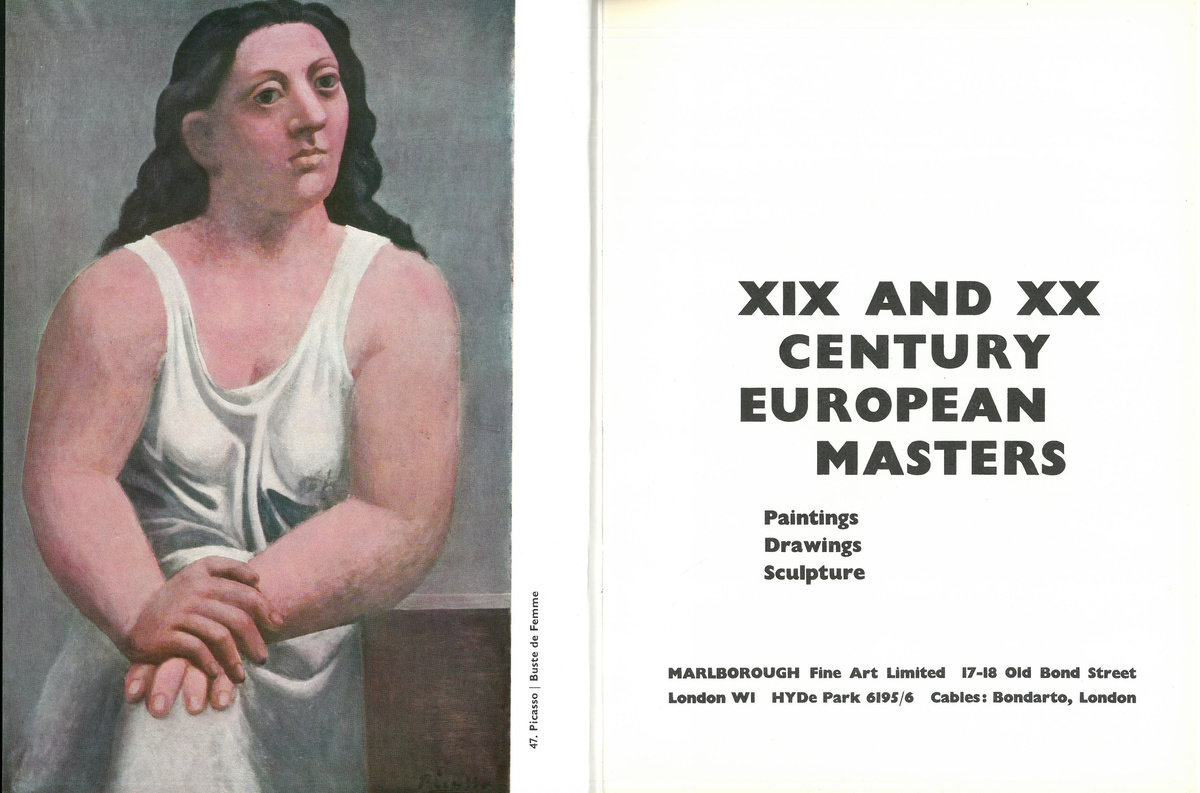
Exhibition catalogue for 19th and 20th Century European Masters, exhibition catalogue inside cover, Summer 1958, Marlborough Fine Art, London.
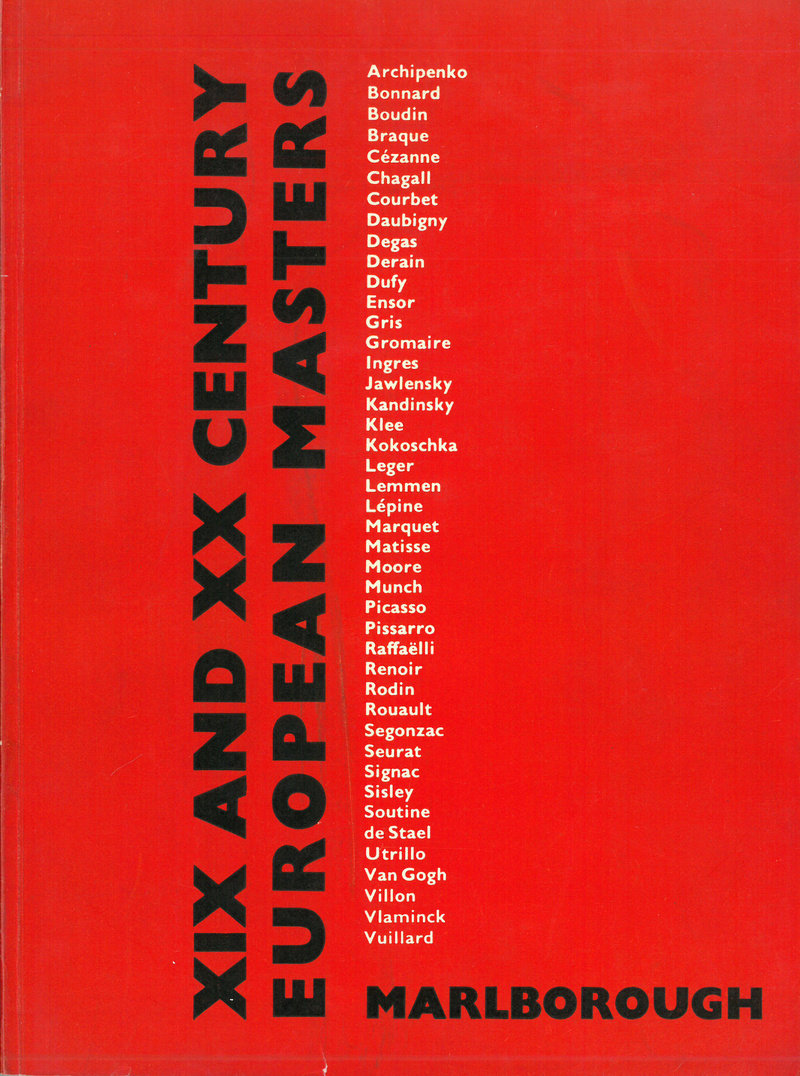
Exhibition catalogue for 19th and 20th Century European Masters, exhibition catalogue, Summer 1958, Marlborough Fine Art, London.
Apart from the Burlington Galleries' 1938 exhibition, Modern German Art (itself a riposte to the Nazis' 1937 touring exhibition, Degenerate Art), London had had very little exposure to 20th century art from Germany or Austria. Throughout the late 1950s and early 1960s, Marlborough inaugurated a series of groundbreaking exhibitions relating to Expressionism and the Modern German tradition. The gallery's 1959 exhibition, Art in Revolt: Germany 1905-1925, is perhaps the most notable of these, arguably having introduced 20th Century German art to the London art market.

Exhibition catalogue for Art in Revolt: Germany 1905-1925: Exhibition in Aid of World Refugee Year, October - November 1959, Marlborough Fine Art, London
1960
In the 1960s, Marlborough in London continued to hold a series of groundbreaking exhibitions, including Kandinsky, the Road to Abstraction, The Painters of the Bauhaus, Artists of Die Brücke and a major Kurt Schwitters retrospective. The gallery’s increasingly innovative program drew the attention of major collectors, museum directors, as well as art connoisseurs and students. The early 1960s also marked the opening of Marlborough New London at 17-18 Old Bond Street where the gallery would exhibit contemporary artists, including Kenneth Armitage, Francis Bacon, Lynn Chadwick, Barbara Hepworth, John Hoyland, R.B. Kitaj, Leon Kossoff, Henry Moore, Ben Nicholson, Sidney Nolan, Victor Pasmore, John Piper, Ceri Richards, Graham Sutherland and Joe Tilson.
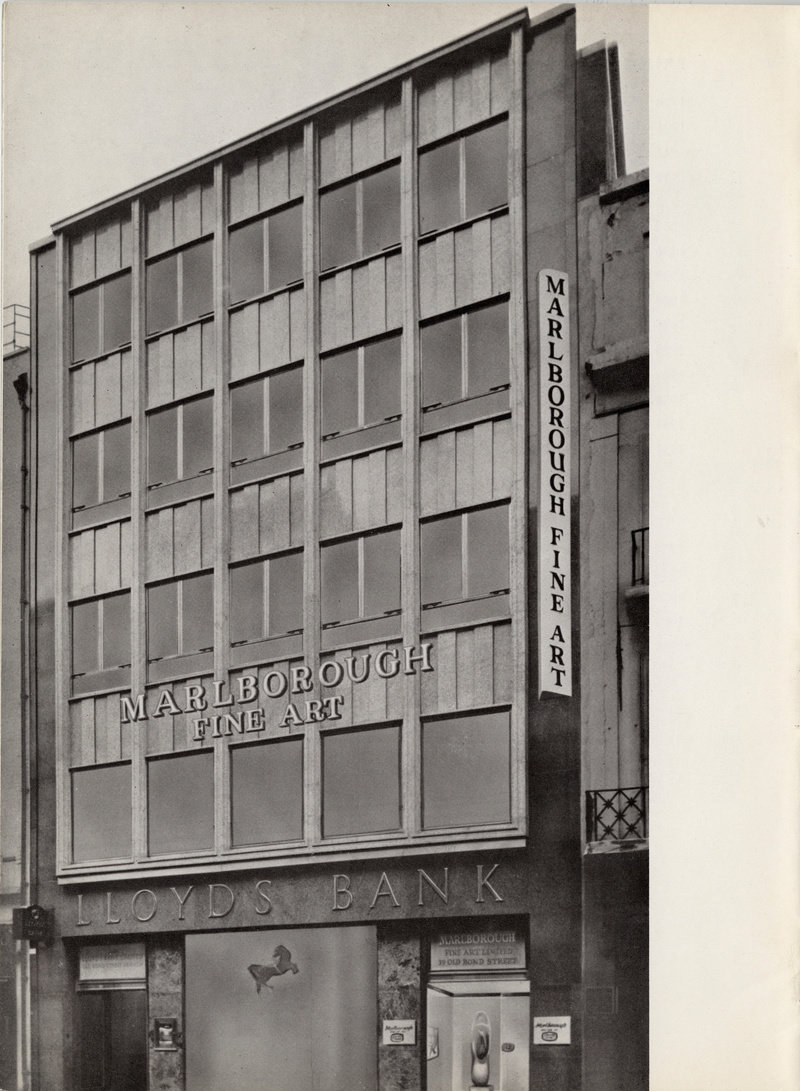
Marlborough Fine Art in 1960 at 39 Old Bond Street, London.

Exhibition catalogue from Vincent van Gogh Self Portraits, 1960, Marlborough Fine Art, London.
Marlborough inaugurated its new location at 39 Old Bond Street with its 1960 exhibition, Vincent van Gogh Self Portraits, which consisted of self-portraits and sketches produced between 1885 and the artist's death in 1890. The exhibition was organized in collaboration with Vincent van Gogh's nephew, with works lent by major institutions, including Kröller-Müller Museum, Otterlo, The Netherlands and The Stedelijk Museum, Amsterdam, The Netherlands.

David Somerset, Frank Lloyd and Harry Fischer pictured at Marlborough Fine Art, London in Paul Tanfield's article, ‘The Fine Art of Making Money,’ published in Daily Mail on October 4, 1960.
"Like the Three Musketeers, the three art dealers adhere to Alexander Dumas's motto: 'All for one and one for all.' For each is indispensable to the other."
On David Somerset, Frank Lloyd, and Harry Fischer (pictured) from Paul Tanfield's article, 'The Fine Art of Making Money,' published in Daily Mail on October 4, 1960.
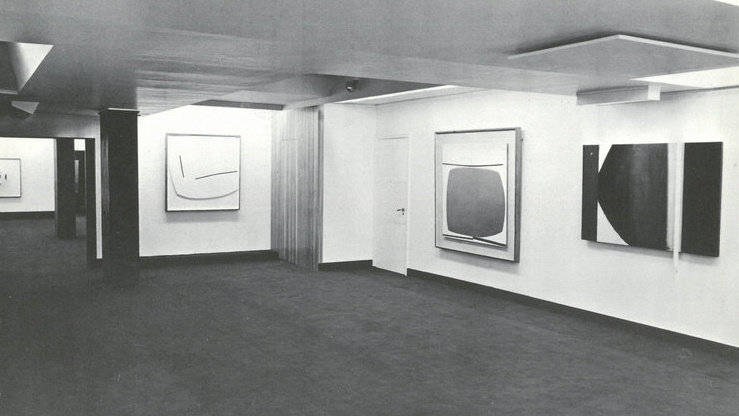
For his first exhibition at Marlborough New London, British artist Victor Pasmore redesigned the gallery's interior using hessian and boarding to create ceilings and screens that related to the colors of the fourteen paintings and twelve constructions he presented. Pasmore holds a unique place in the canon of British art, as his work and anticipated and reflected the changes that occurred in art and art practice across the twentieth century, which lead him to become one of the foremost exponents and theorists of abstract art. He continued to work with Marlborough throughout his career until his death in 1998.
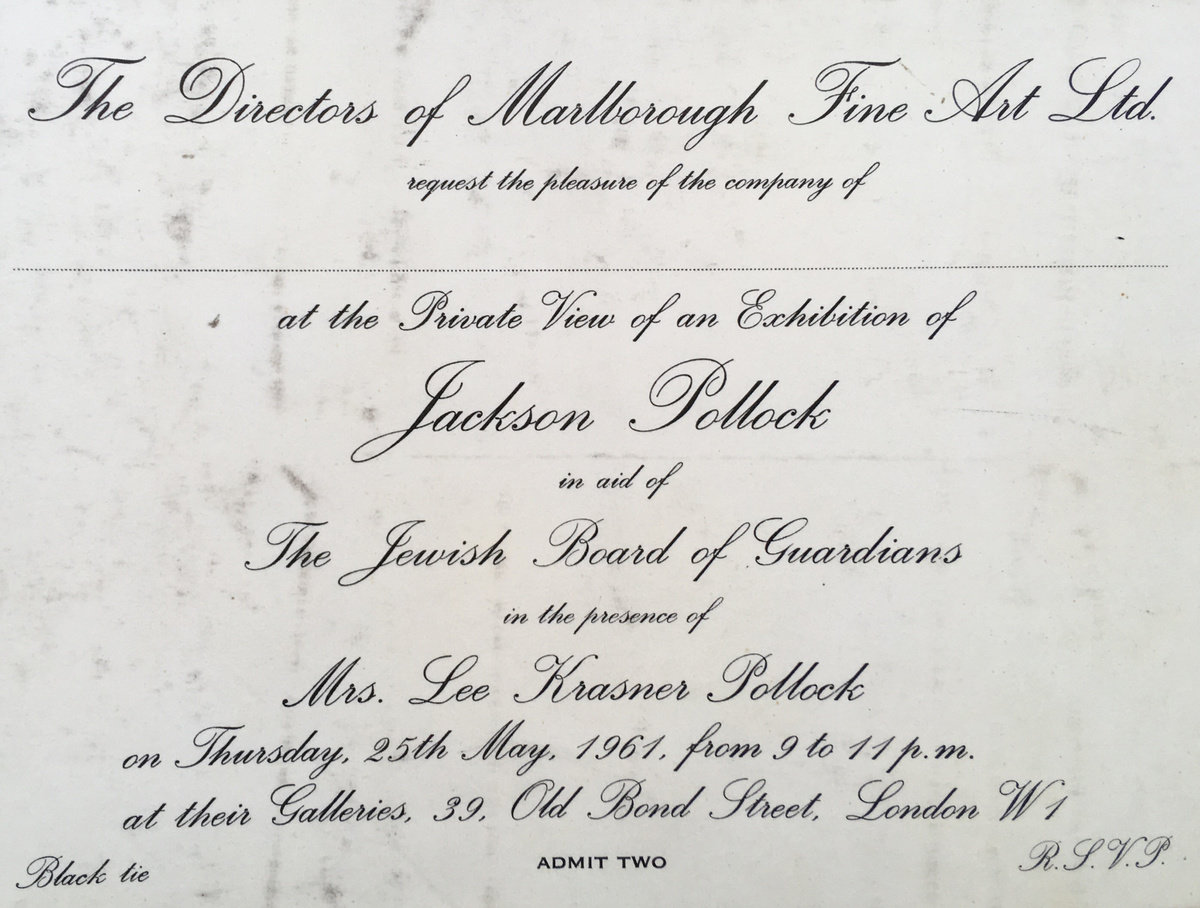
Invitation to the first exhibition of Jackson Pollock's work at Marlborough.
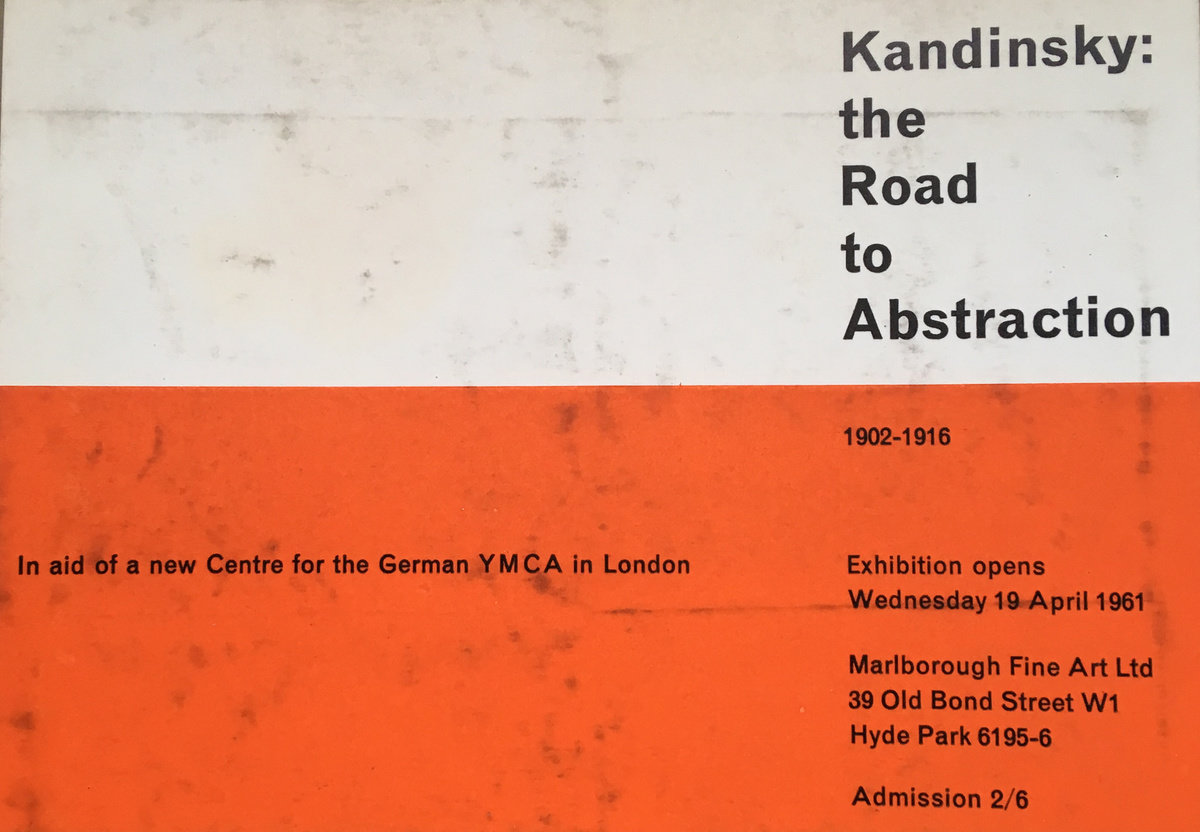
Exhibition invite for Kandinsky: Road to Abstraction, April - May 1961, Marlborough Fine Art, London.

Marlborough's Jackson Pollock exhibition featured in Lawrence Thaw Jr.'s ‘Dribbling Jack Comes To Town,’ published in London/American, May 25, 1961.
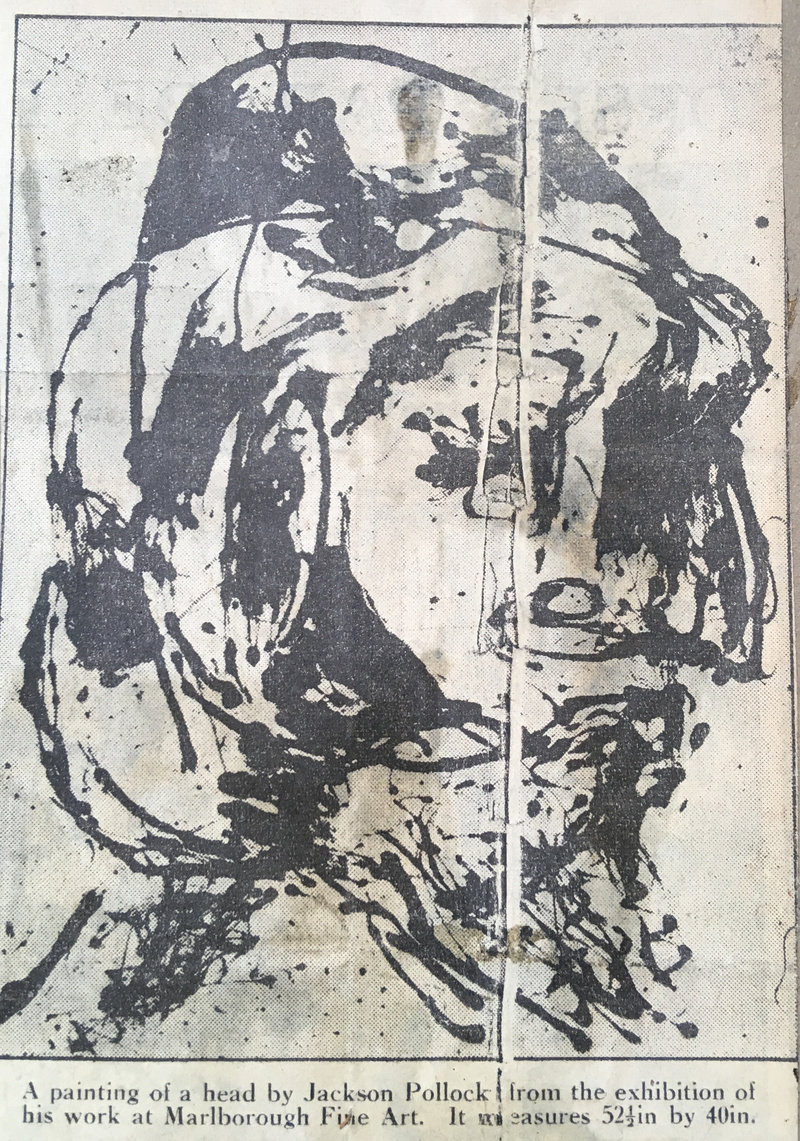
Marlborough's Jackson Pollock exhibition featured in Terence Mullaly's ‘The Vast Talent of Pollock,’ published in The Daily Telegraph, June 1, 1961.
An American in London
1961
In June 1961, Marlborough held its first exhibition with American Abstract Expressionist artist, Jackson Pollock. The exhibition showcased over sixty-two paintings, drawings and watercolors from the collection of Lee Krasner. Bringing together many previously unseen works produced between the 1930s and the artist's untimely death in 1956, the exhibition revealed the unity and originality expressed over Pollock’s oeuvre, solidifying the artist's legacy in the U.K.
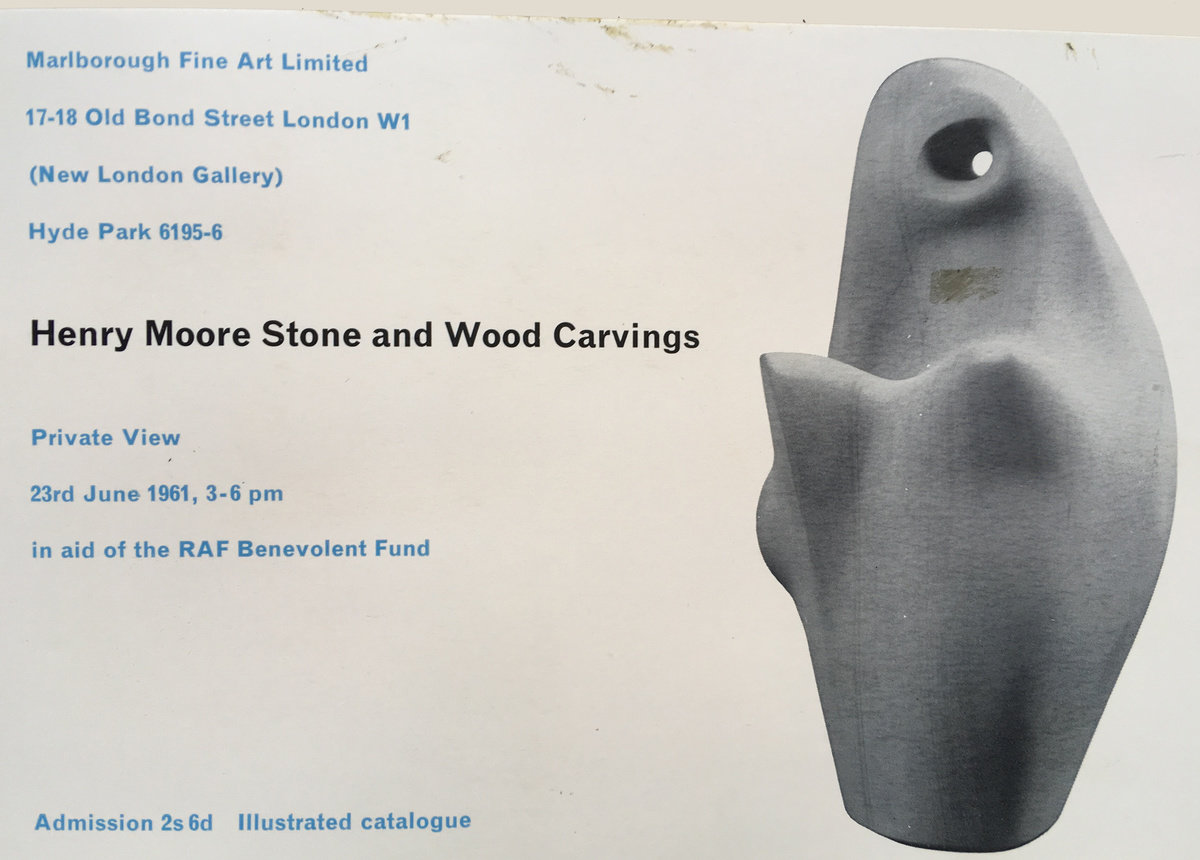
Exhibition invite for Henry Moore: Stone and Wood Carvings, June 1961, Marlborough Fine Art, London.
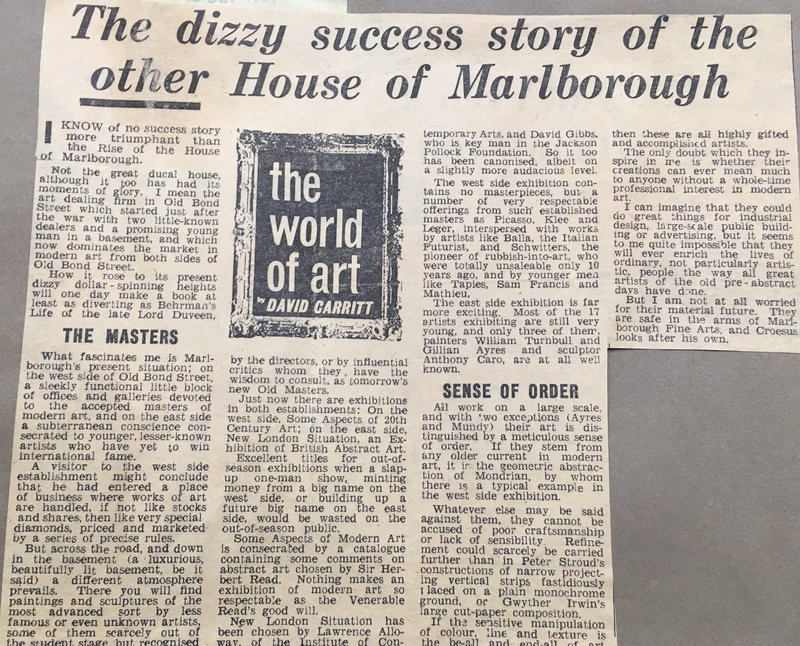
David Carritt, ‘The Dizzy Success Story of the other House of Marlborough,’ Evening Standard, September 6, 1961.
"I know of no other success story more triumphant than the Rise of the House of Marlborough."
David Carritt, 'The Dizzy Success Story of the Other House of Marlborough,' Evening Standard, September 6, 1961.
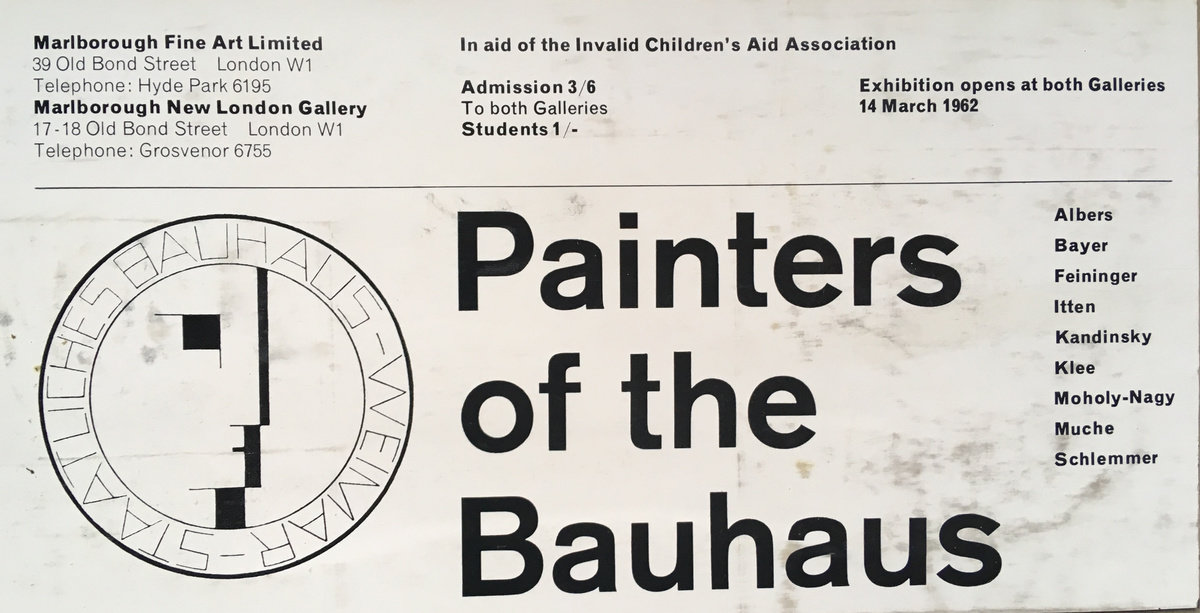
Exhibition invite for Painters of the Bauhaus, March - April 1962, Marlborough Fine Art, London.
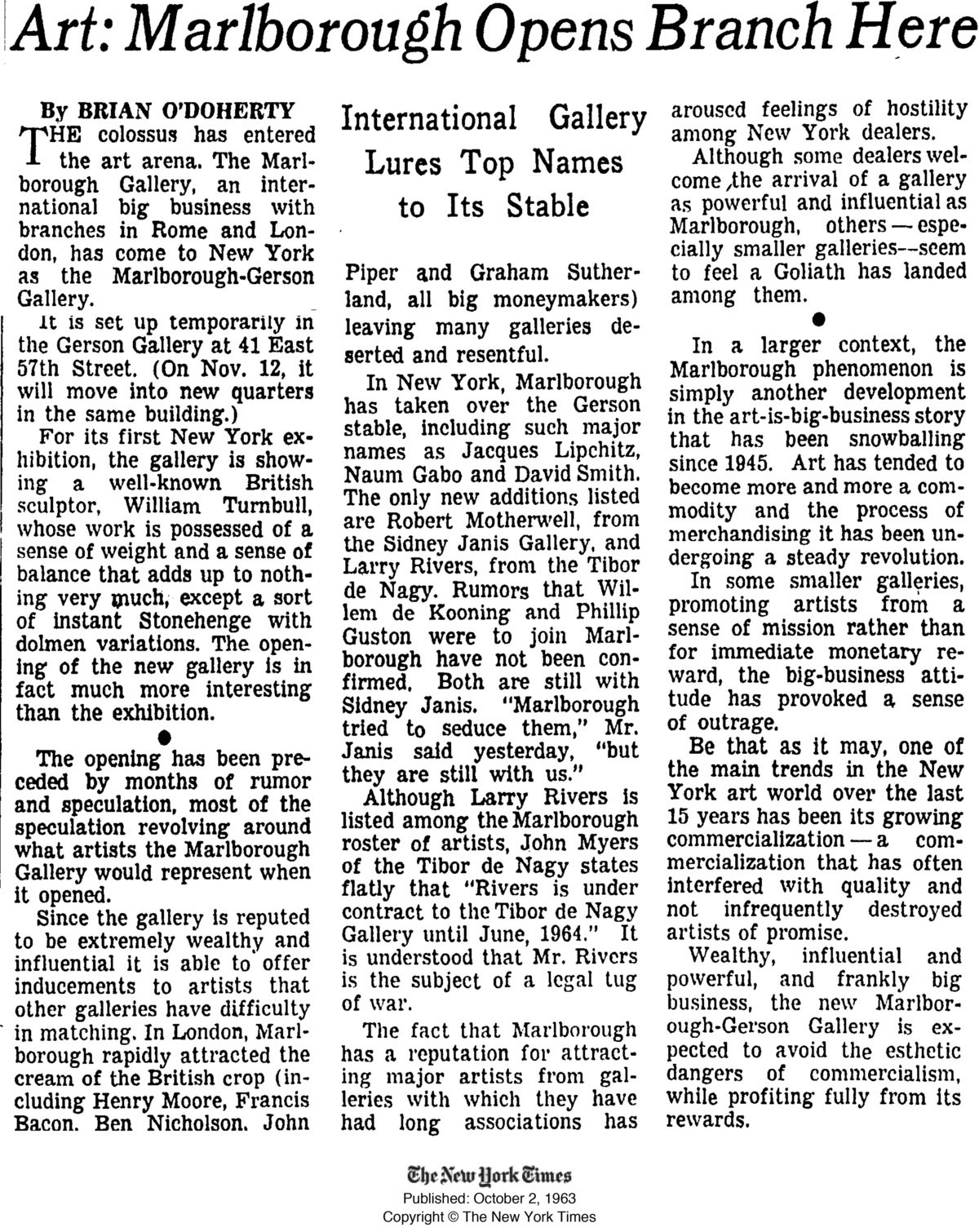
Marlborough announced the opening of its New York branch, located on East 57th Street and Madison Avenue, in October 1963. The inagural exhibition paid homage to the distinguished German refugee dealer Curt Valentin, who represented many of the British and European artists that Marlborough had been exhibiting in London.

Timothy Behrens, Lucian Freud, Francis Bacon, Frank Auerbach and Michael Andrews at Wheeler's restaurant, London, 1963. Photo: John Deakin.
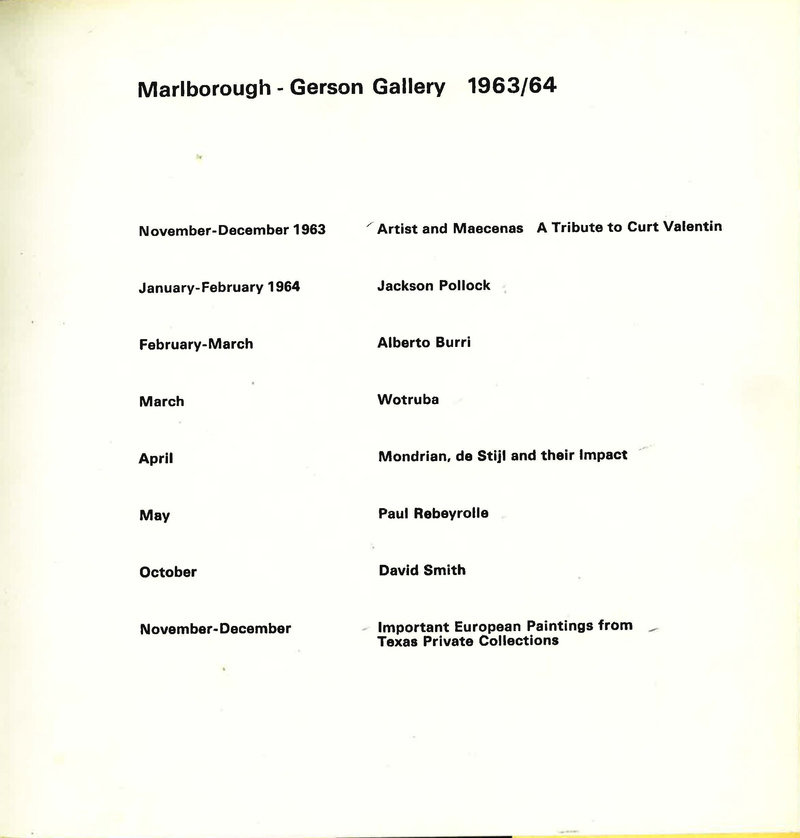
Copy of Marlborough-Gerson Gallery's 1963-1964 exhibition schedule.
"Although some dealers welcome the arrival of a gallery as powerful and influential as Marlborough, others—especially smaller galleries—seem to feel a Goliath has landed among them."
The New York Times, October 2, 1963
"Though Marlborough-Gerson is reputedly the world's largest gallery (11,000 sq. ft.), the place was so packed that at the height of the party, invited guests could not even get out of the elevator. Finally, firemen ordered the doors closed to newcomers until the crowd cleared. It was really too late. 'You can't see the pictures,' moaned a lovely thing in a floor-scraping green gown. 'You can't even see the people. You can just feel them.'"
Time Magazine reporting on Marlborough's grand opening in November 1963
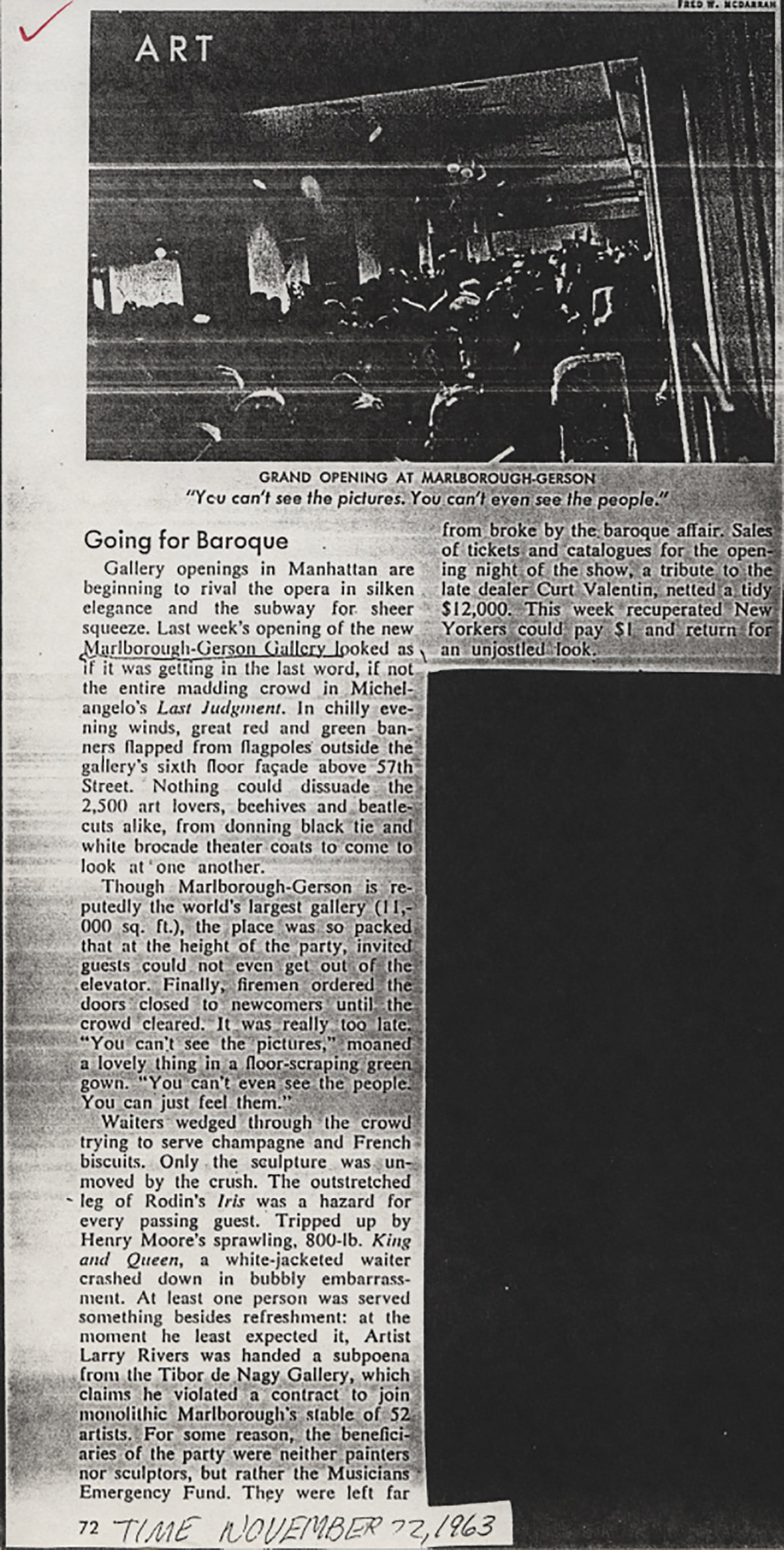
Time Magazine reported on Marlborough's grand opening in November 1963 with one attendee commenting, "You can't see the pictures. You can't even see the people."
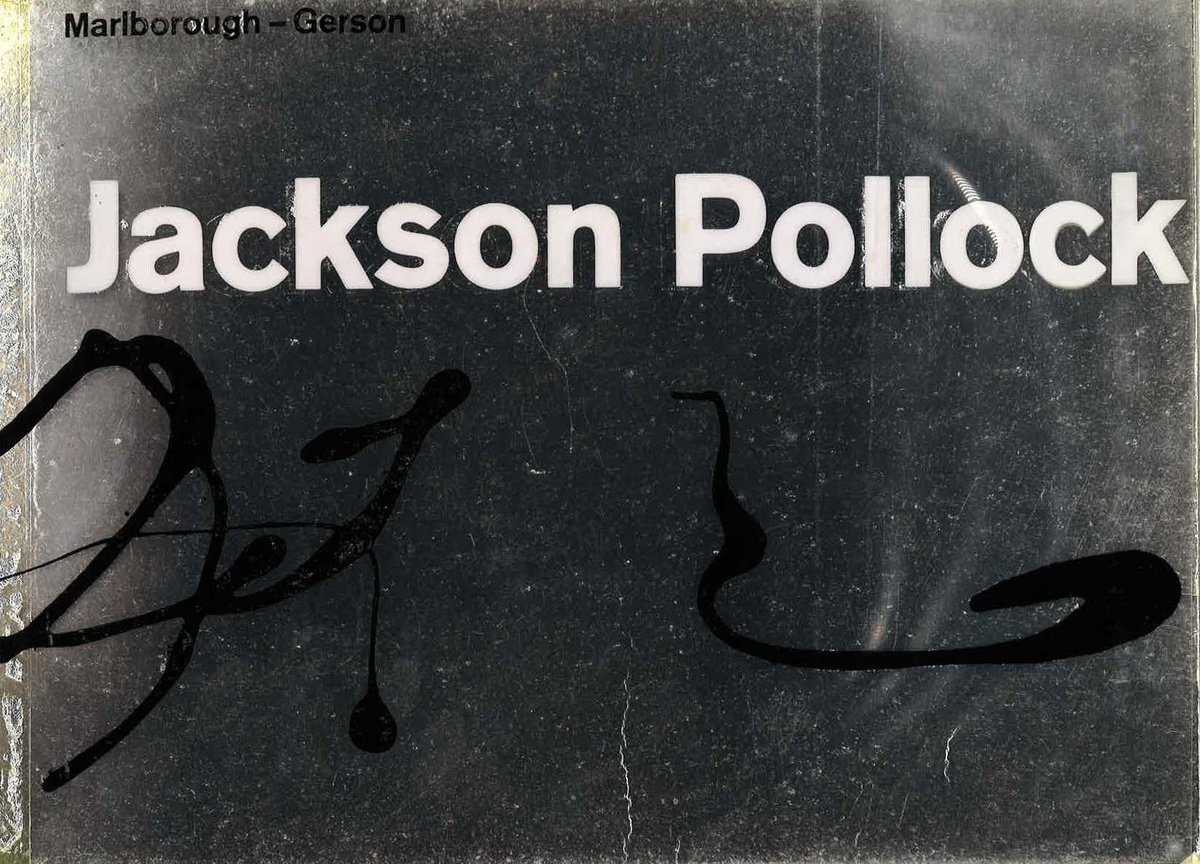
Exhibition catalogue for Jackson Pollock January - February, 1964, Marlborough-Gerson Gallery, New York.
"Egon Schiele's paintings and drawings at the Marlborough Gallery 39 Old Bond Street will either enchant or alarm visitors according to their capacity for tuning in to bitter-sweetness. In either case they will not remain unmoved."
Eric Newton, 'Egon Schiele Exhibition', published in Guardian, October 9, 1964.

Egon Schiele captured the human form in close observation to express his awareness of the human condition. Egon Schiele 1890–1918 at Marlborough Fine Art, London was the artist’s first solo exhibition held outside of Austria with over forty paintings and drawings on display. The great art collector and patron, Rudolf Leopold, wrote the catalogue essay for this seminal exhibition, entitled ‘Egon Schiele—his supporters and detractors; the story of his recognition.’ Schiele’s exhibition with Marlborough Fine Art is now commemorated on a stone inscription at the entrance to the Leopold Museum in Vienna, Austria.
Exhibition invite for Egon Schiele 1890–1918, October 9–November 14, 1964, Marlborough Fine Art, London.
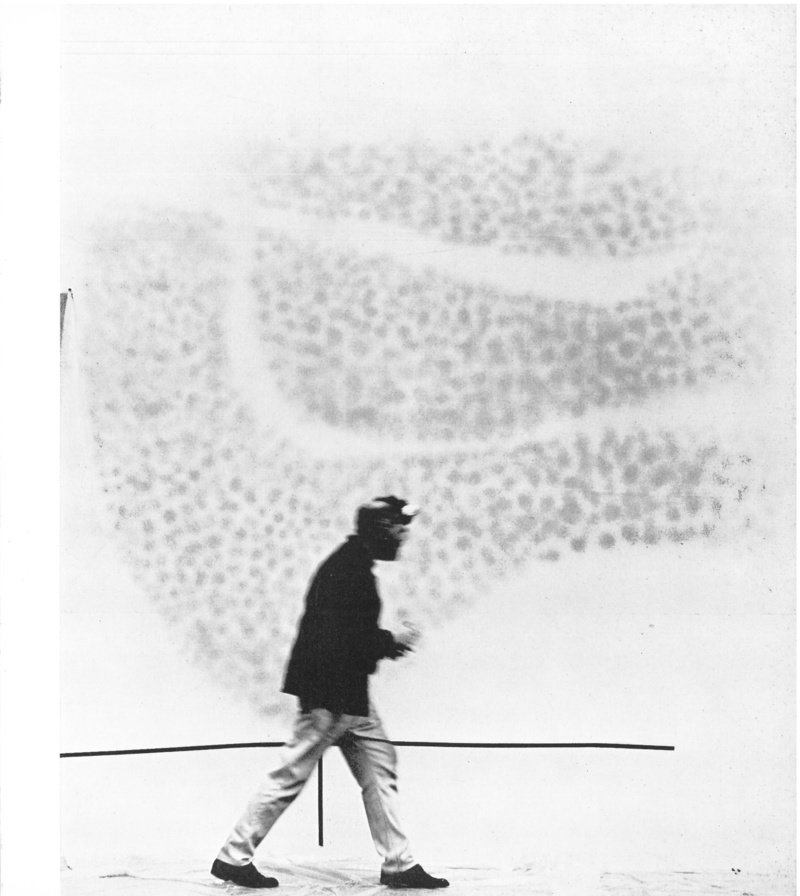
For his retrospective at Tate in 1965, Victor Pasmore created a large, site-specific mural on linen. Though illustrated in the artist’s catalogue raisonné, the mural was believed to have been destroyed after the exhibition. However, the work was rediscovered in 2018 and later exhibited in Marlborough’s 2019 exhibition Victor Pasmore: Space as Motif (Works from 1960–1970). Photo: John Pasmore.
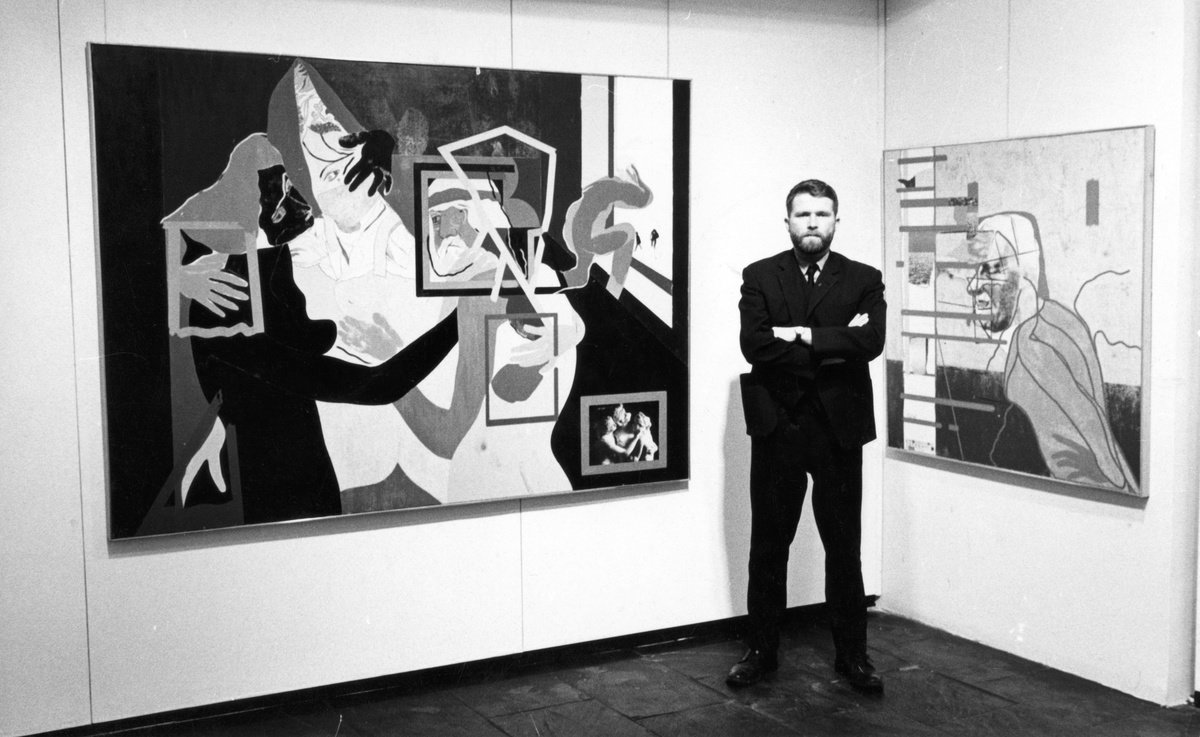
R.B. Kitaj at his February 1965 exhibition at Marlborough-Gerson Gallery, New York. Photo: Fred W. McDarrah.
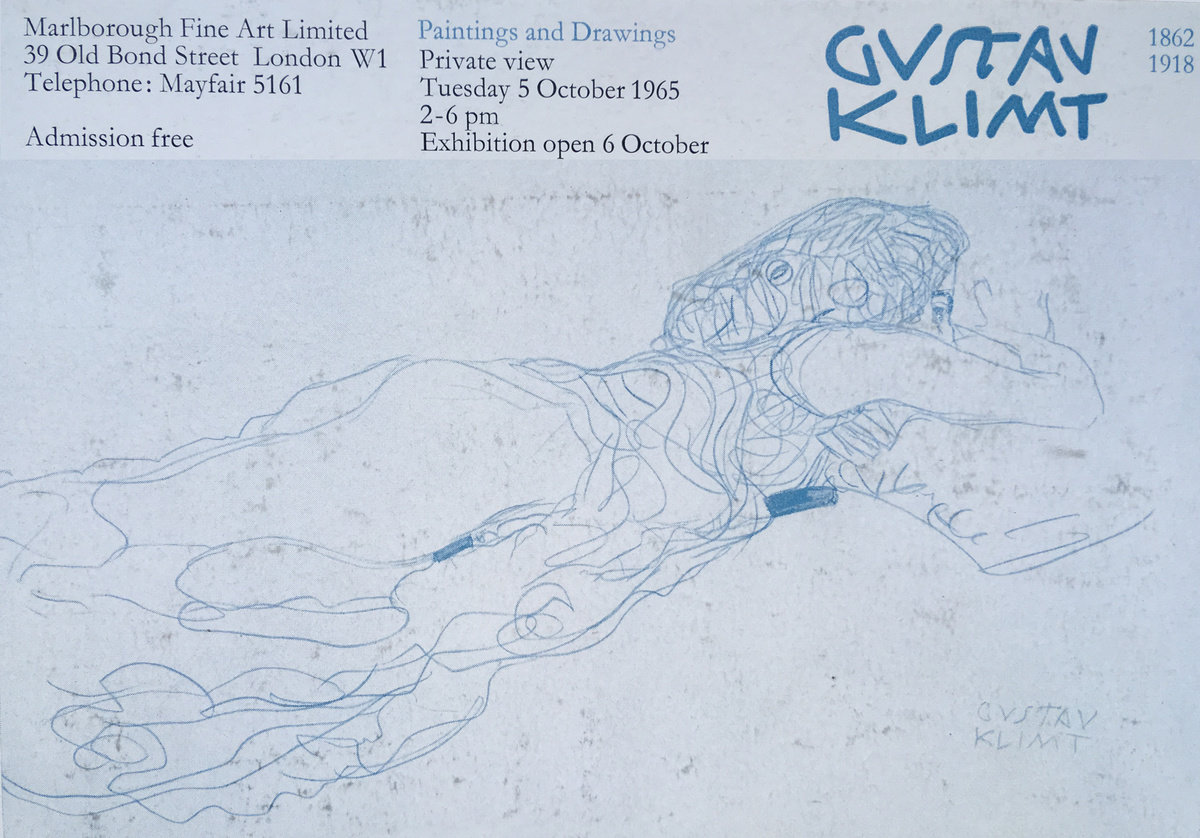
Exhibition invite for Gustav Klimt: Paintings and Drawings, October 1965, Marlborough Fine Art, London.
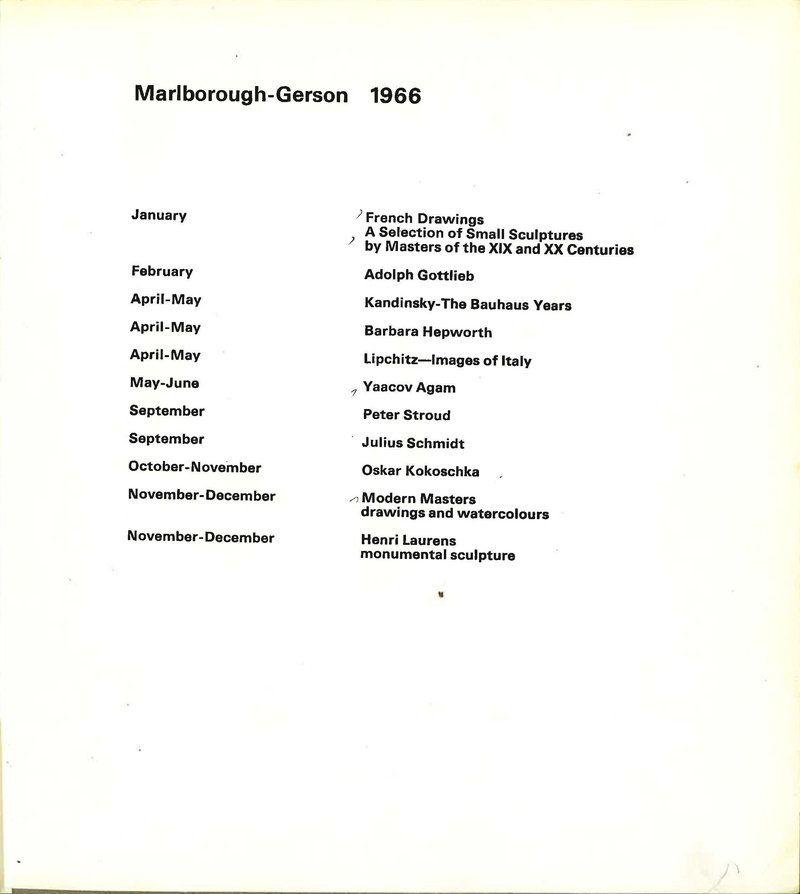
Copy of Marlborough-Gerson Gallery's 1966 exhibition schedule.
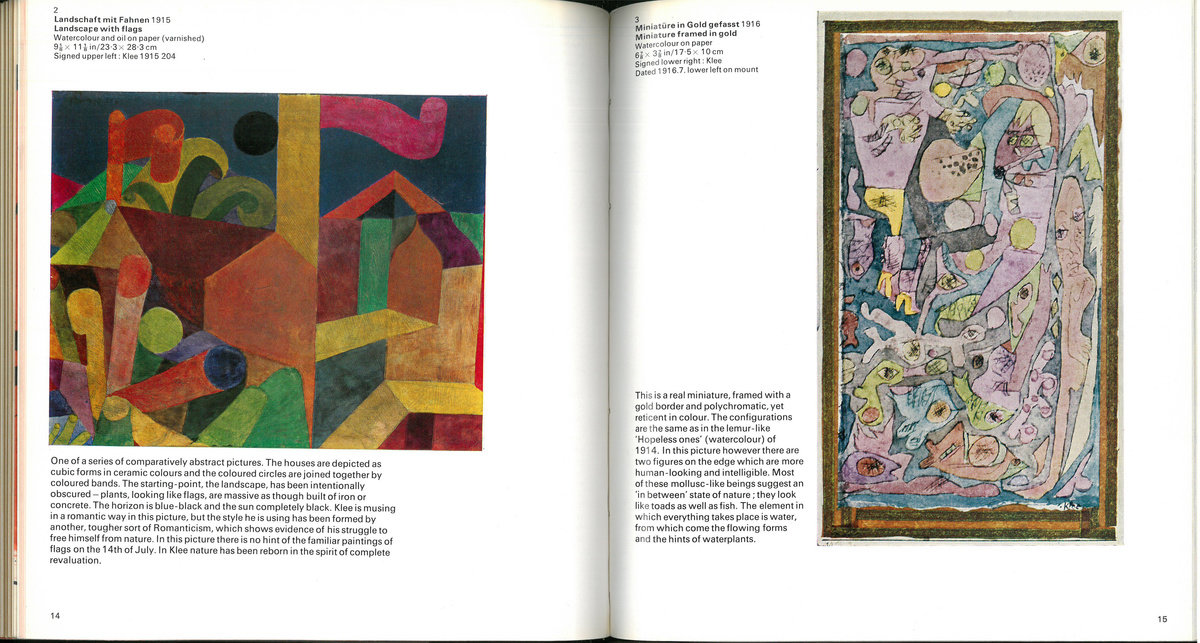
Inside spread from the exhibition catalogue for Paul Klee, June - July 1966, Marlborough Fine Art, London.
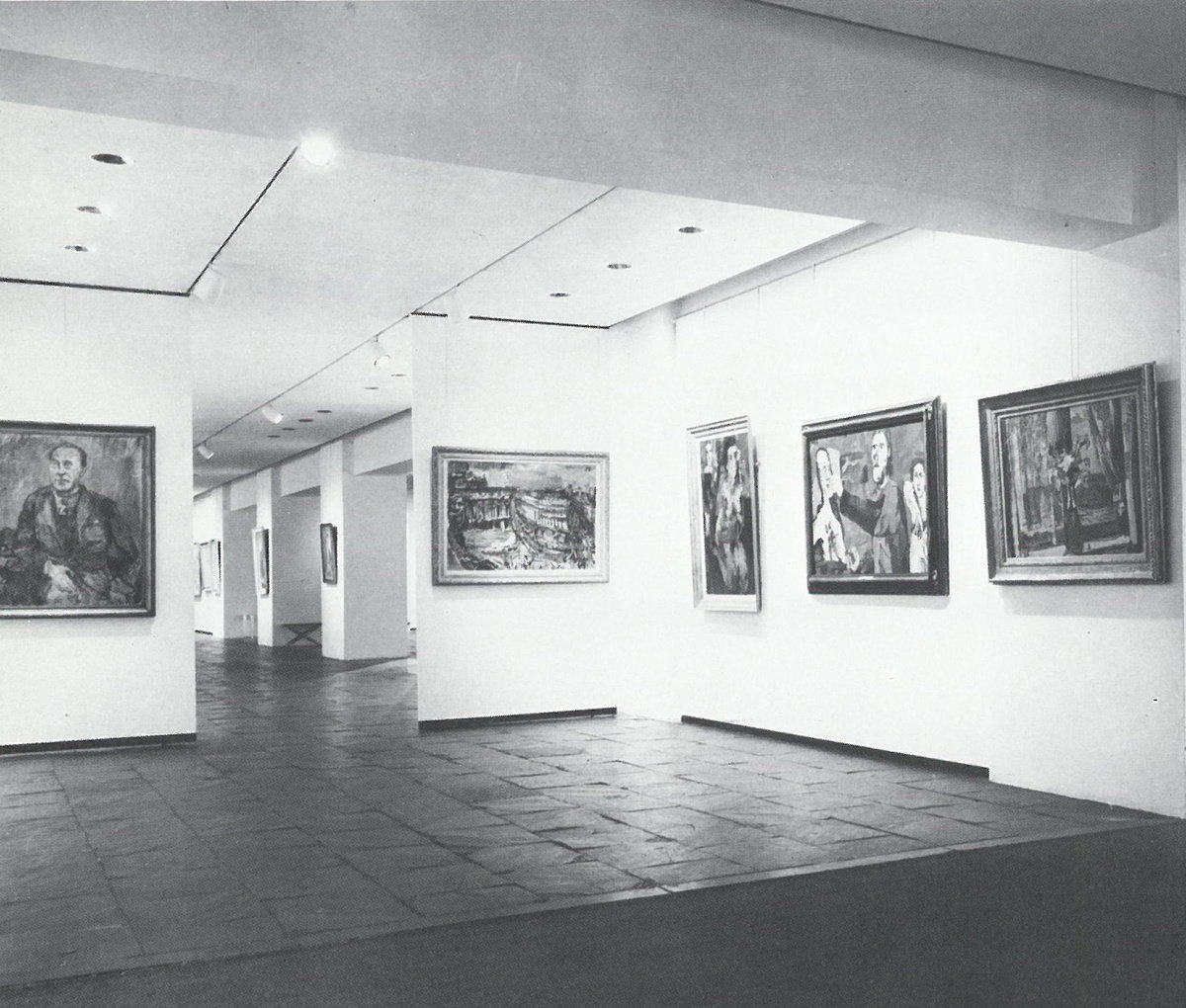
Installation view of Oskar Kokoshka’s exhibition, Homage to Kokoschka, October - November 1966, Marlborough-Gerson in New York.
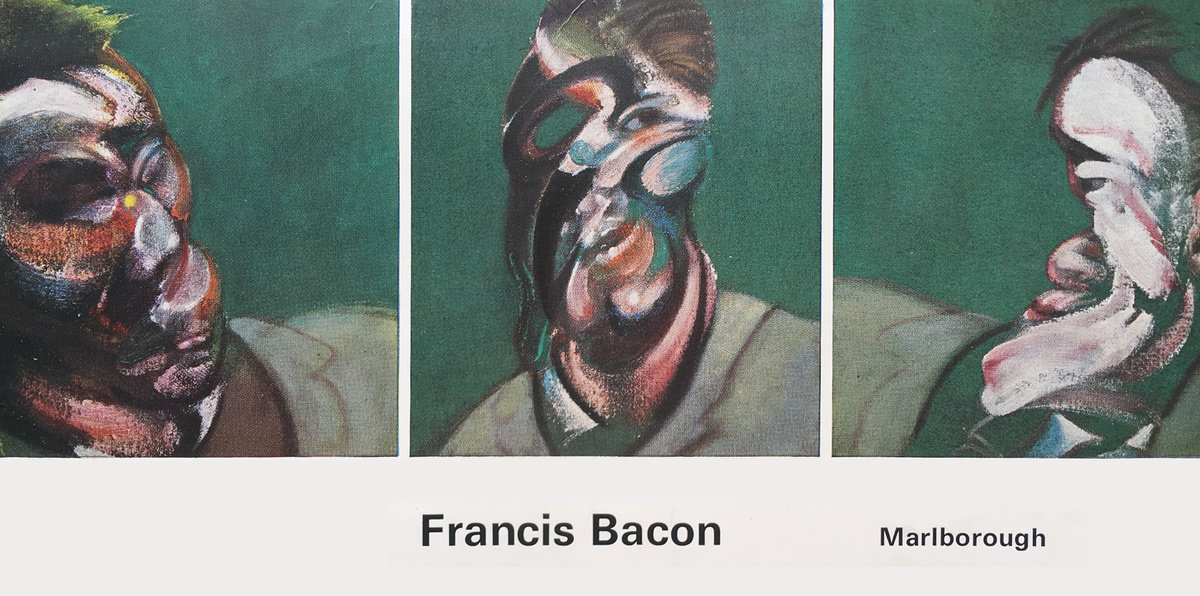
Exhibition invite for Francis Bacon: New Paintings, March 8 - April 14, 1967, Marlborough New London Gallery.
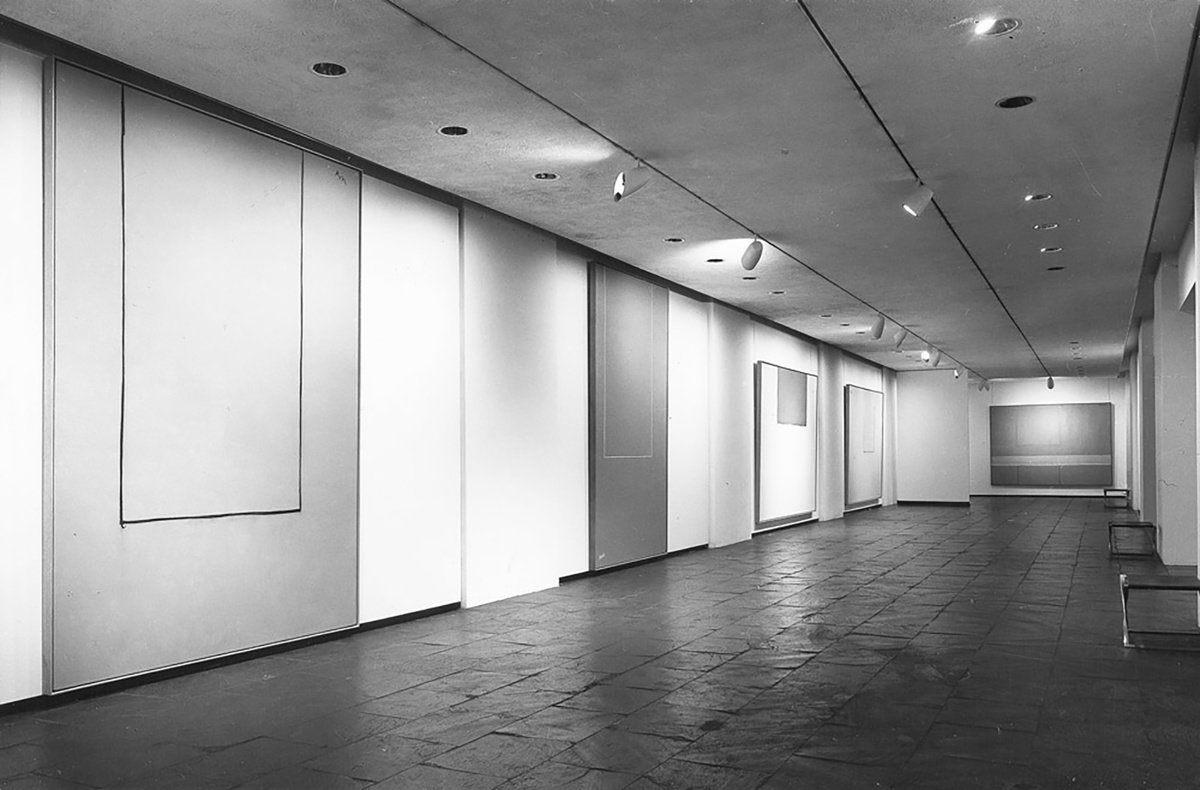
Installation view of Robert Motherwell: Open Series 1967–1969, May 13 - June 7, 1969, Marlborough-Gerson Gallery, New York. The exhibition featured fourteen large new paintings, announcing a major new direction in Motherwell’s work.
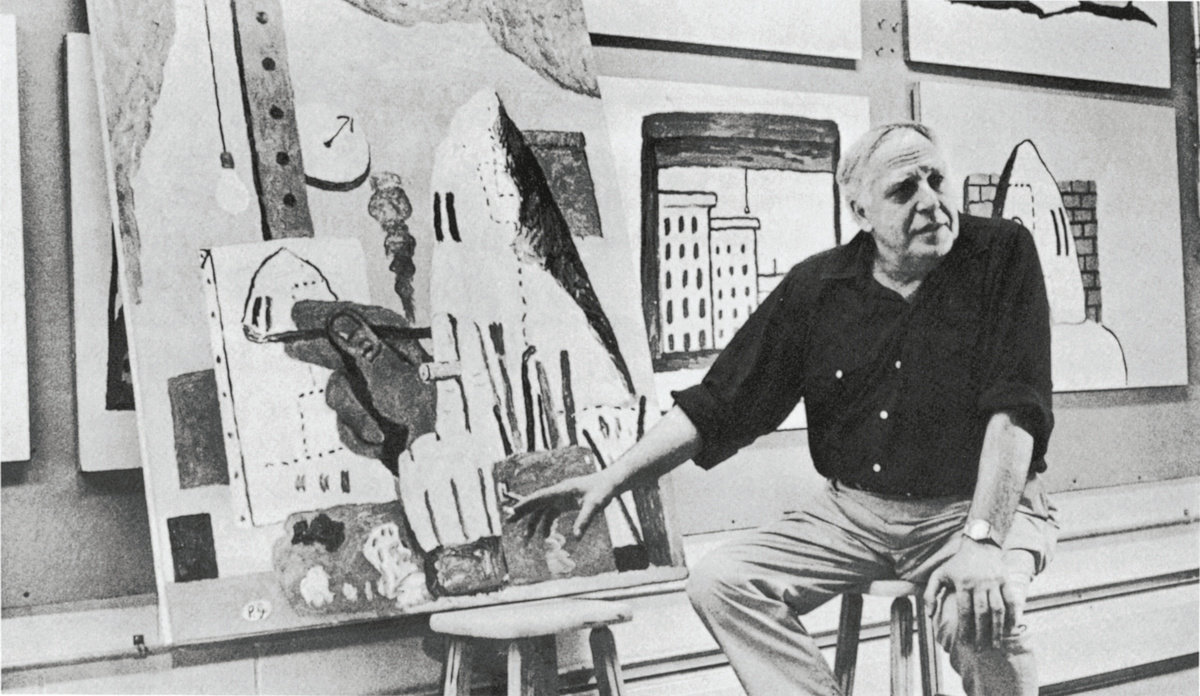
Philip Guston in his studio in 1970. Photo: Frank Lloyd.
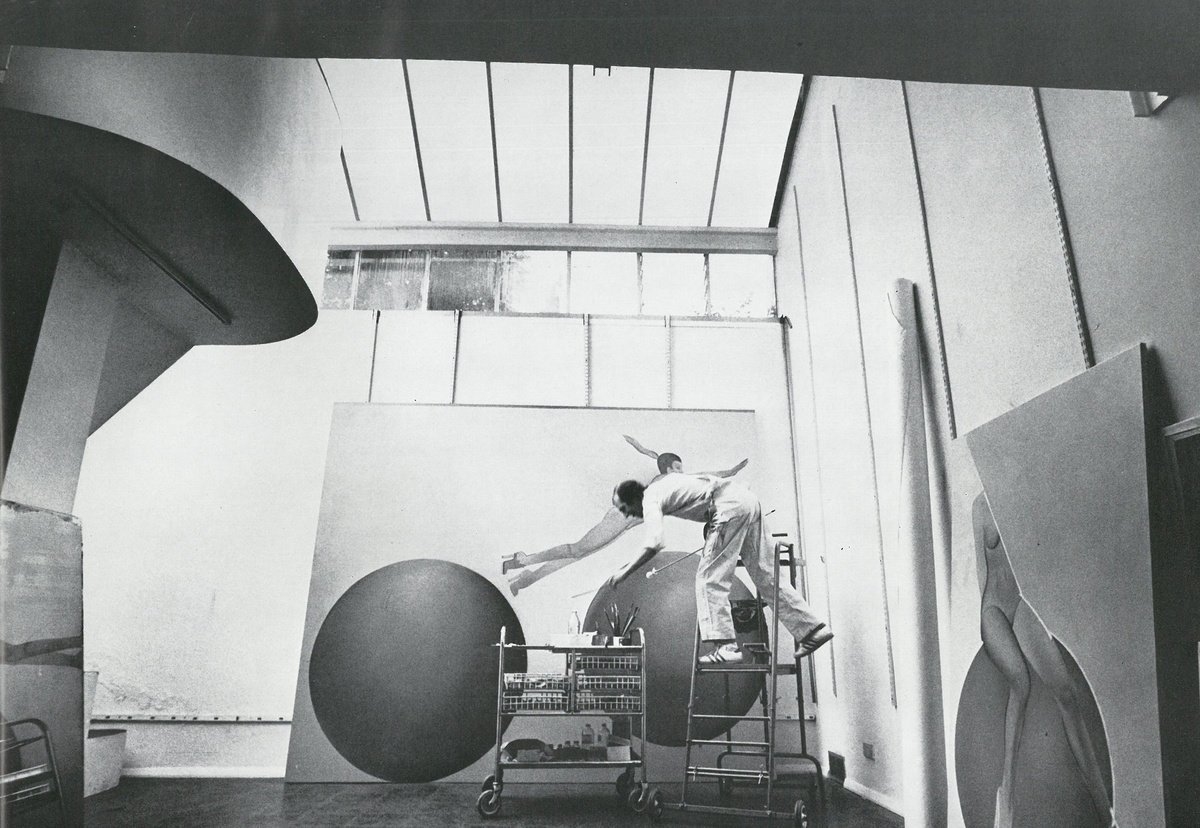
Allen Jones working in his studio, c. 1971. Image published in exhibition catalogue for Allen Jones: New Paintings and Sculptures, September 5 - 28, 1972, Marlborough Fine Art, London.
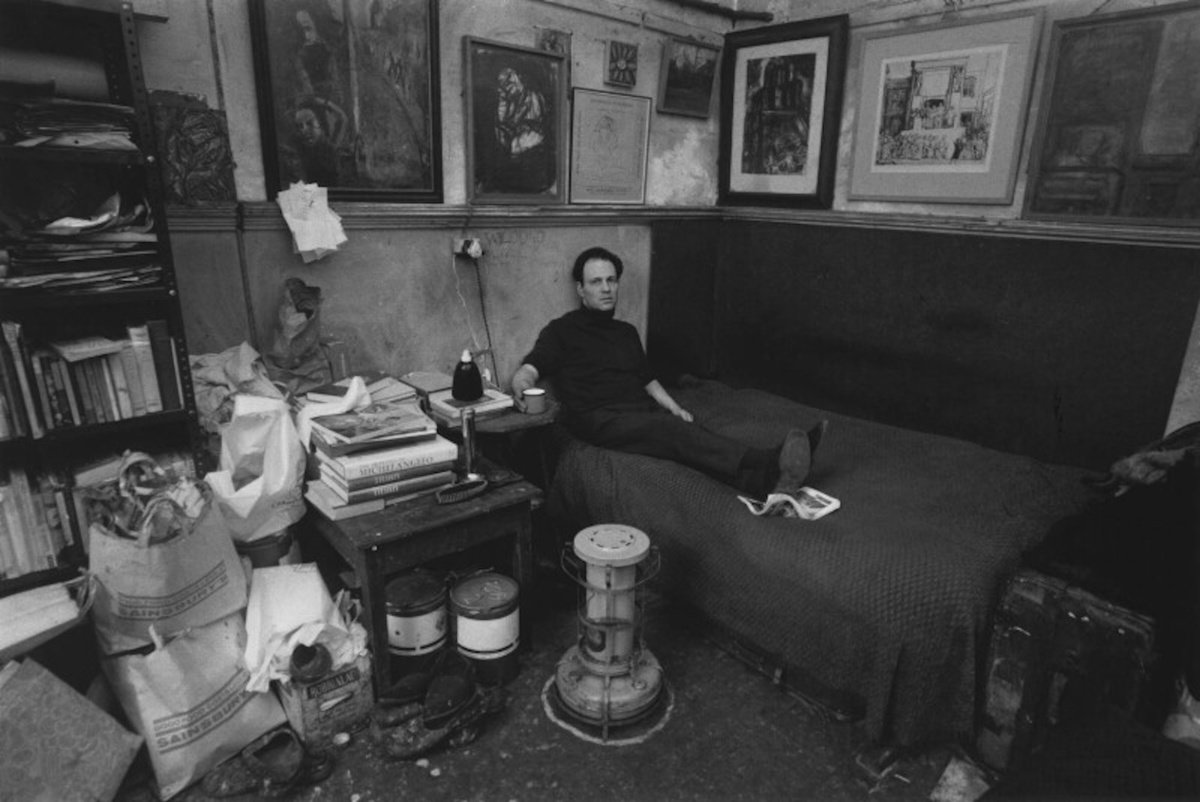
Frank Auerbach in his studio, London, 1972. Photo: Estate of Bob Collins / National Portrait Gallery, London.
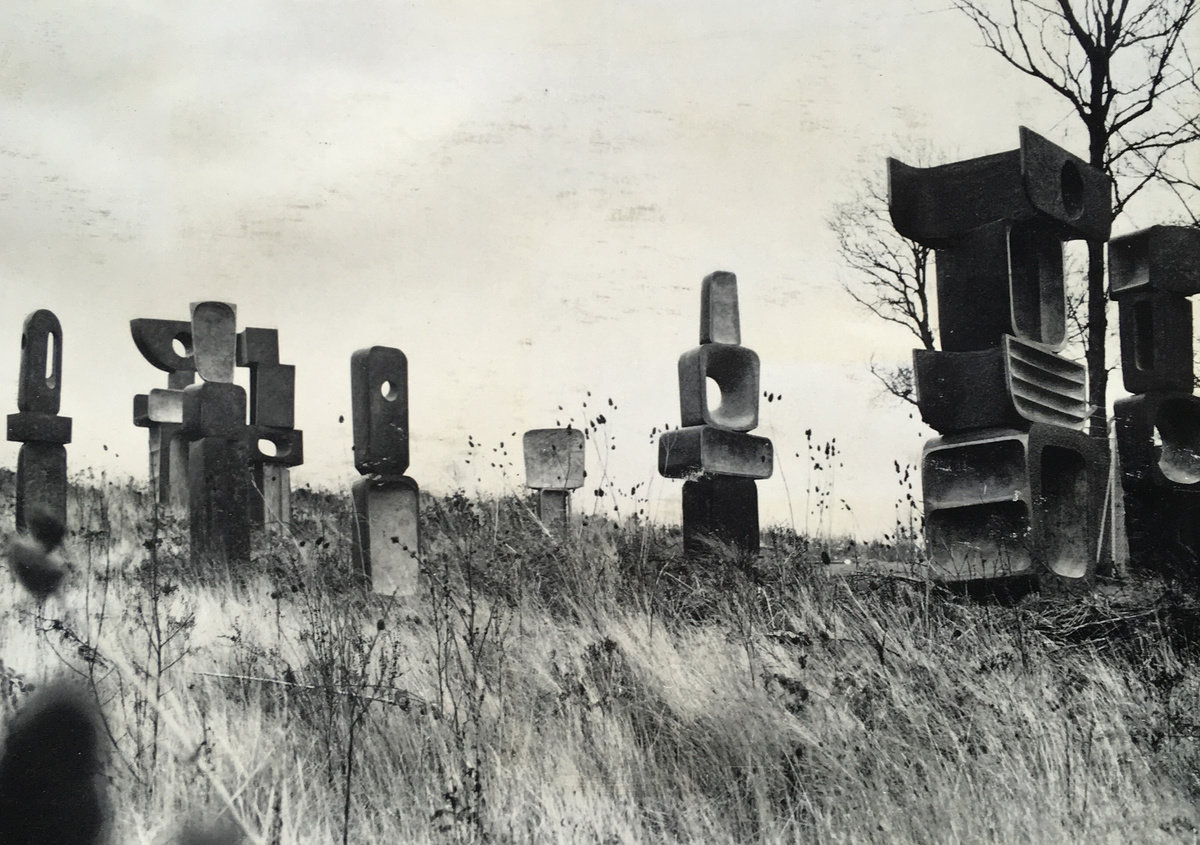
In April 1972, Marlborough Fine Art, London opened British sculptor Barbara Hepworth’s exhibition of new and radically-conceived works, The Family of Man – Nine Bronzes and Recent Carvings.
Exhibition invite for Barbara Hepworth: The Family of Man – Nine Bronzes and Recent Carvings, April 1972, Marlborough Fine Art, London.
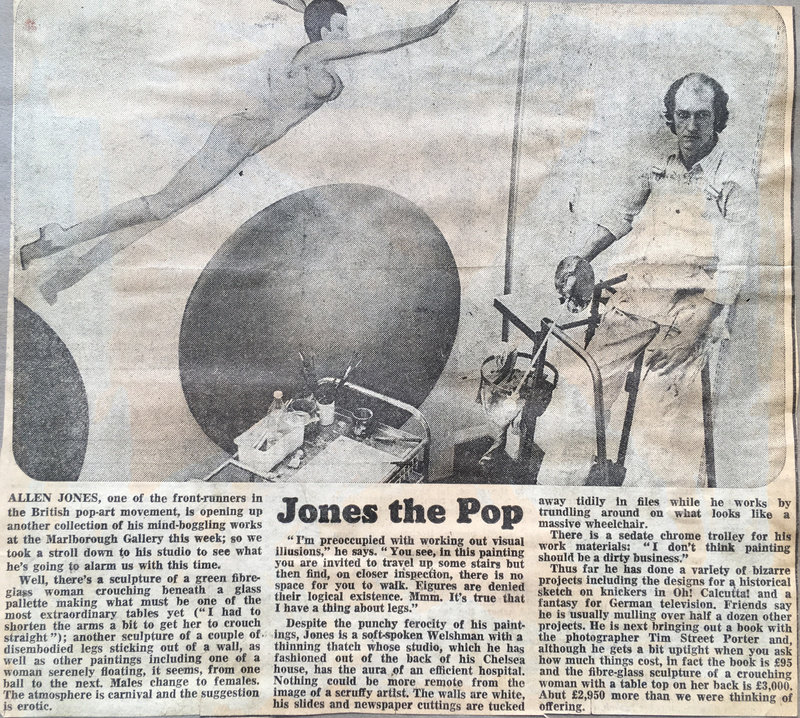
Allen Jones: New Paintings and Sculptures featured in ‘Jones the Pop,’ published in Sunday Times, September 9, 1972.
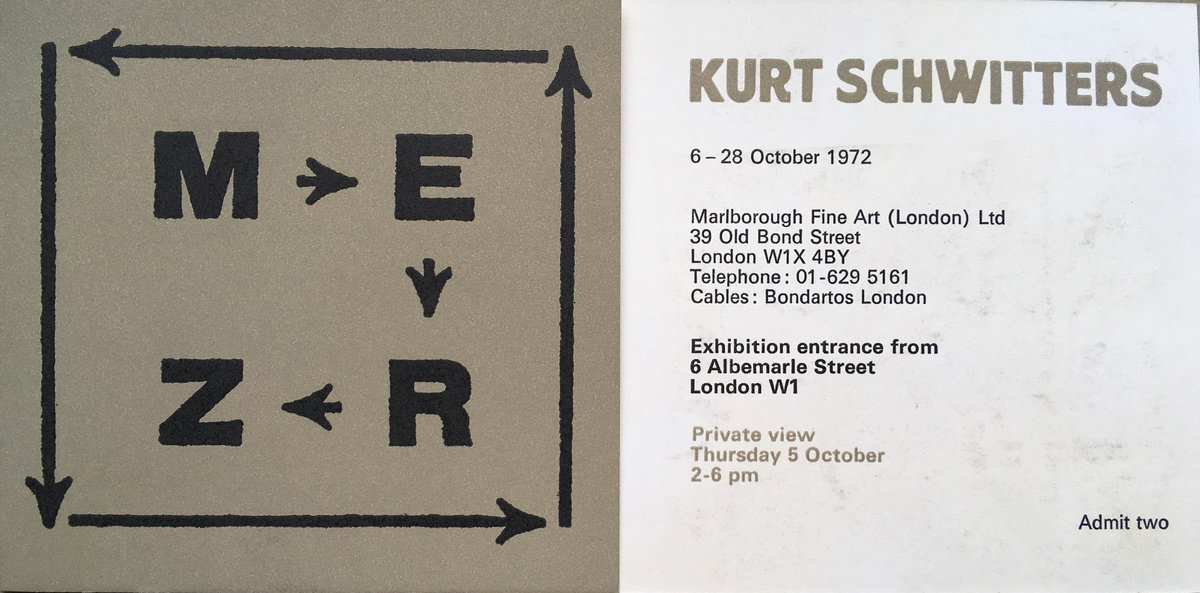
Exhibition invite for Kurt Schwitters: Merz, October 6 - 28, 1972, Marlborough Fine Art, London.
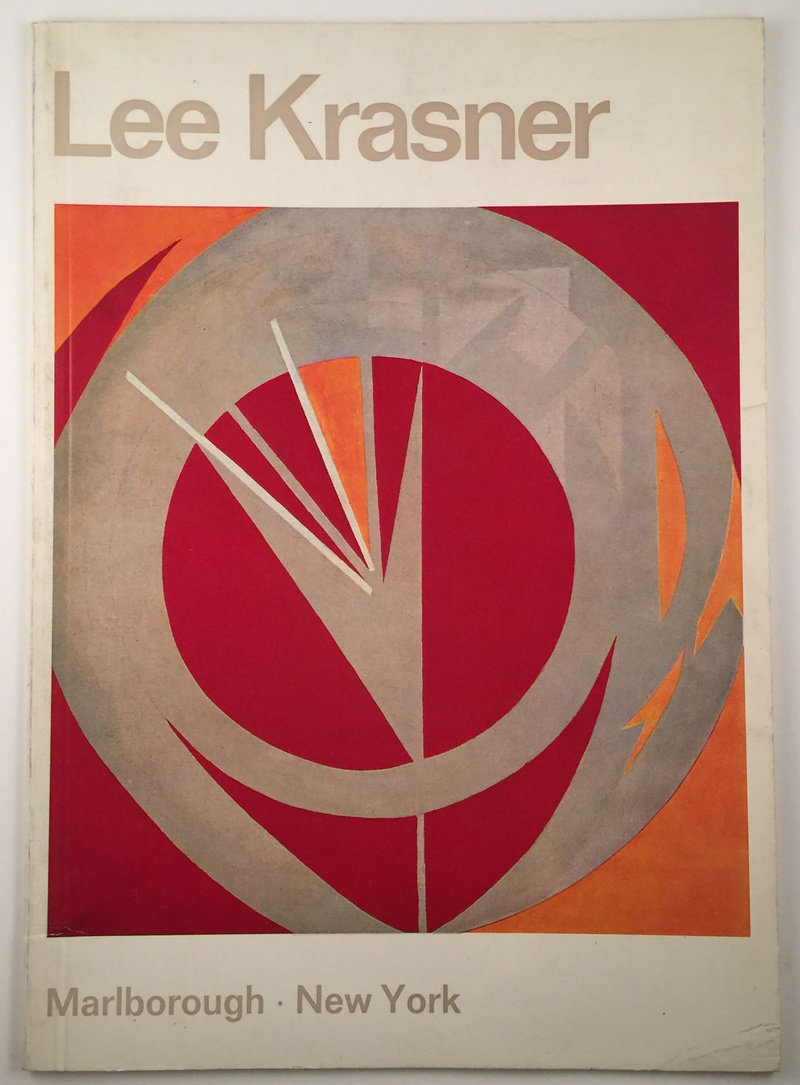
Exhibition catalogue for Lee Krasner: Recent Paintings, April - May, 1973, Marlborough Gallery, New York.
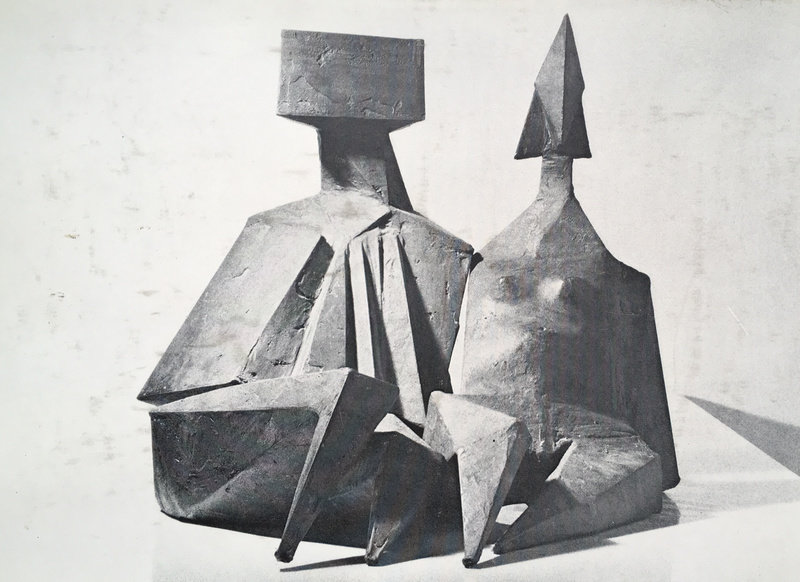
Exhibition invite for Lynn Chadwick: Recent Sculptures, January 16 - February 9, 1974, Marlborough Fine Art, London.
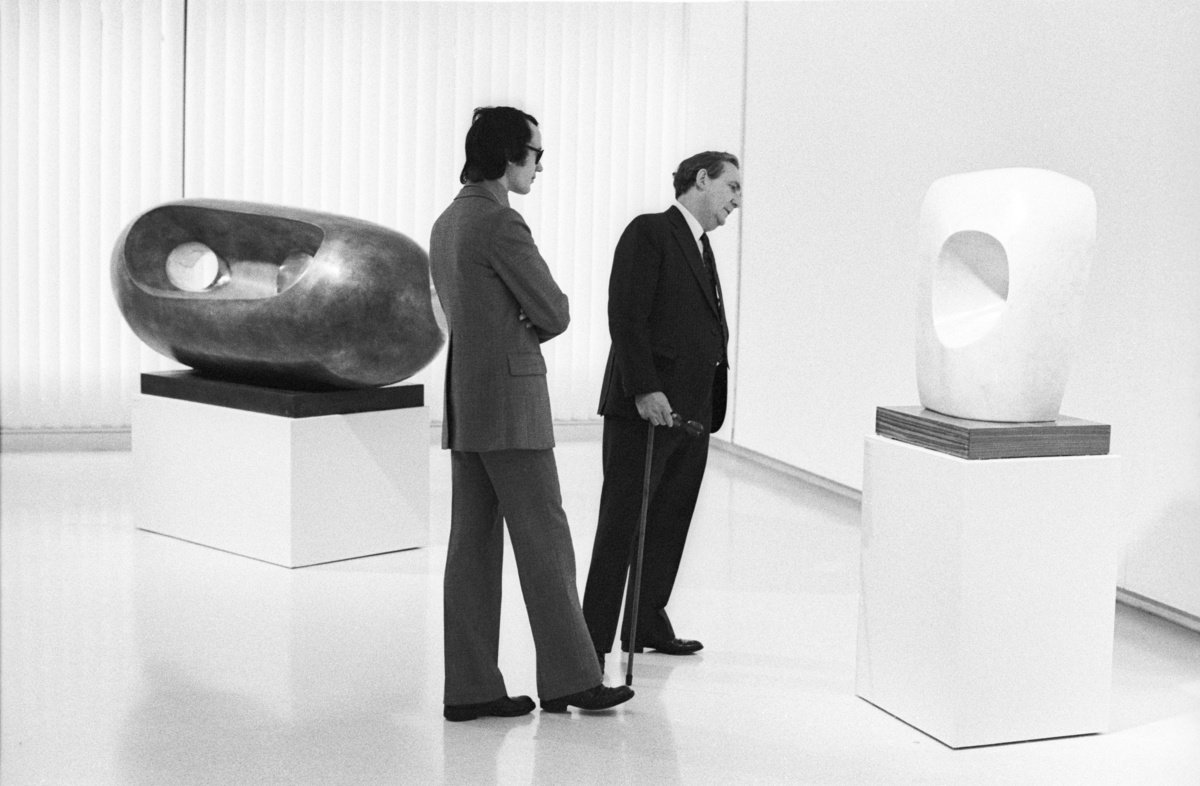
Visitors at Barbara Hepworth’s exhibition, Conversations, March - April 1974 at Marlborough Gallery, New York. Photo: Gilbert Lloyd.

In his lifetime, Francis Bacon presented two retrospectives at the Tate Gallery in London, both of which traveled to several European museums. Bacon also enjoyed a successful retrospective at the Grand Palais in Paris, France, in 1971–72, and mounted his most important solo museum exhibition, Paintings from 1968 to 1974, at The Metropolitan Museum of Art, New York in 1975.
Frank Lloyd, Gilbert Lloyd and Francis Bacon leaving The Metropolitan Museum of Art, New York, in 1975.
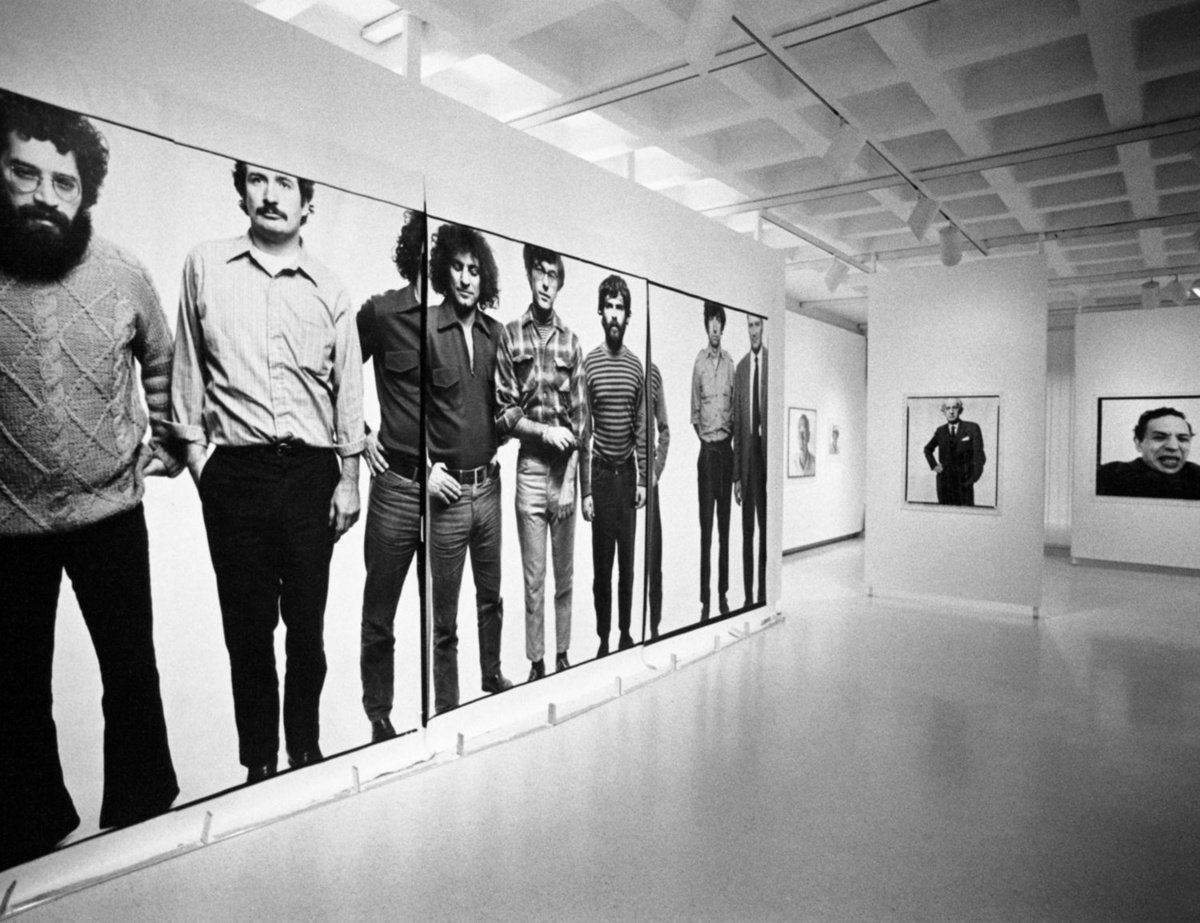
Installation view of Richard Avedon: Portraits, September - October, 1975, Marlborough Gallery, New York.
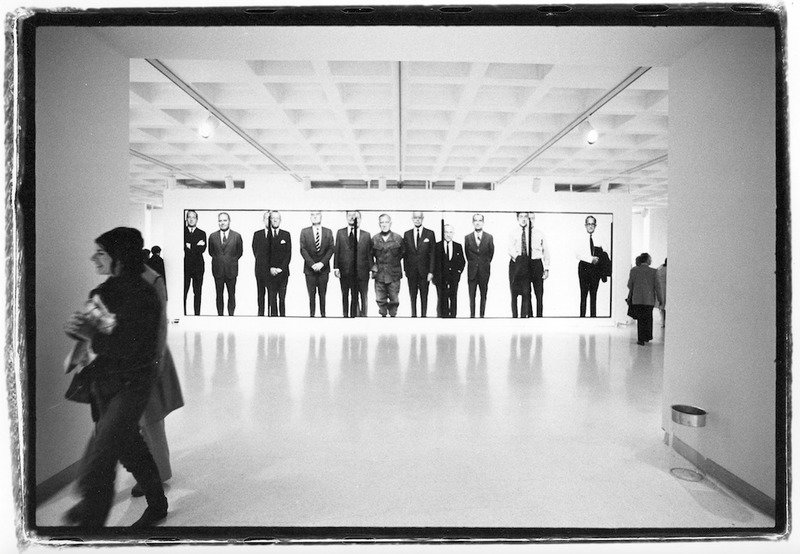
Installation view of Richard Avedon: Portraits, September - October, 1975, Marlborough Gallery, New York.
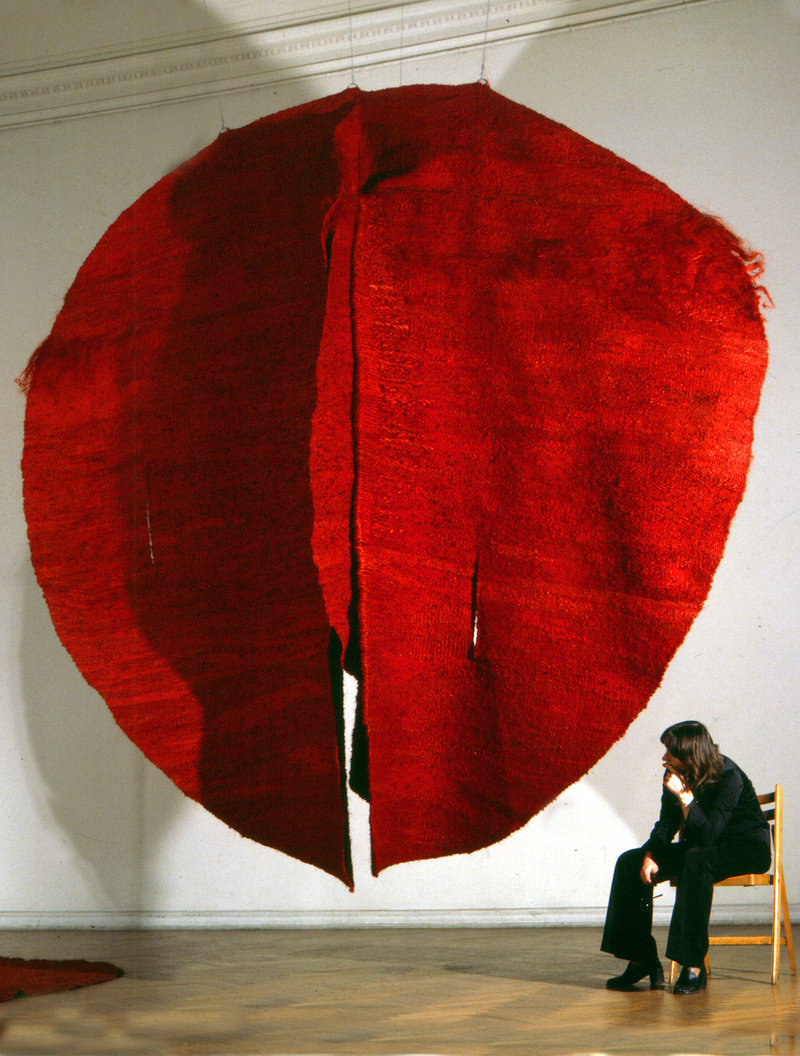
Magdalena Abakanowicz with Red Abakan, 1969. Photo: Jan Nordhal, Zacheta, 1975.
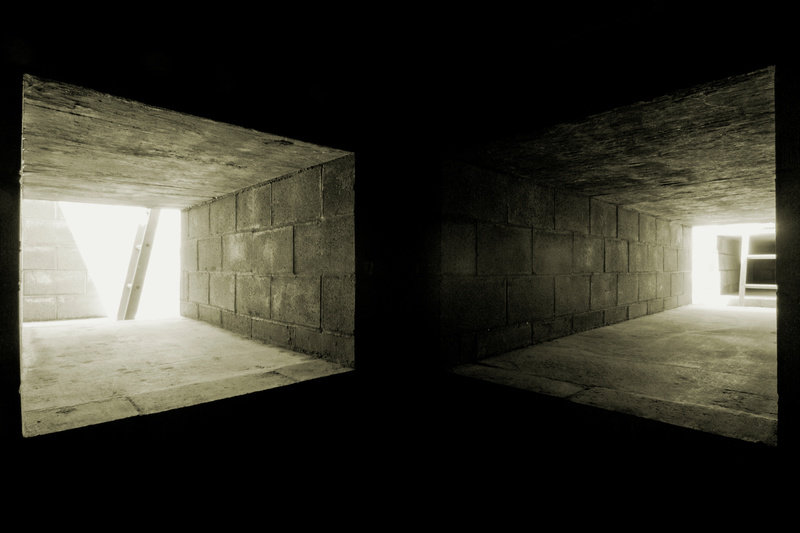
Interior view of Alice Aycock's A Simple Network of Underground Wells and Tunnels, 1975/2011, concrete, wood, earth, approximately 28 x 50 x 9 deep. The work was originally sited at Merriewold West, Far Hills, New Jersey and was permanently reconstructed in 2011 at The Fields Omi/Architecture Omi, Ghent, New York. Photo: Dave Rittinger.

Exhibition invite for R.B. Kitaj: Pictures, April 27 - June 4, 1977, Marlborough Fine Art, London.
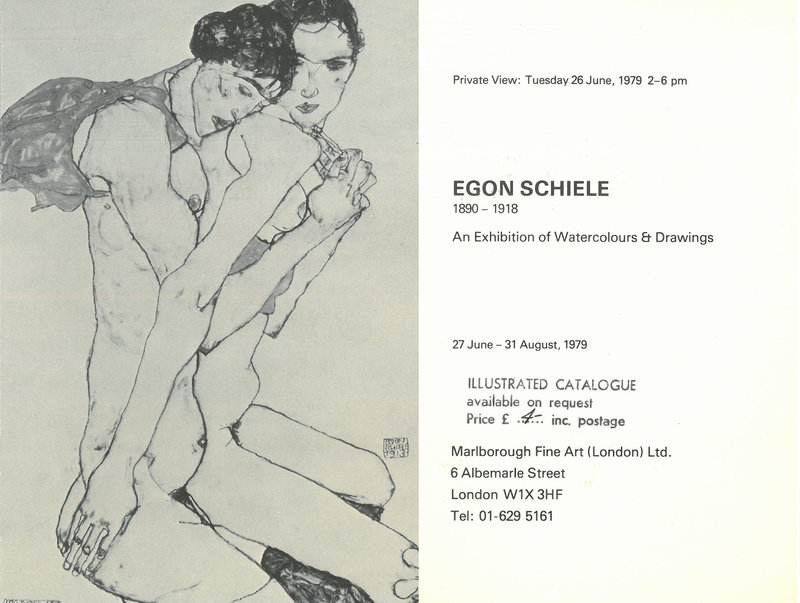
Exhibition invite for Egon Schiele: An exhibition of Watercolours and Drawings, June 27 - August 3, 1979, Marlborough Fine Art, London.
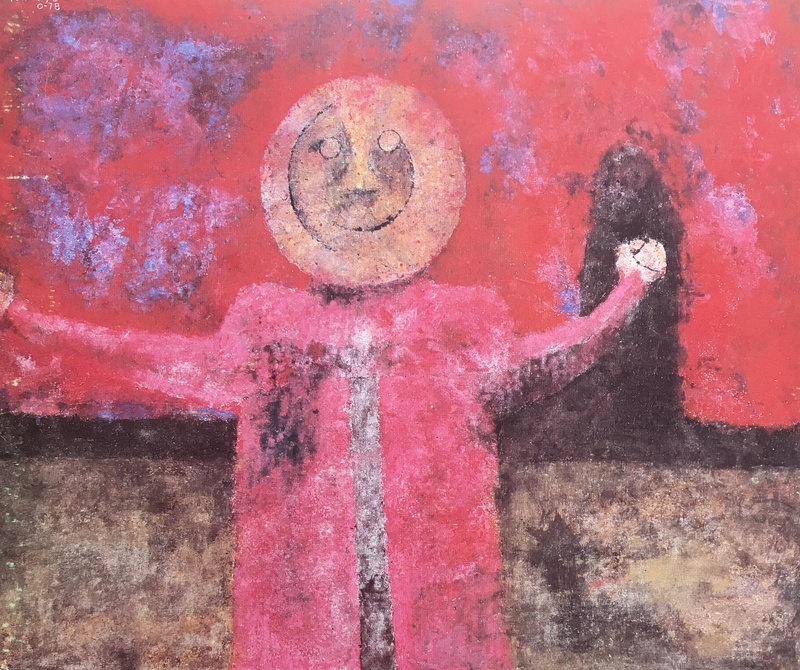
Exhibition invite for Rufino Tamayo, October 1979, Marlborough Fine Art, London.
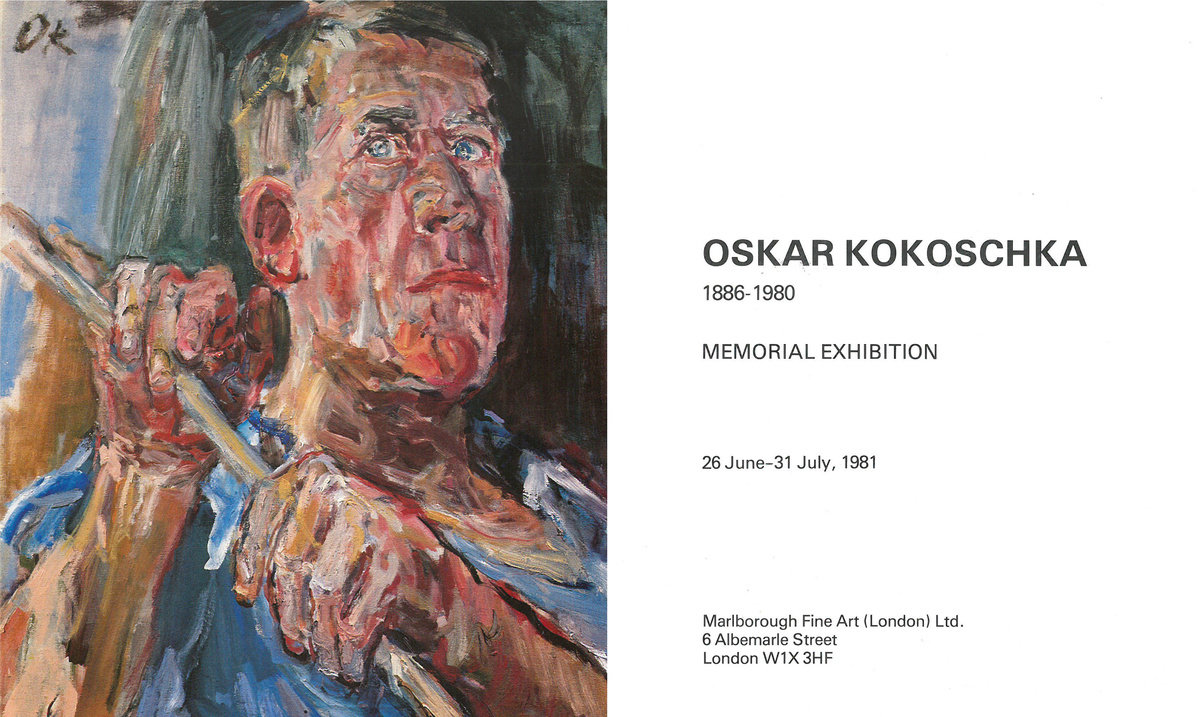
Exhibition invite for Oskar Kokoschka: Memorial Exhibition, June 26 - July 31, 1981, Marlborough Fine Art, London. Image: Oskar Kokoschka, Self Portrait (Fiesole), 1948.
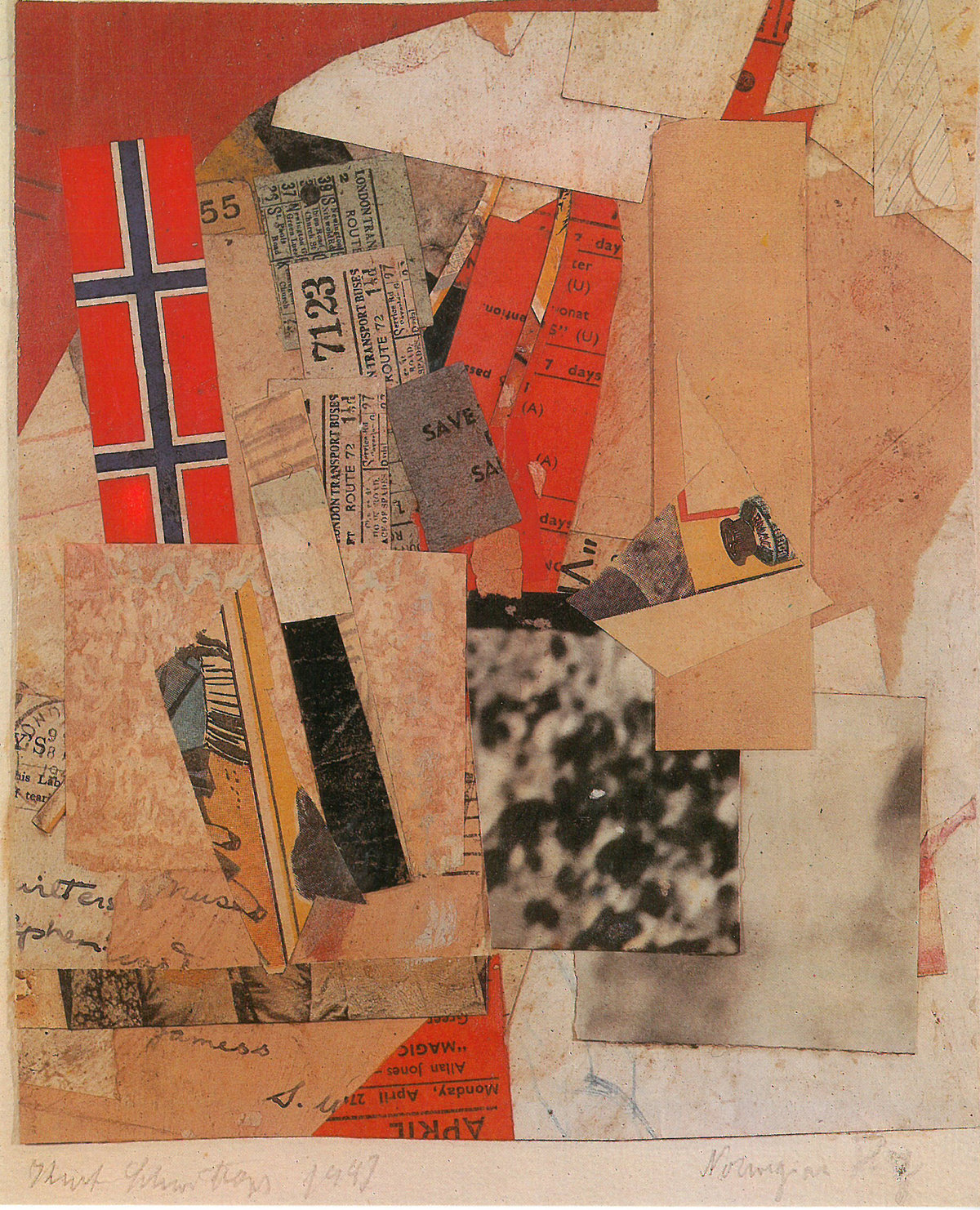
Marlborough’s groundbreaking 1981 exhibition, Kurt Schwitters in Exile: The Late Work, 1937–1948, proved essential in reshaping the public opinion of Schwitters as a key figure in modern art. The exhibition included the artist’s late paintings, assemblages and collages, created in Norway and England, which reflected an intact sense of playfulness, as well as elements of frailty and graveness. The exhibition catalogue included an in-depth account of Schwitter’s life in Britain with contributions by Professor Werner Schmalenbach and Anni Albers.
Exhibition invite for Kurt Schwitters in Exile: The Late Work, 1937–48, October 2 - 31, 1981, Marlborough Fine Art, London.
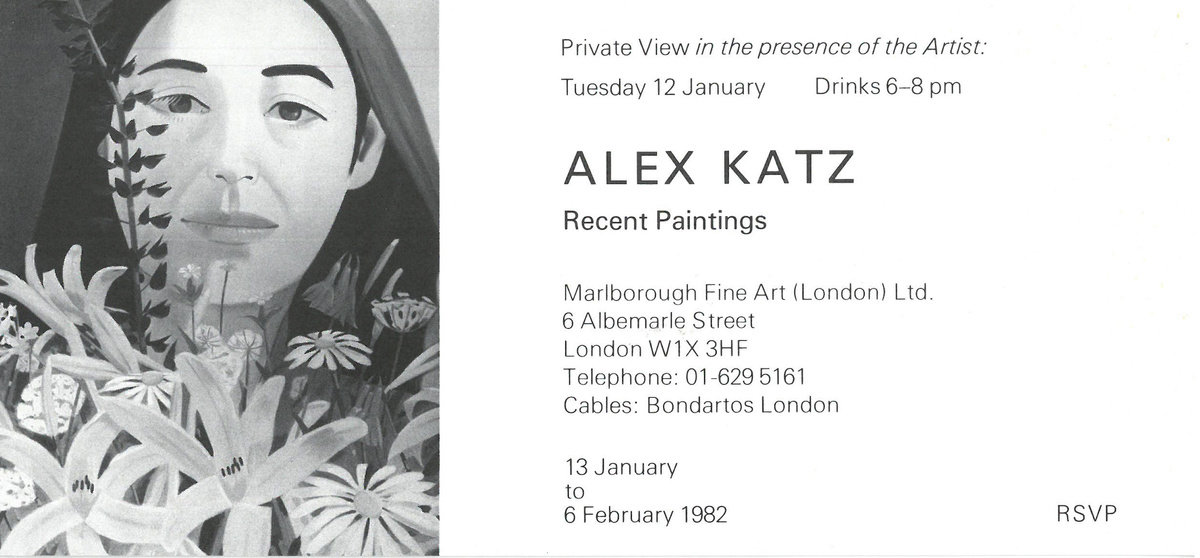
Exhibition invite for Alex Katz: Recent Paintings, January 13 - February 6, 1982, Marlborough Fine Art, London.
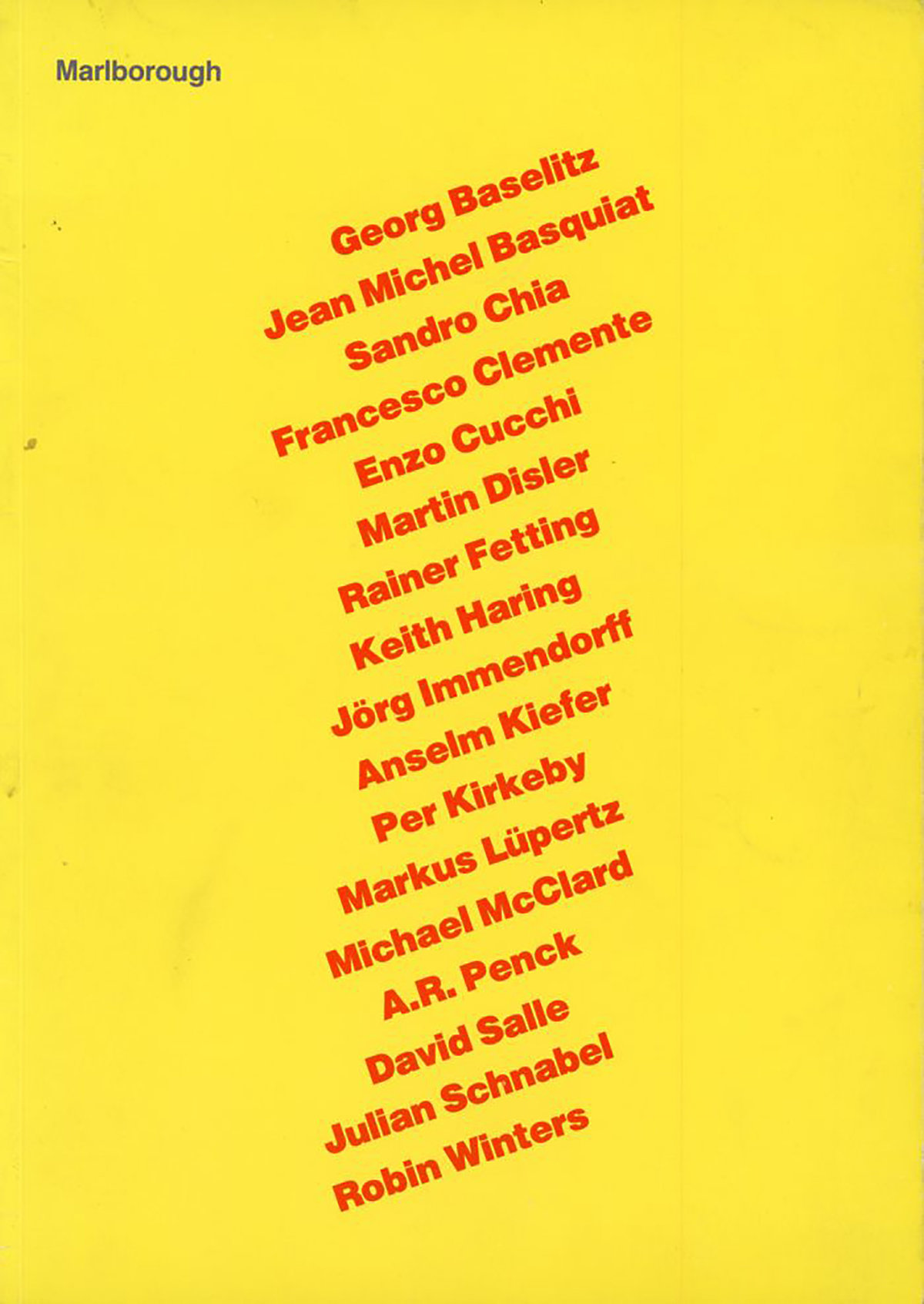
Exhibition catalogue for The Pressure to Paint, curated by Diego Cortez, June - July, 1982, Marlborough Gallery, New York.
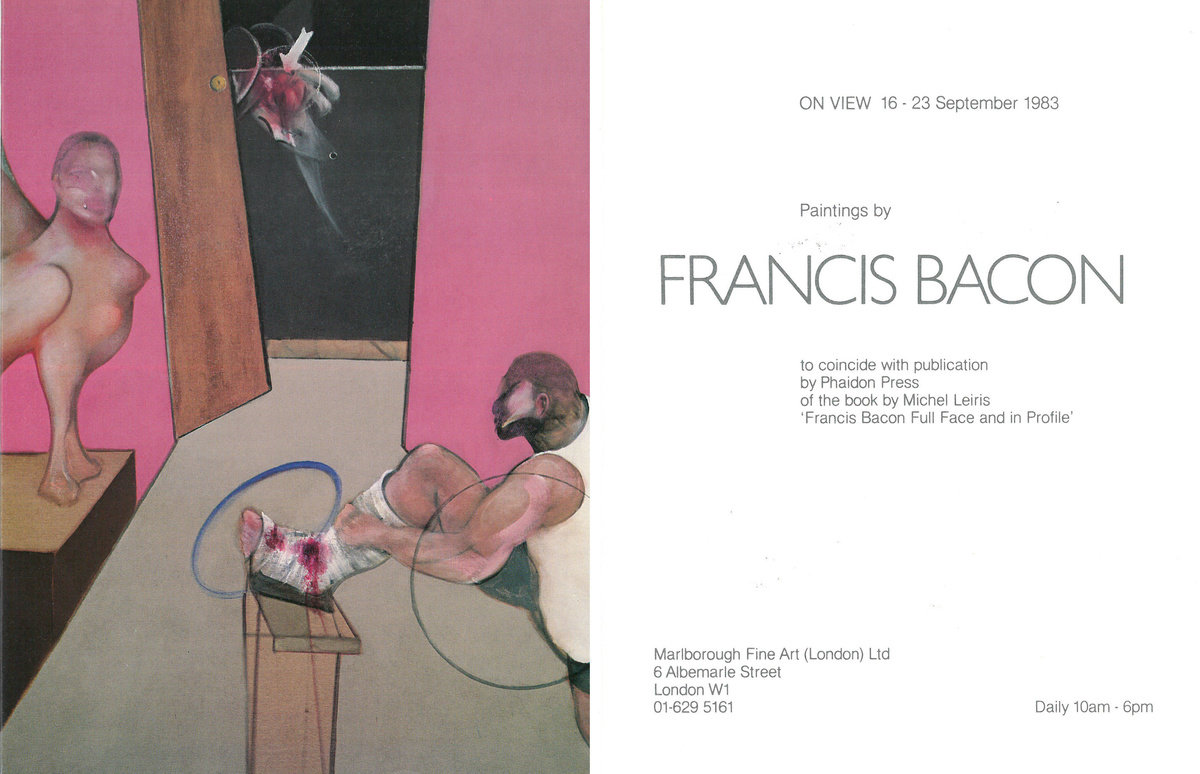
Exhibition invite for Paintings by Francis Bacon, September 16 - 23, 1983, Marlborough Fine Art, London. Image: Francis Bacon, Oedipus and the Sphinx after Ingres, 1982-1983.
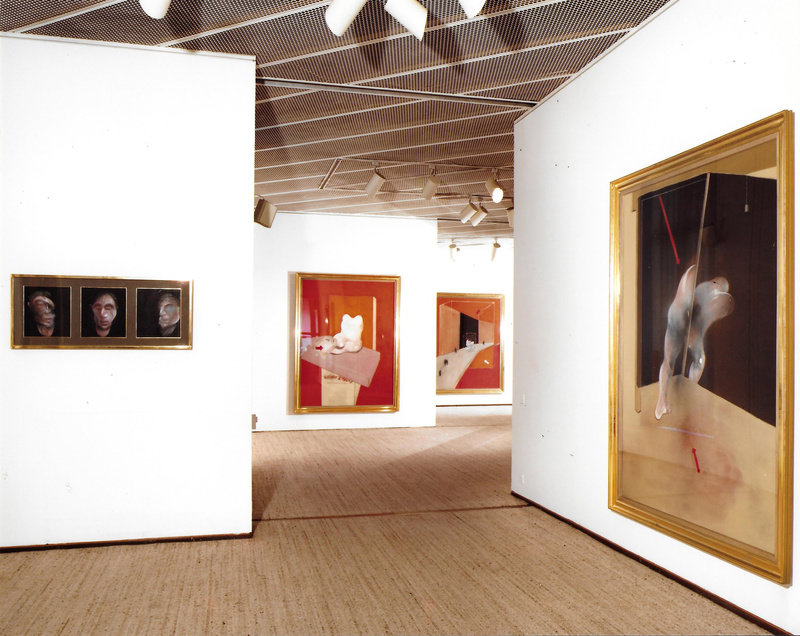
Installation view of Paintings by Francis Bacon, September 16 - 23, 1983, at Marlborough Fine Art, London.
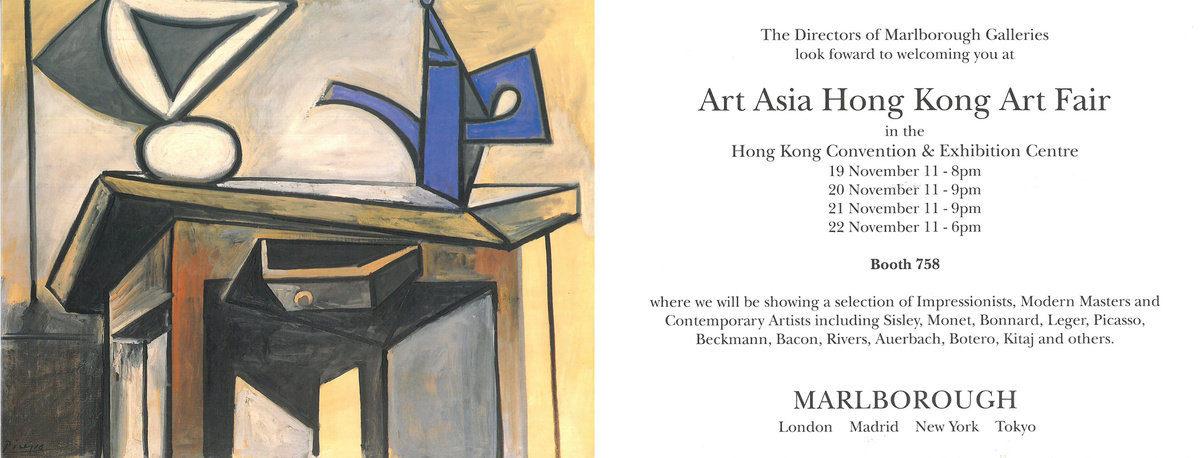
Announcement of Marlborough’s participation in Art Asia Hong Kong Art Fair, November 1983. Image: Pablo Picasso, Still life with Pitcher, 1947, oil on canvas.
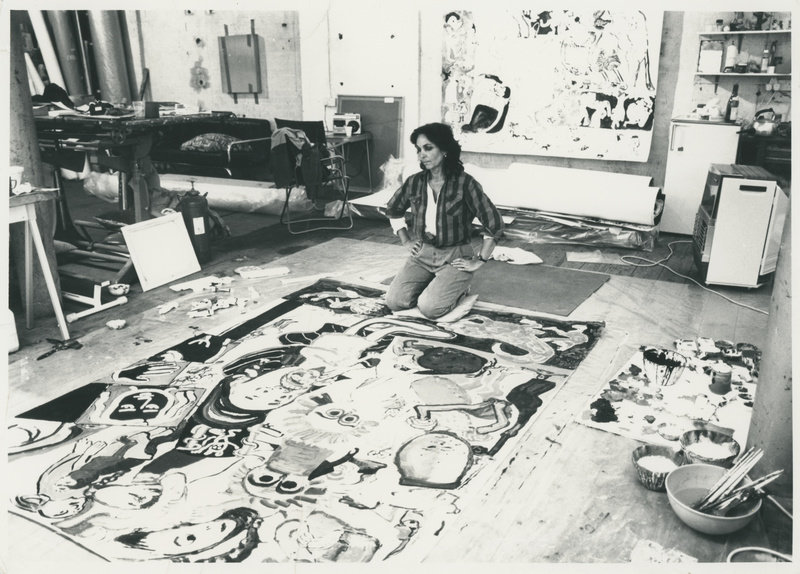
Paula Rego in her studio with her painting, Vivian Girls, 1984. Photo: Irene Rhoden.
“A sculptor needs to be able to see form completely, and you can only understand three-dimensional form with a great deal of experience, effort and struggle. You can only do that if you try to correct yourself on something that you feel as intensely about as the human figure.”
Henry Moore, excerpted from the 1984 exhibition catalogue for Henry Moore: The Reclining Figure, at the Columbus Museum of Art, Columbus, Ohio.

Frank Auerbach’s studio in 1985. Photo: Prudence Cumming Associates.
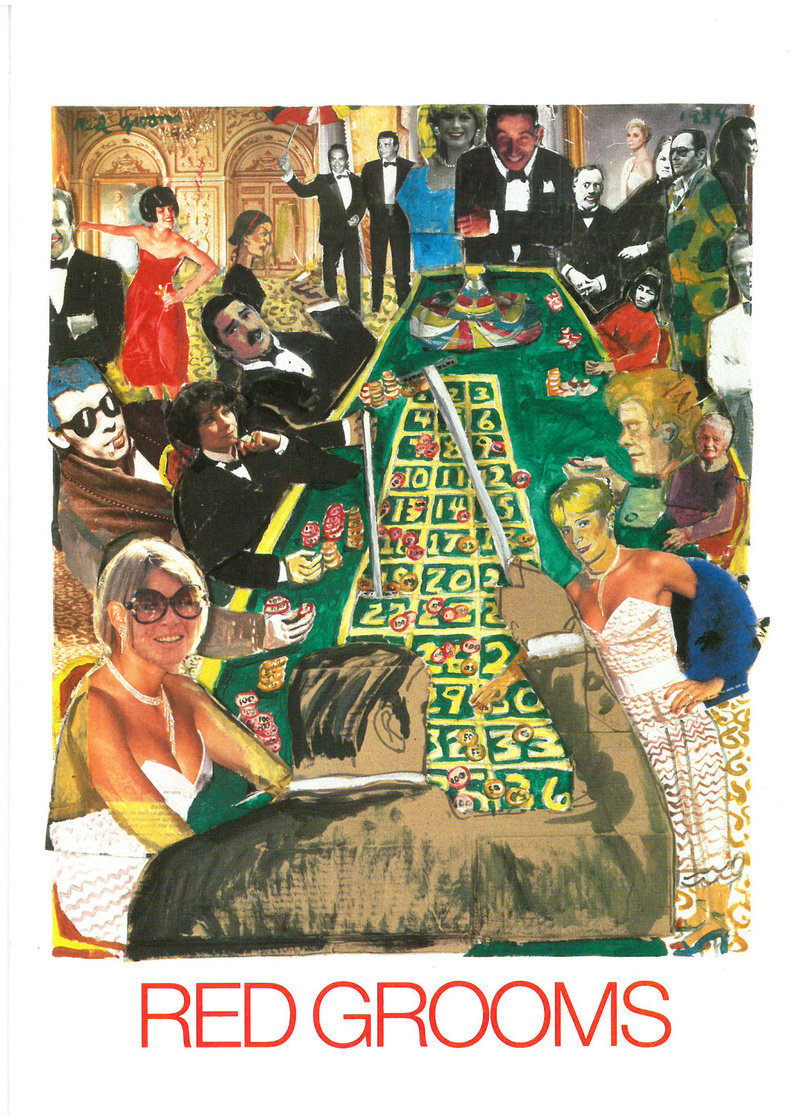
Exhibition invite for Red Grooms: Recent Work, January 21 - 1March 1, 1985, Marlborough Fine Art, London.
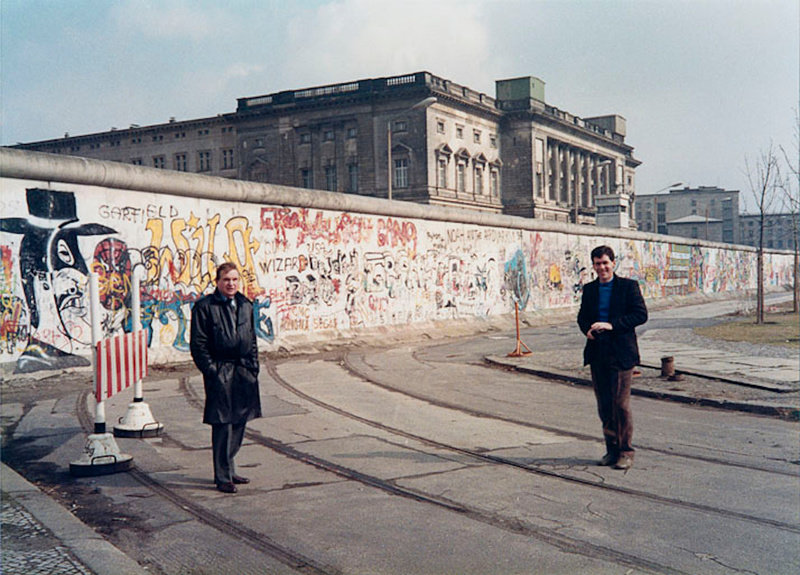
Francis Bacon and John Edwards in Berlin, February 1986. Photo: Gilbert Lloyd.

Frank Auerbach at his exhibition, Recent Paintings and Drawings, held January 7 - February 6, 1987 at Marlborough Fine Art, London.
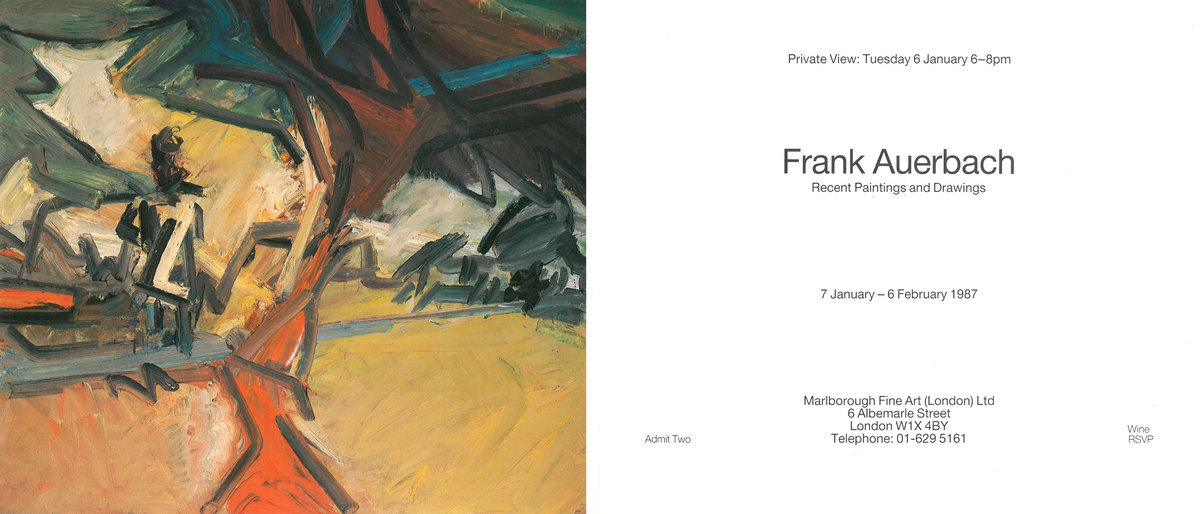
Exhibition invite for Frank Auerbach: Recent Paintings and Drawings, January 7 - February 6, 1987, Marlborough Fine Art, London. Image: Tree on Primrose Hill, 1986, oil on board.
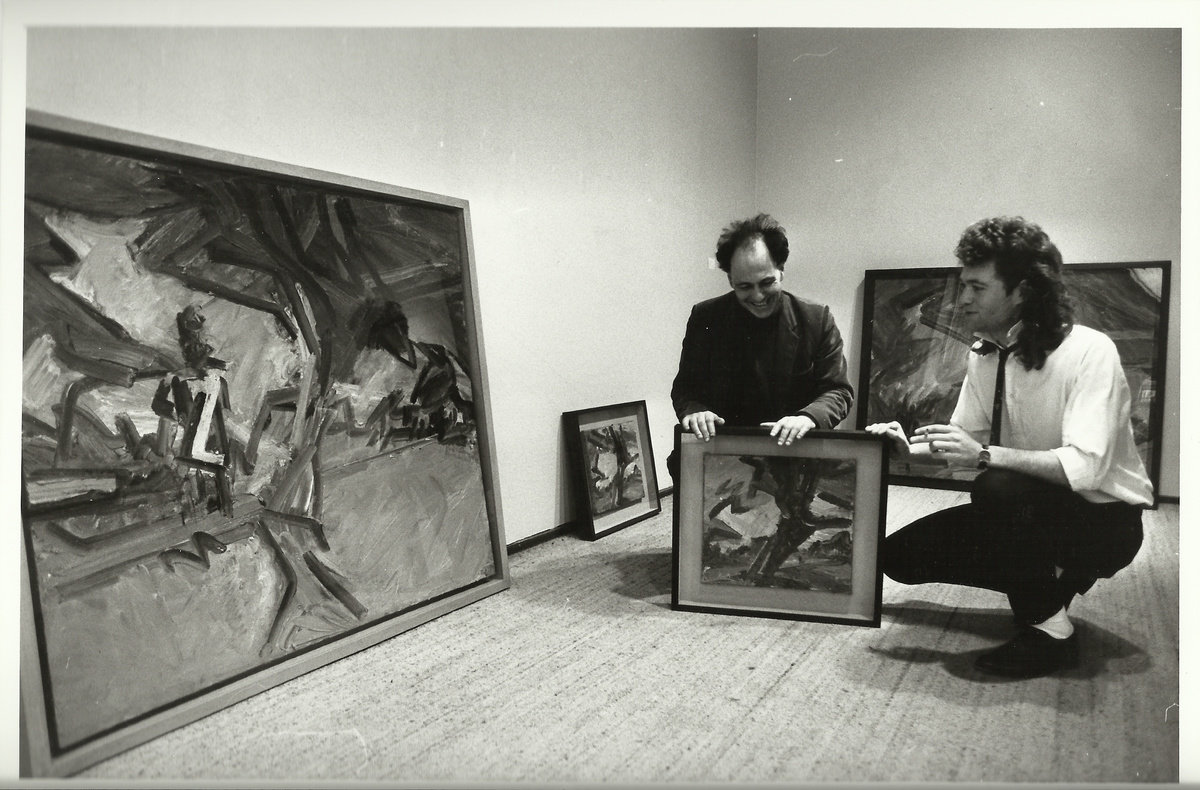
Frank Auerbach and his son Jake installing his exhibition, Recent Paintings and Drawings, held January 7 - February 6, 1987 at Marlborough Fine Art, London.
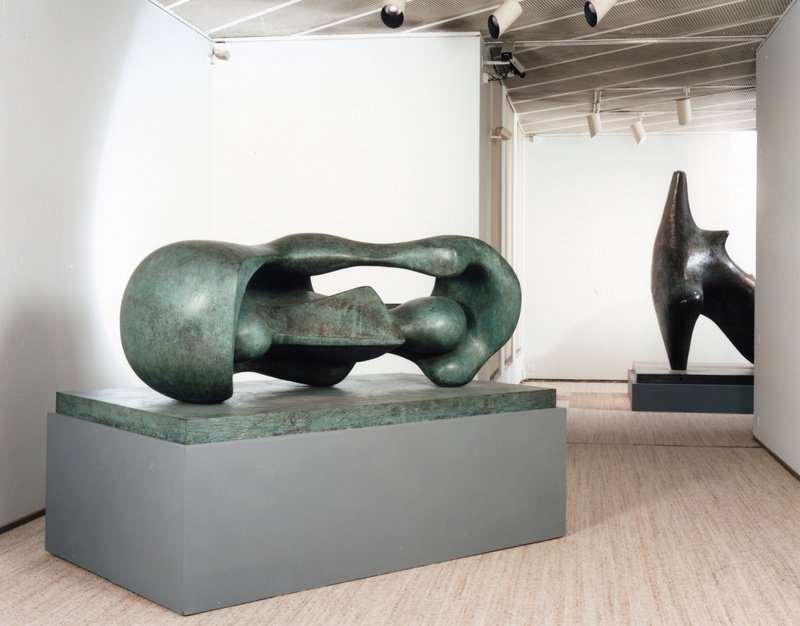
Installation view of Henry Moore’s exhibition, Four Monumental Sculptures, September - October 1988, at Marlborough Fine Art, London.
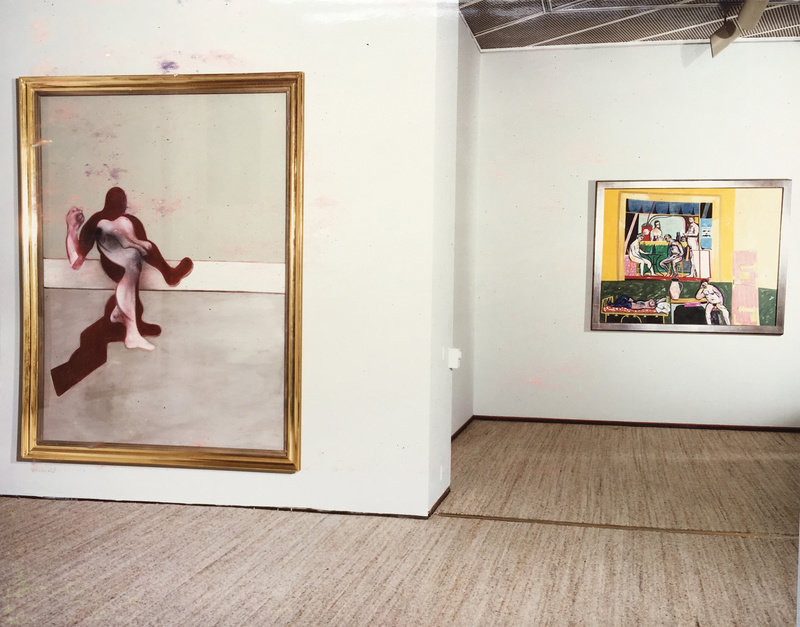
Installation view of New Paintings: Auerbach, Bacon, Kitaj, January 6 - February 10, 1989 at Marlborough Fine Art, London.
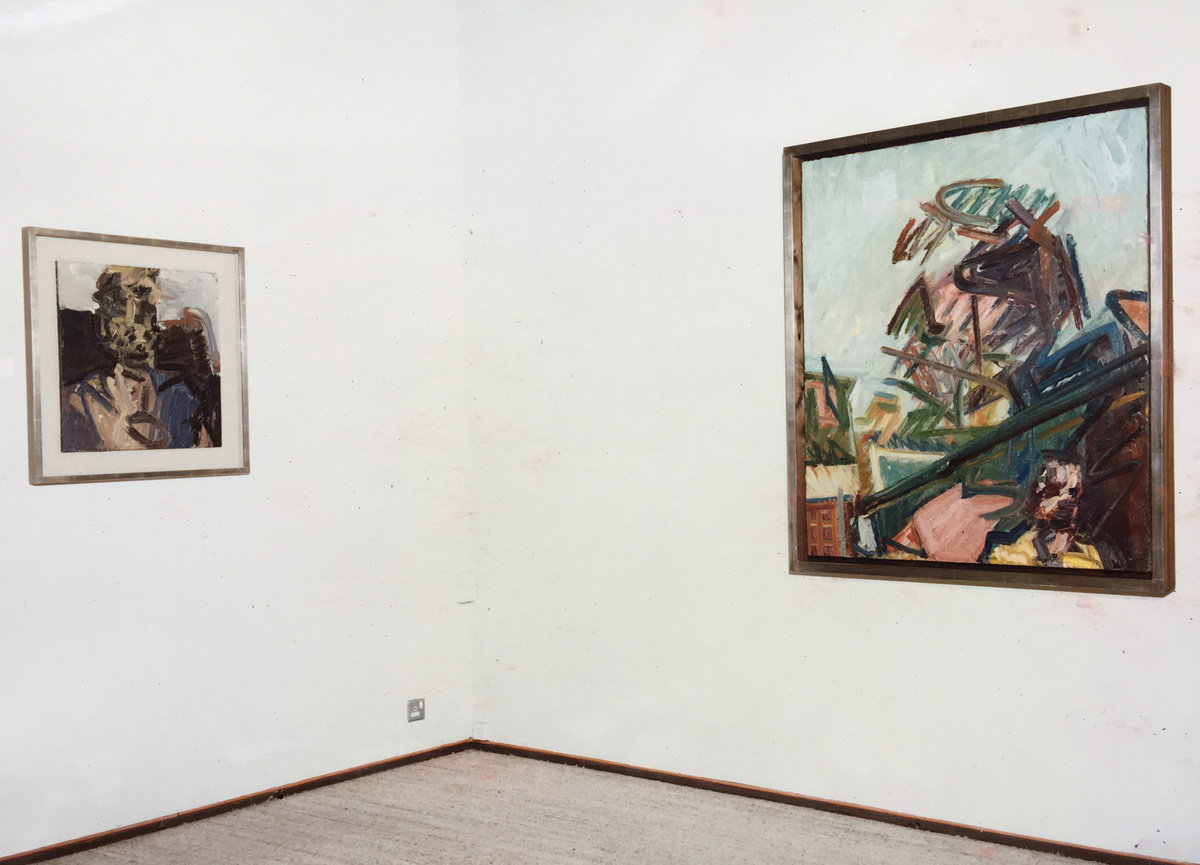
Installation view of Frank Auerbach: Recent Work, September 21 - October 20, 1990, Marlborough Fine Art, London.
"Portraits require at least 150 sittings, and after each but the last session the paint or charcoal is wiped away. And yet, however distantly it is related to the ghosts of all the failures buried within the well-worn canvas or paper, the eventual image emerges in a frenzy of spontaneous zig-zags and gestural curves. Auberach says he does not rule out the possibility that one day he could get the result he wants in a single go, but it seems more likely that freedom to err, ruthless self-questioning and brinkmanship psychologically underwrite his obsessive routine."
David Cohen in Frank Auerback: Recent Work featured in 'The Many Faces of J.Y.M.,' published in RA Magazine, Autumn 1990.

Exhibition invite for Magdalena Abakanowicz, October 31 - November 30, 1990, Marlborough Fine Art, London.
I feel London is this raw thing…This extraordinary, marvellously unpainted city where whenever somebody tries to get something they stop halfway through, and next to it something incongruous occurs.
Frank Auerbach quoted in Robert Hughes, Frank Auerbach, 1990, p. 162.

Ken Kiff's 1991 exhibition Ken Kiff: Recent Works marked the artist's first exhibition at Marlborough. The show explored the artist's self-created mythic world, one both rich and varied and dissident and disquieting. Through a range of media, from drawing to painting and printmaking, the arist used figurative and abstract forms to evoke fantasy stories and myths that explored the human condition. In 1991, the artist was elected a Royal Academician. His work from his residency at the National Gallery in London was later exhibited there in 1993.
Installation view of Ken Kiff: Recent Works, June 7- July 6,1991, Marlborough Fine Art, London.
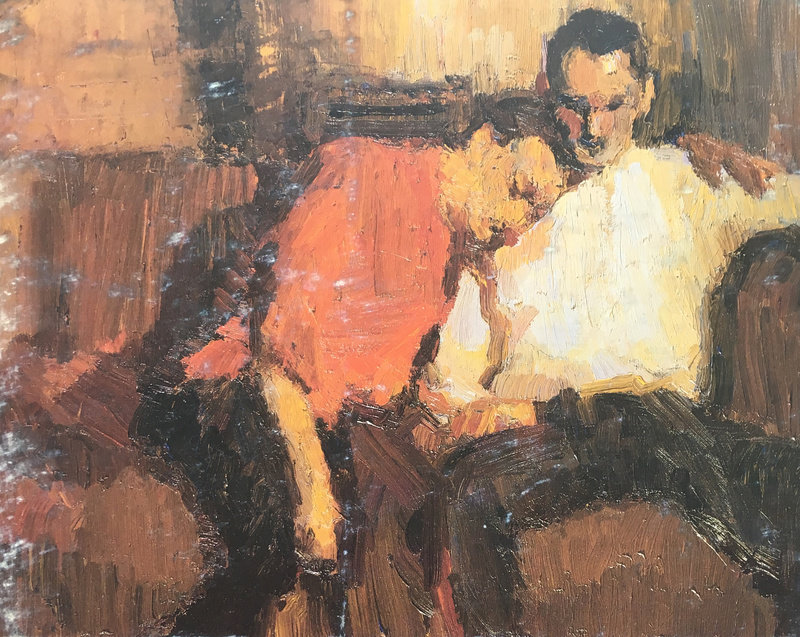
Exhibition invite for Celia Paul: Paintings and Drawings, September 20 - October 19,1991, Marlborough Fine Art, London.

Exhibition invite for Paula Rego: Peter Pan and Other Stories, December 3, 1992 - January 30, 1993, Marlborough Fine Art, London
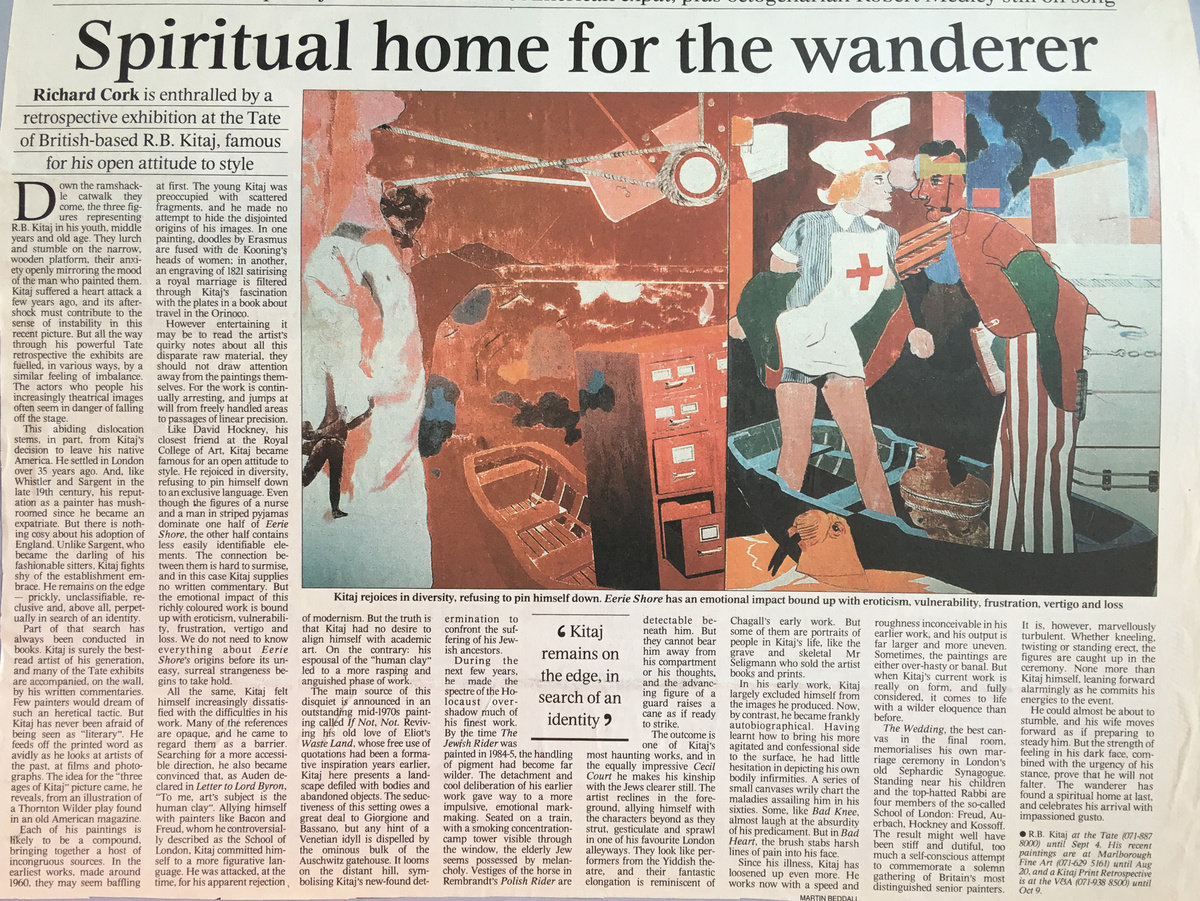
R.B. Kitaj's 1994 Tate Retrospective covered in Richard Cork's ‘Spiritual Home for the Wanderer,’ published in The Times, June 21, 1994.
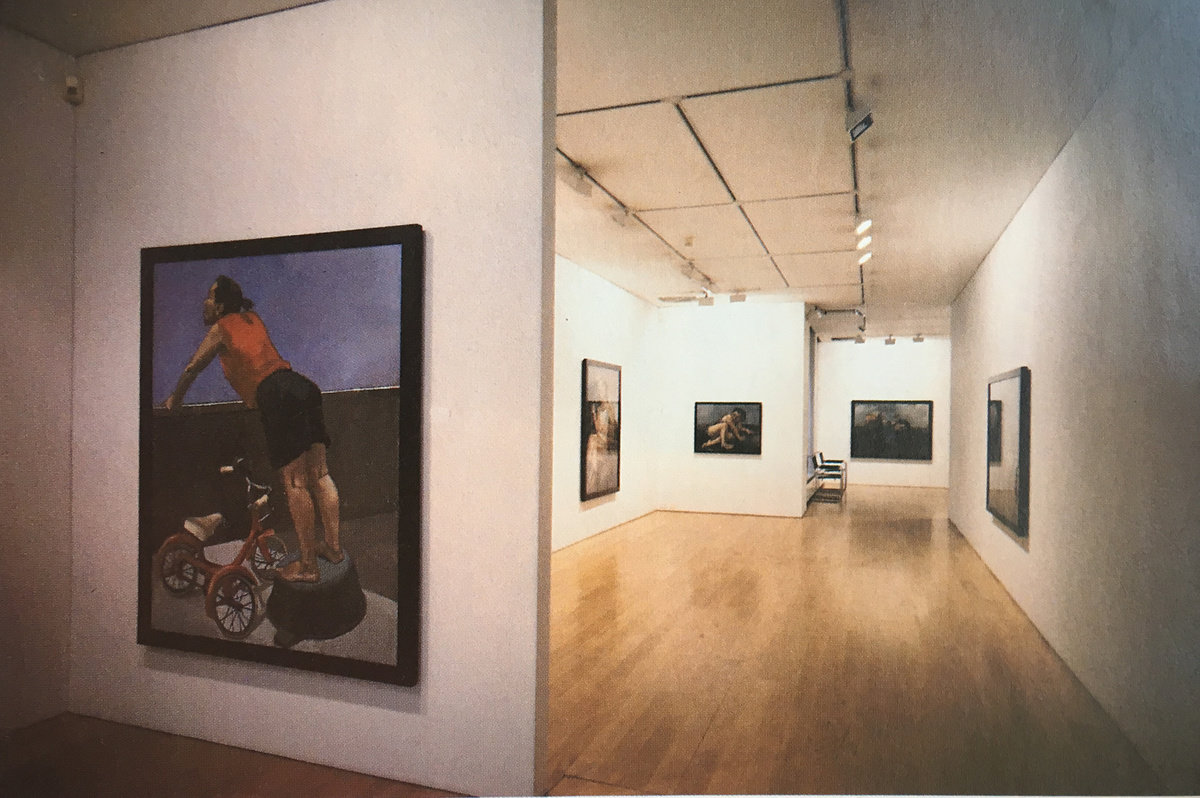
Installation view of Paula Rego's exhibition, Dog Woman, November 16 - December 30, 1994, Marlborough Fine Art, London.
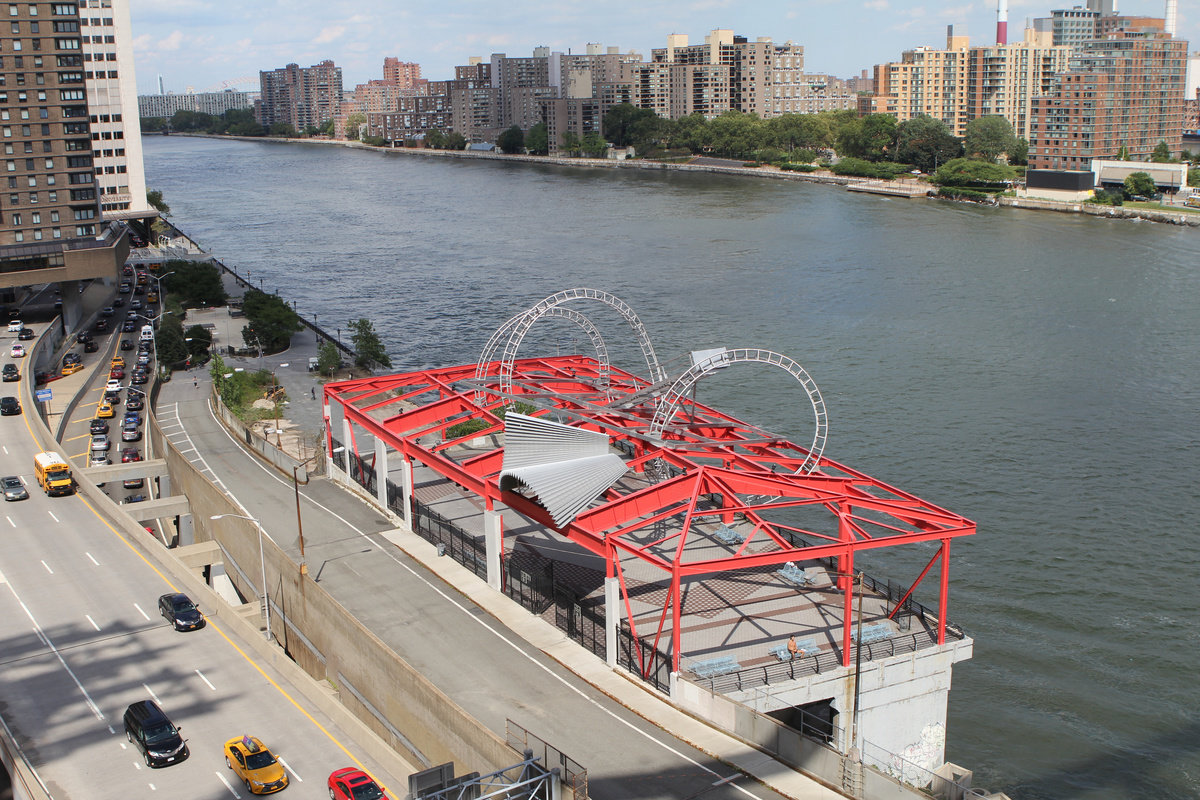
Alice Aycock's East River Roundabout, 1995/2014, aluminum; roof installation, approximately 100 x 100 x 50 feet, sited at East River Waterfront Park, East 60th Street adjacent to the Queensboro Bridge and the Roosevelt Island Tram, New York City. In 1994, Alice Aycock began her sculpture consiting of a large aluminum helix, atop the defunct Dept of Sanitation Waste Transfer Station as part of a project to transform the building into a public plaza. The shape was inspired by Fred Astaire's Dancing and is a visual response to environment of the Queensborough Bridge. Photo: Dave Rittinger.
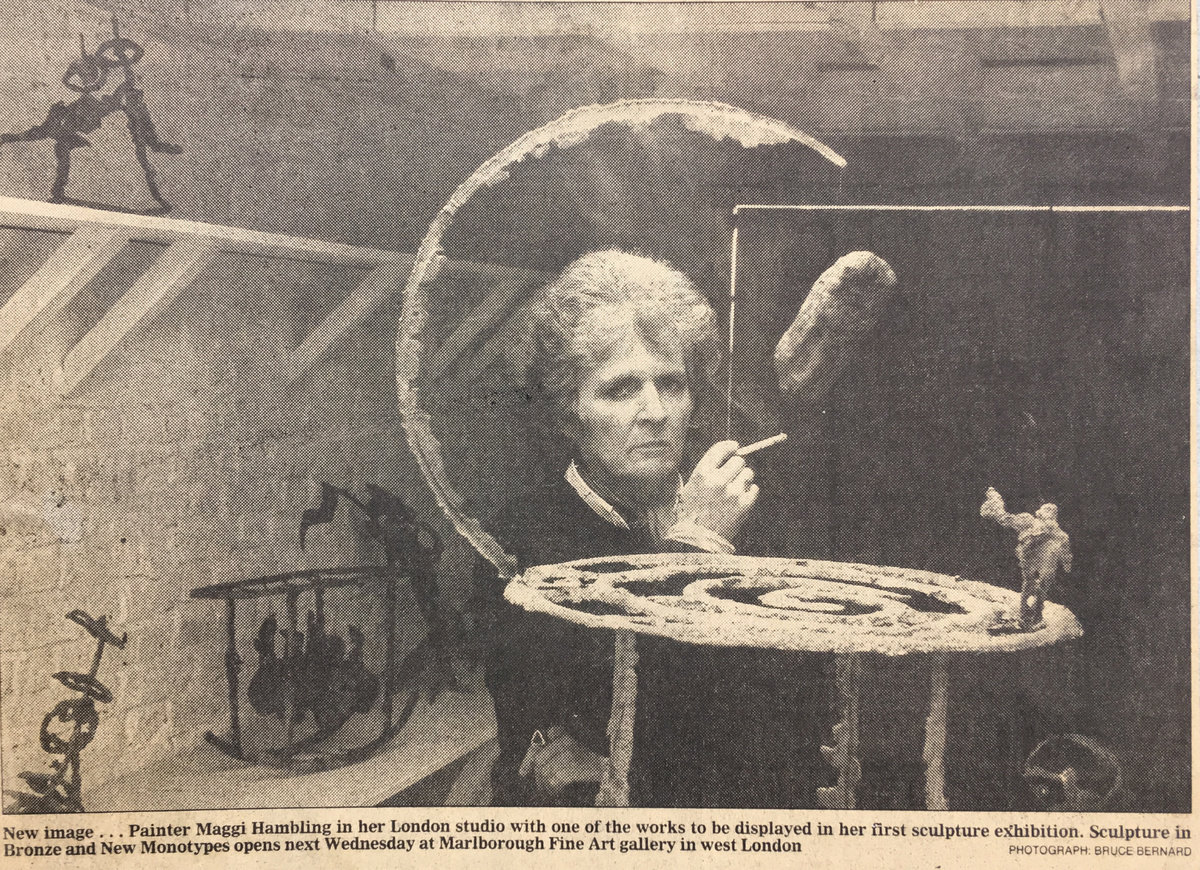
Maggi Hambling's 1996 exhibtion Maggi Hambling: Sculptures in Bronze featured in The Guardian, January 27, 1996.
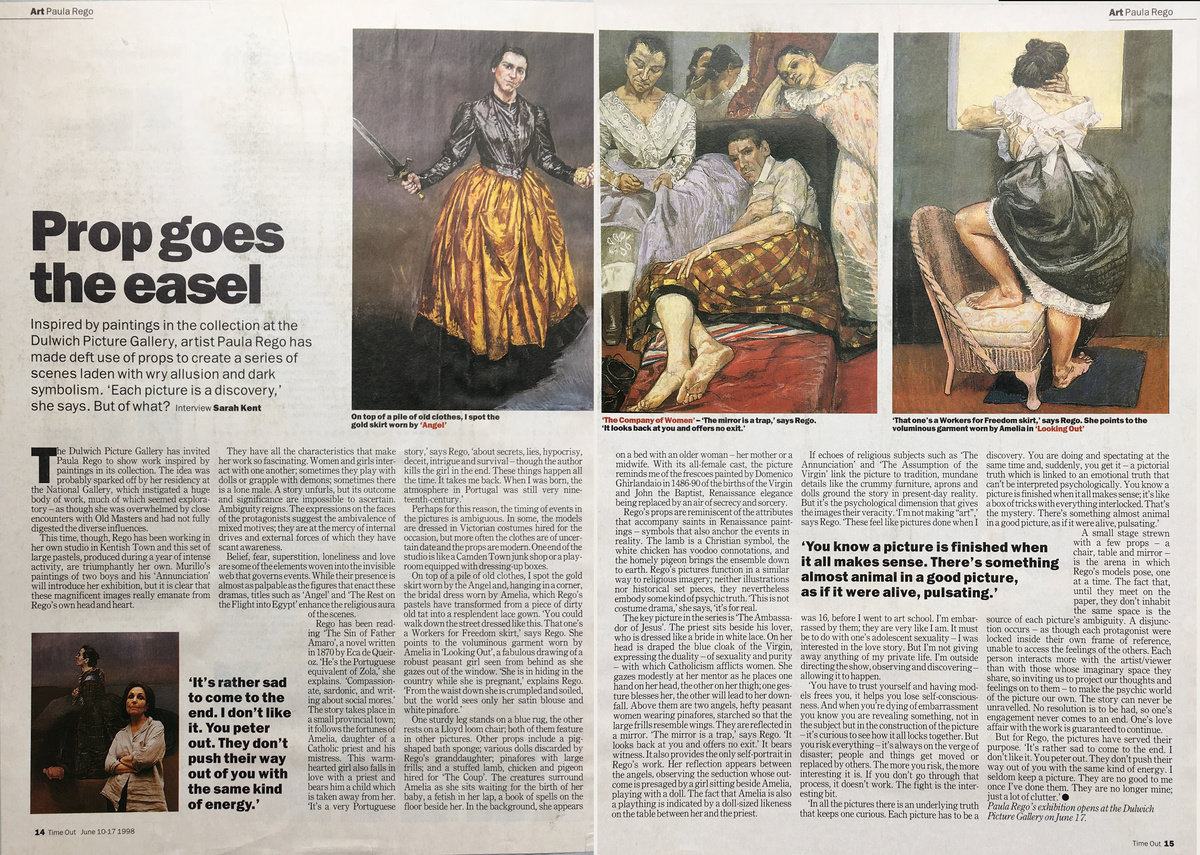
Paula Rego's 1998 exhibition at the Dulwich Picture Gallery featured in Sarah Kent's 'Prop Goes the Easel,' published in Time Out, June 10 - 17, 1998.
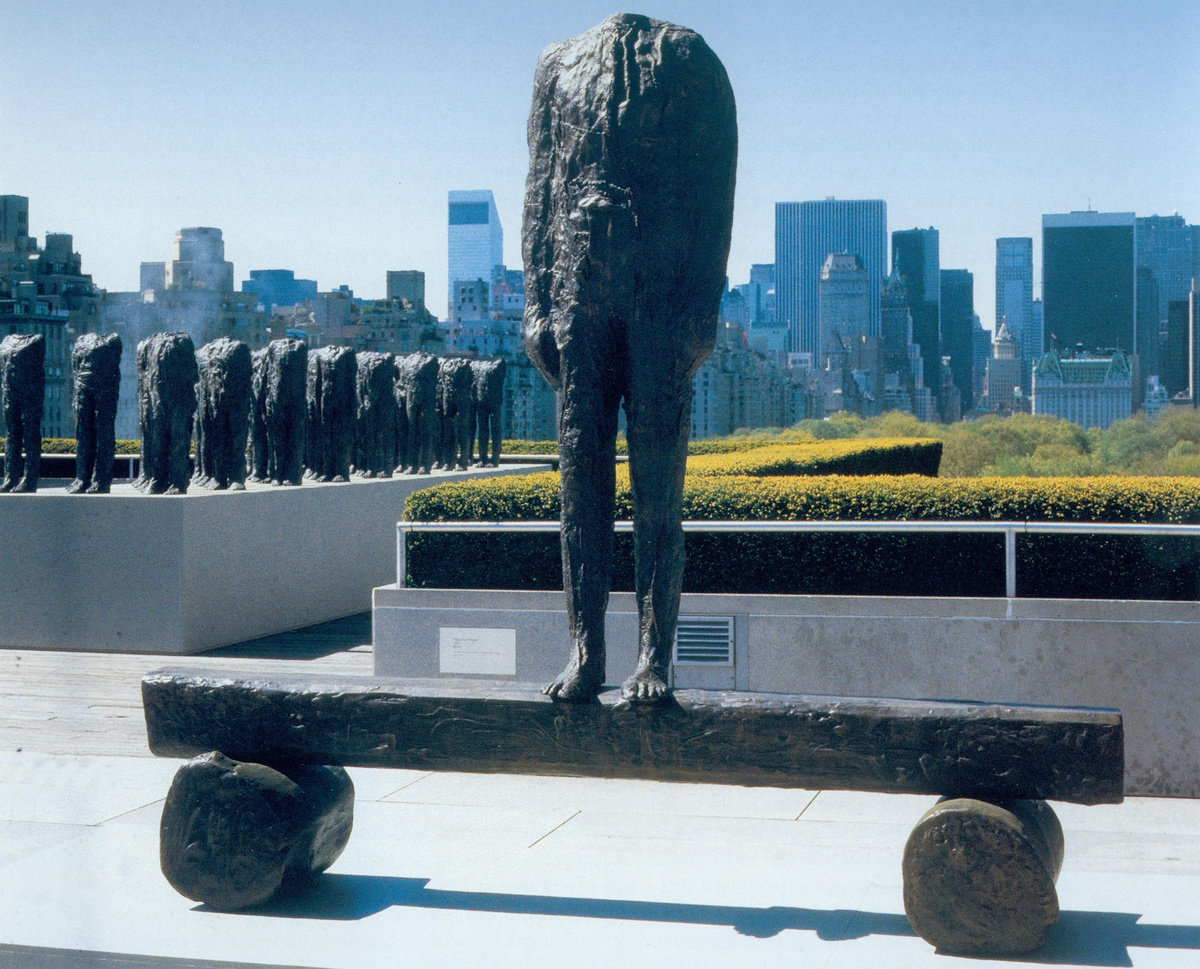
Magdalena Abakanowicz sculptures installed on the 10,000-square-foot open-air space of the Iris and B. Gerald Cantor Roof Garden, The Metropolitan Museum of Art, New York.
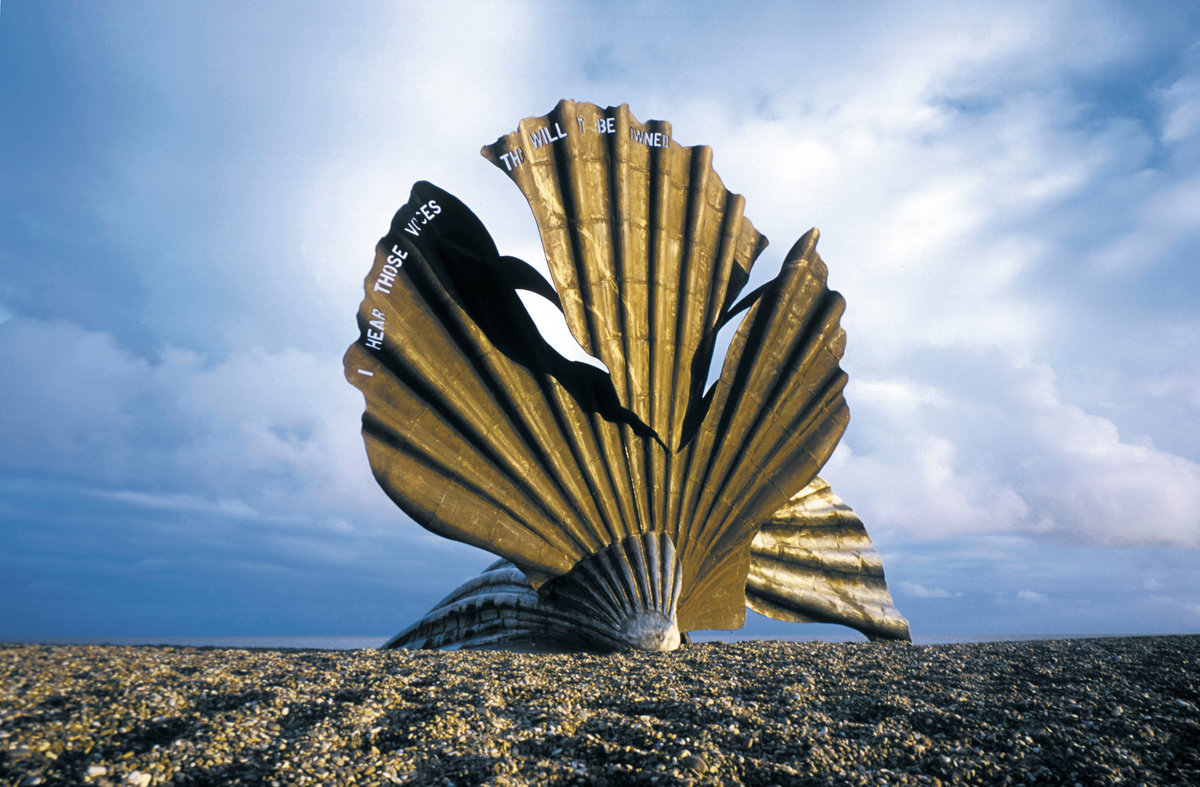
In 2003, Maggi Hambling installed her monumental sculpture Scallop on Aldeburgh Beach, Suffolk, United Kingdom to commemorate the composer Benjamin Britten’s life in the town. The sculpture captures the sounds of the sea for passing visitors, which Britten himself had so effectively depicted in music in his opera, Peter Grimes.
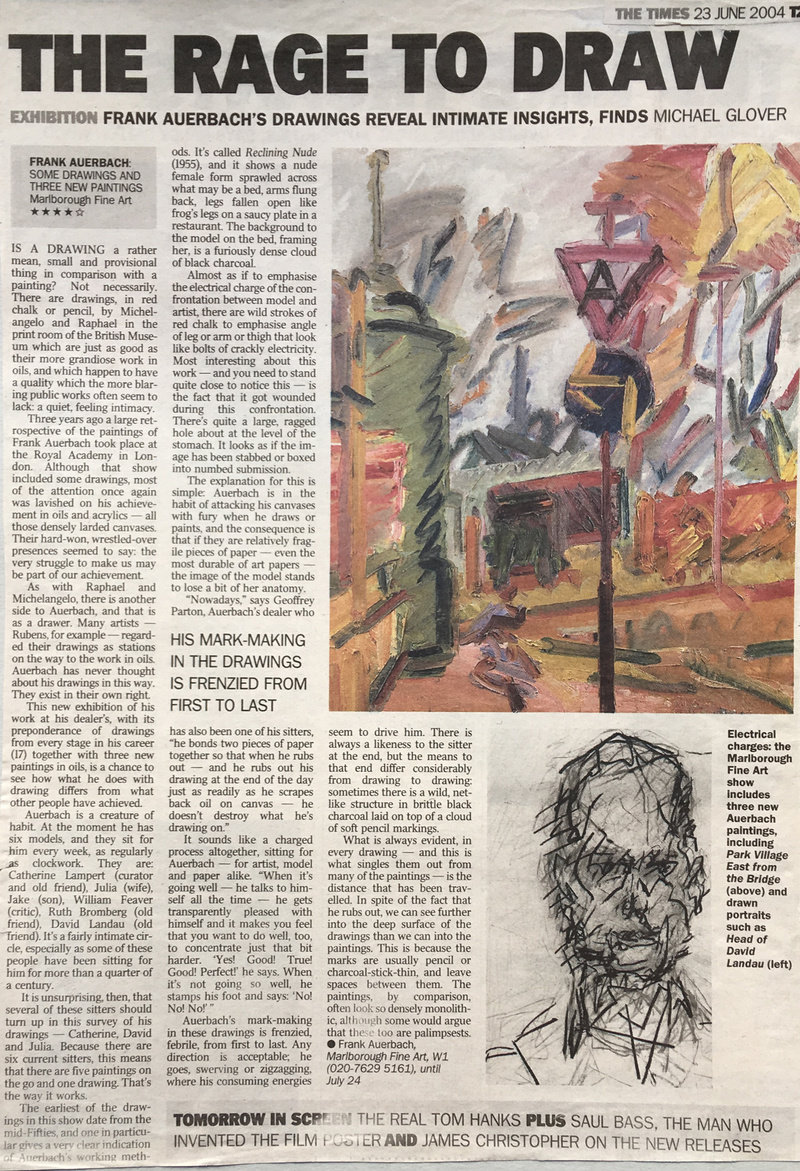
Frank Auerbach's summer 2004 exhibition Some Drawings and Three New Paintings featured in Michael Glover's 'The Rage to Draw,' published in The Times, June 23, 2004.
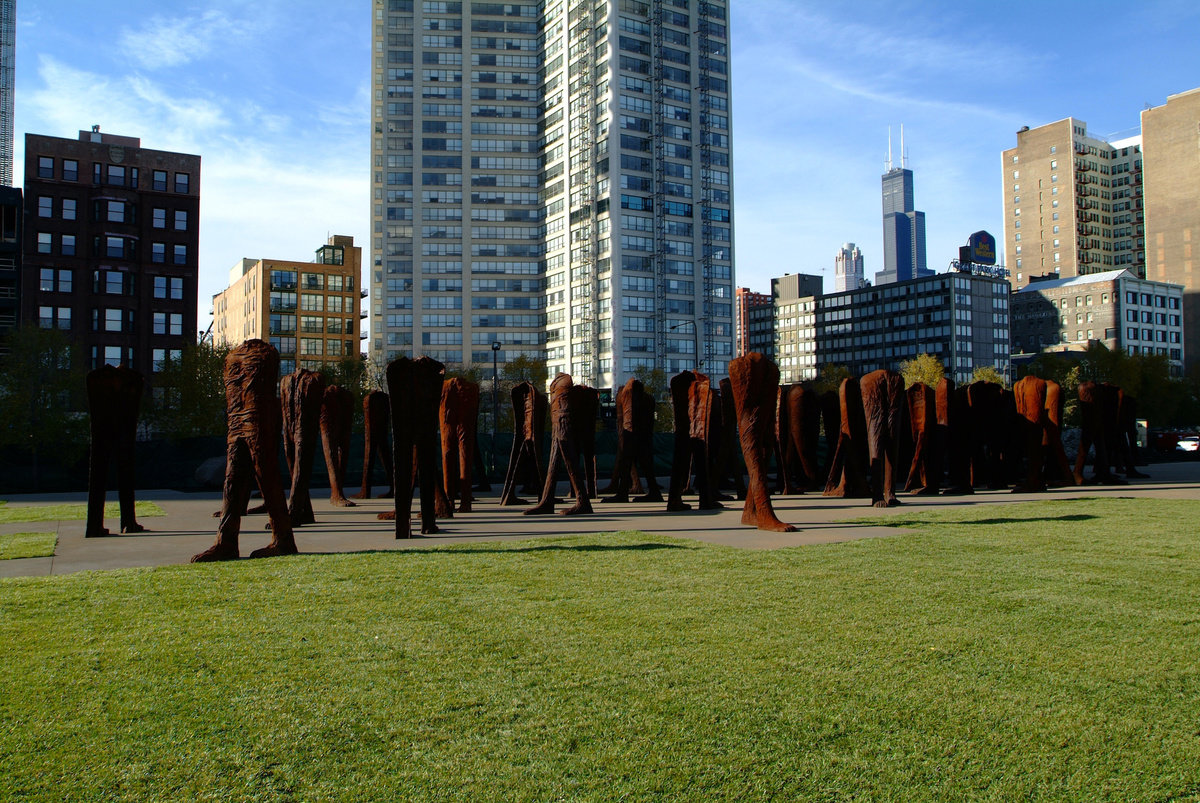
Installation view of Magdalena Abakanowicz's Agora, 2004-2006. The work, comprised of 106 headless and armless iron sculptures, was installed in 2006 as a permanent loan from the Polish Ministry of Culture at the south end of Grant Park in Chicago, Illinois.
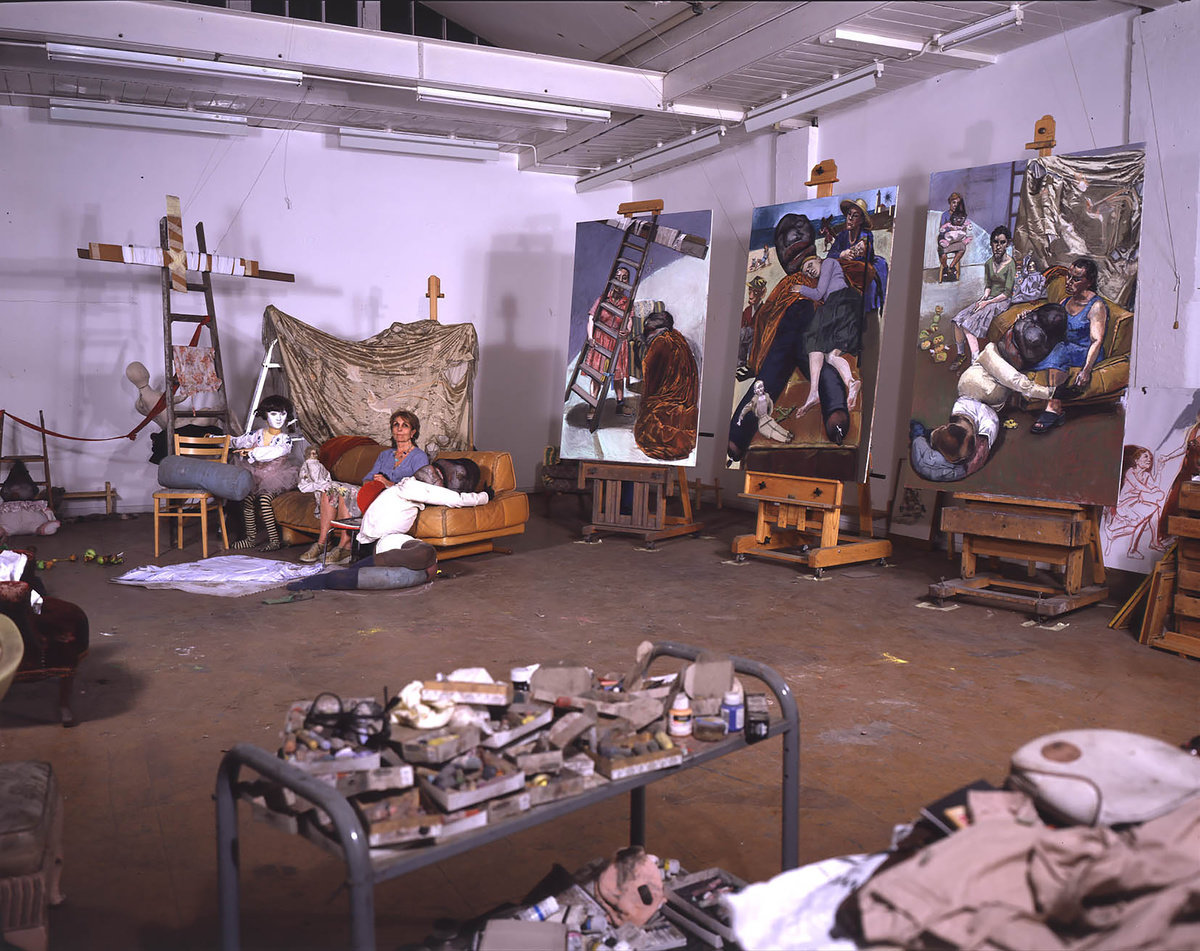
Paula Rego in the studio with her triptych, The Pillowman, 2004. Photo: Prudence Cuming Associates.
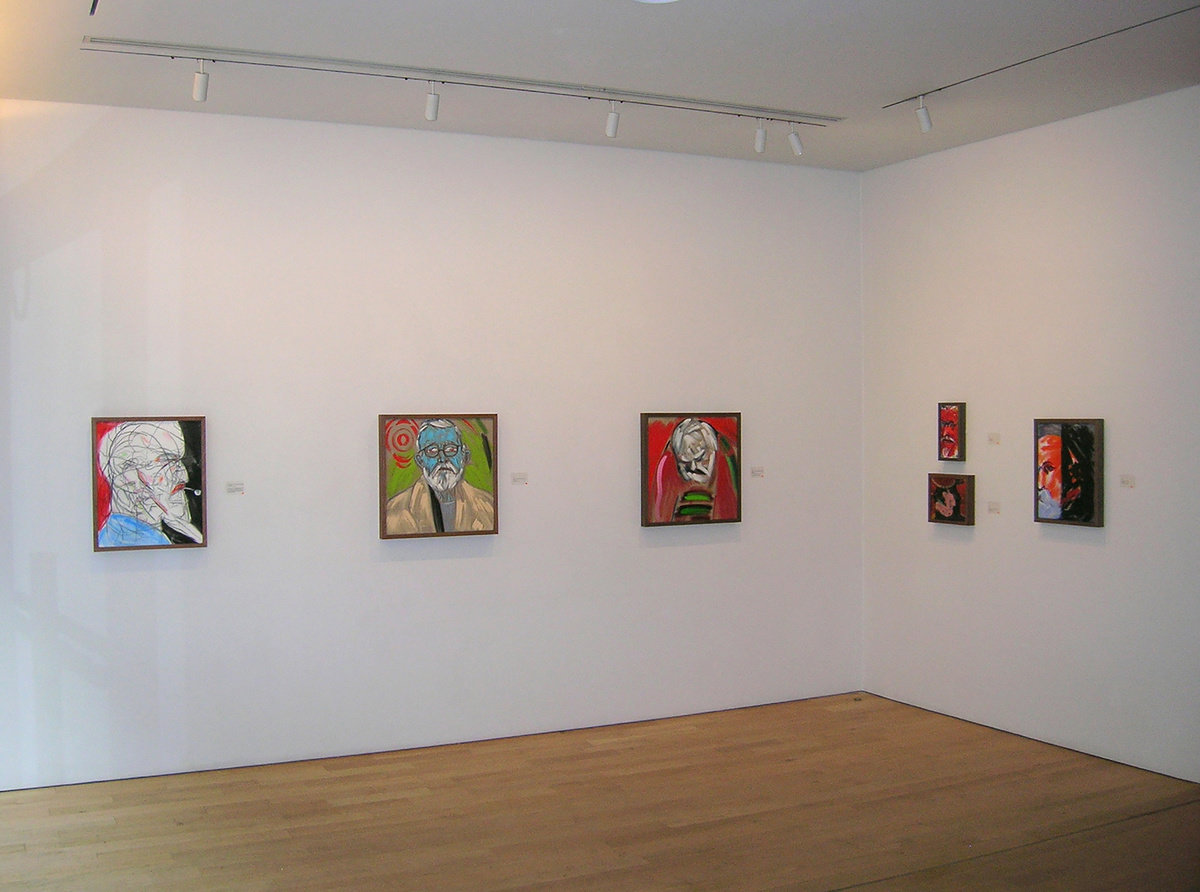
Installation view of R.B. Kitaj: Little Pictures, November 22, 2006 - January 6, 2007, Marlborough Fine Art, London.
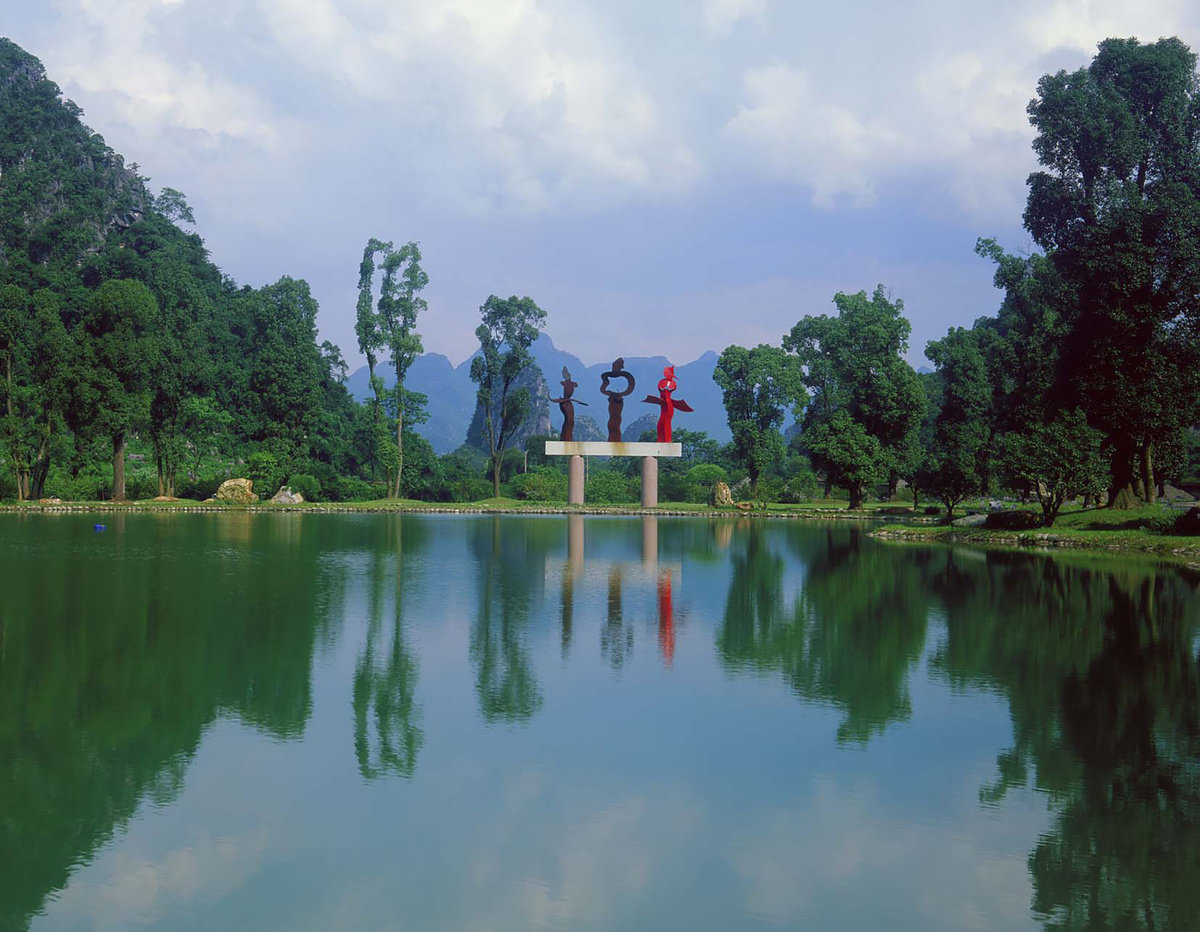
Allen Jones' sculptures for Yuzi Paradise Sculpture Parks in Guilin, China, 2006.

In 2007 The Estate of Euan Uglow held an exhibition of over twenty paintings and drawings at Marlborough Fine Art, London. The exhibition covered the entire span of Uglow’s career, from Early Nude Study, 1949, to S Picture, which he was working on until his death in 2000.
Exhibition invite for Euan Uglow: Paintings and Drawings from the Estate, May 16 - June 15, 2007, Marlborough Fine Art, London.
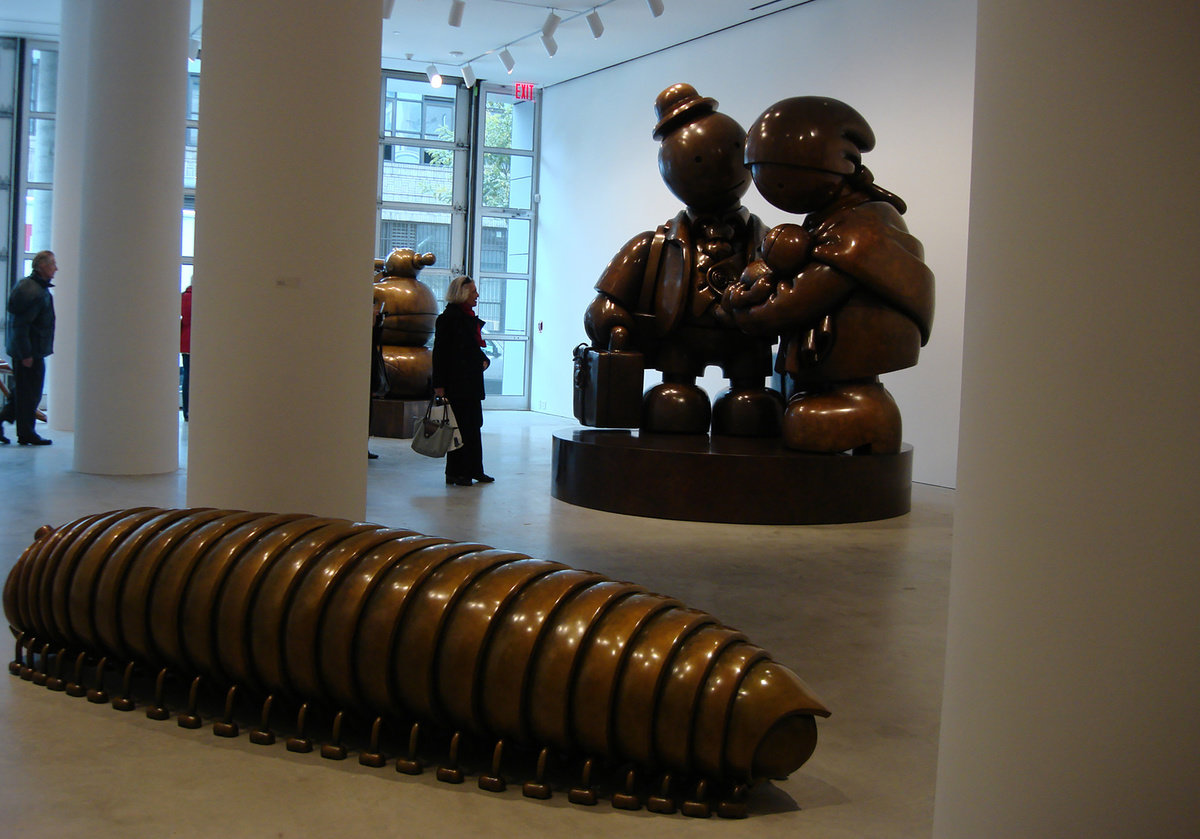
Marlborough New York inaugurated its 25th Street space in Chelsea Arts Tower in Chelsea, Manhattan with an exhibition by Tom Otterness titled The Public Unconcious.
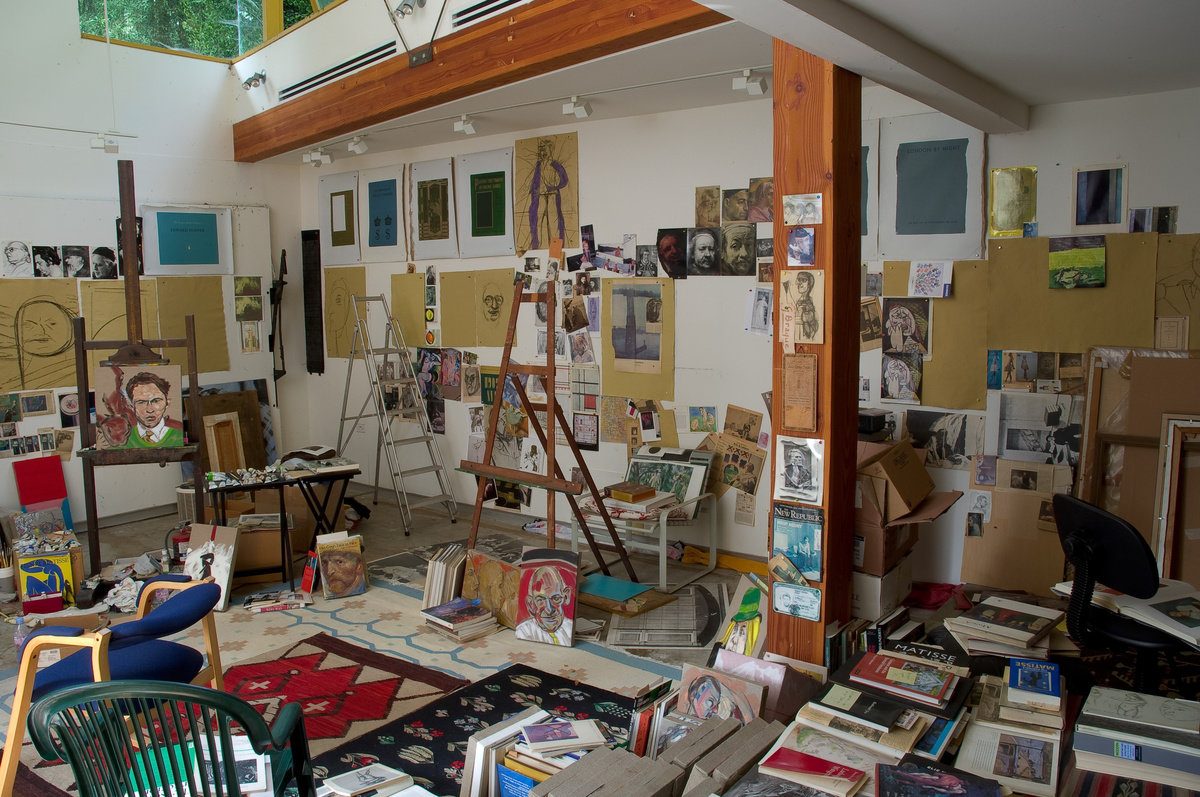
R.B. Kitaj's studio, November 2007, Los Angeles, California. Photo: Robert Wedemeyer.
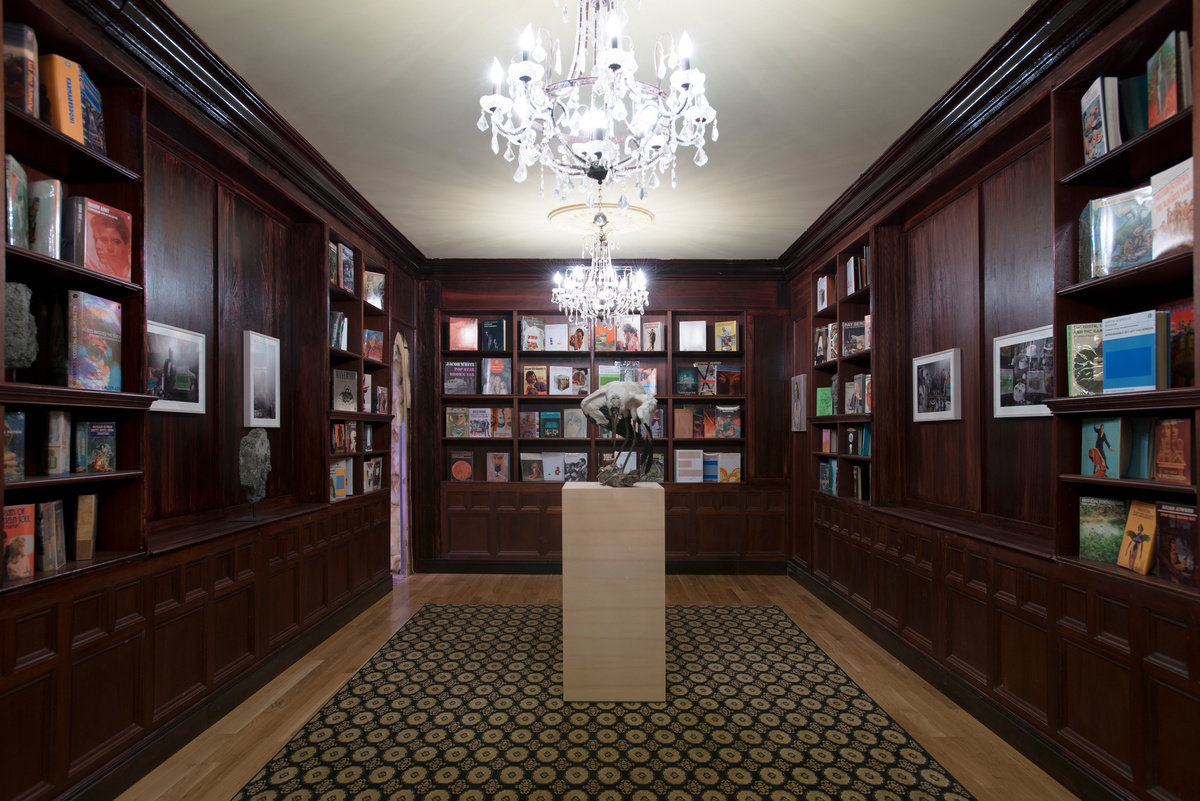
In September 2012, Marlborough Chelsea presented its first exhibition with New York-based artist duo, Jonah Freeman and Justin Lowe. In Stray Light Grey, Freeman and Lowe took the notion of the period room as a basis for the merger of fragments of industrial/urban history with loose discursive narrative threads of their own invention. These included an Art Deco museum, an O Track Betting parlor, a contemporary art gallery, an archive/library of an eccentric aristocrat and a hybridized retail environment that included, among other things, a cake shop and a plastic surgery clinic.
Stray Light Grey is an artwork of layered density that draws from the disjunctive quality of the architectural sprawl, the cinematic mosaic of a Robert Altman picture and the cognitive estrangement of a science fiction novel. Stray Light Grey is considered a direct evolution of the artists’ previous installations: Bright White Underground, 2010, Country Club, Los Angeles, CA, Black Acid Co-op, 2009, Deitch Projects, New York, NY and Hello Meth Lab In The Sun, 2008, commissioned by Ballroom Marfa, Marfa, TX.
Your journey through Stray Light Grey, Jonah Freeman and Justin Lowe’s immersive fun house of an installation, begins in a janitor’s closet. From there you pass into a grungy bathroom, step into the tub and then through a hole broken through the wall. A bleak corridor leads to an abandoned Off Track Betting parlor; a dark stairway up to a plastic surgeon’s office; and wide, brightly lighted stairs down to a store stocked with psychotropic drugs and nutritional supplements like “DNA Recalibrator.”
Through another blasted hole you emerge into a carpeted library displaying fake books with titles like The Decorated Slave State and Fun With Your Interneurons. Finally you exit through a wood-paneled lobby, where potted hybrids of cactus and salt crystal are displayed on pedestals.
Ken Johnson for The New York Times, September 27, 2012
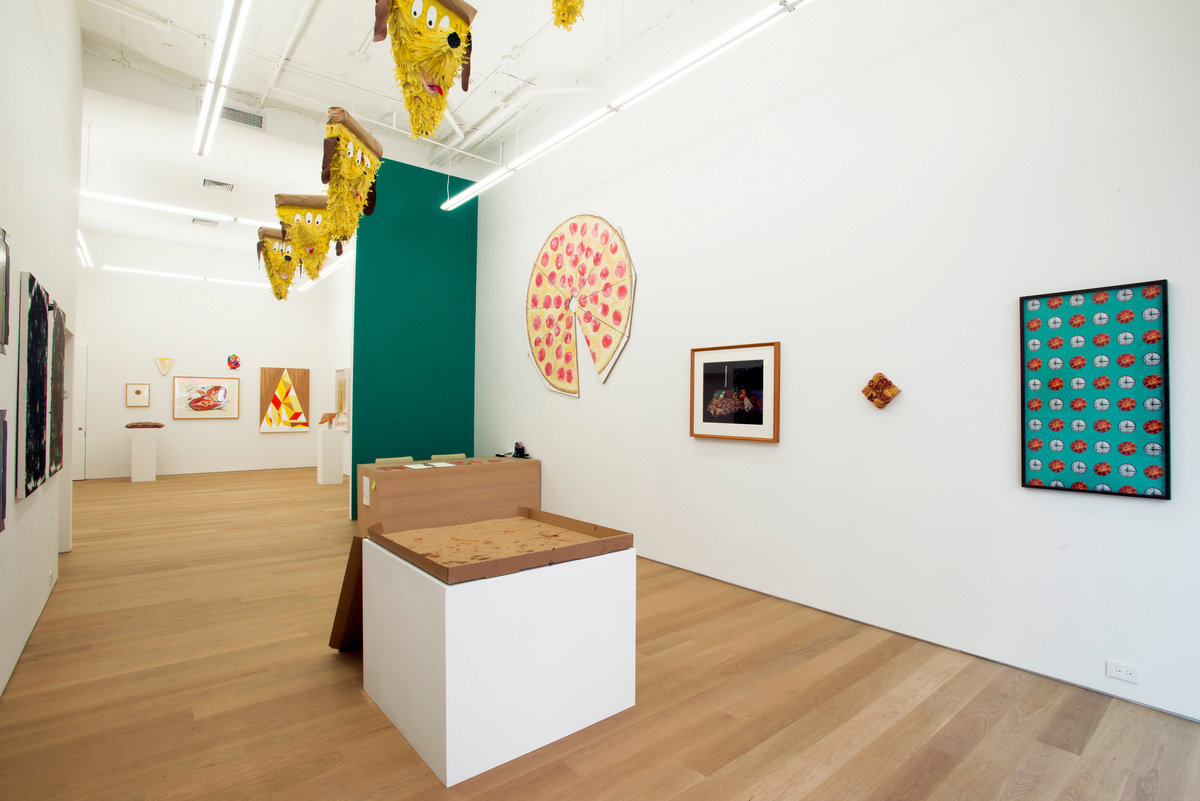
In September 2013, Marlborough Chelsea inaugurated its Lower East Side project space, Marlborough Broome Street, with a group exhibition, PIZZA TIME!, exploring the unofficial emblem of New York City: pizza. Marlborough Broome Street's programming concluded in December 2015 with a solo exhibition by New York based photographer, Richard Kern.
Participating artists in PIZZA TIME! included: Cory Arcangel and Michael Frumin, Catharine Ahearn, Uri Aran, Darren Bader, John Baldessari, Will Boone, Chris Bradley, Willem de Kooning, Michelle Devereux, Jonah Freeman and Justin Lowe, Samara Golden, Oto Gillen, Drew Heitzler, Martin Kippenberger, Andrew Kuo, Nate Lowman, Tony Matelli, Claes Oldenburg, John Riepenhoff, Reena Spaulings, Spencer Sweeney, and Mateo Tannatt.
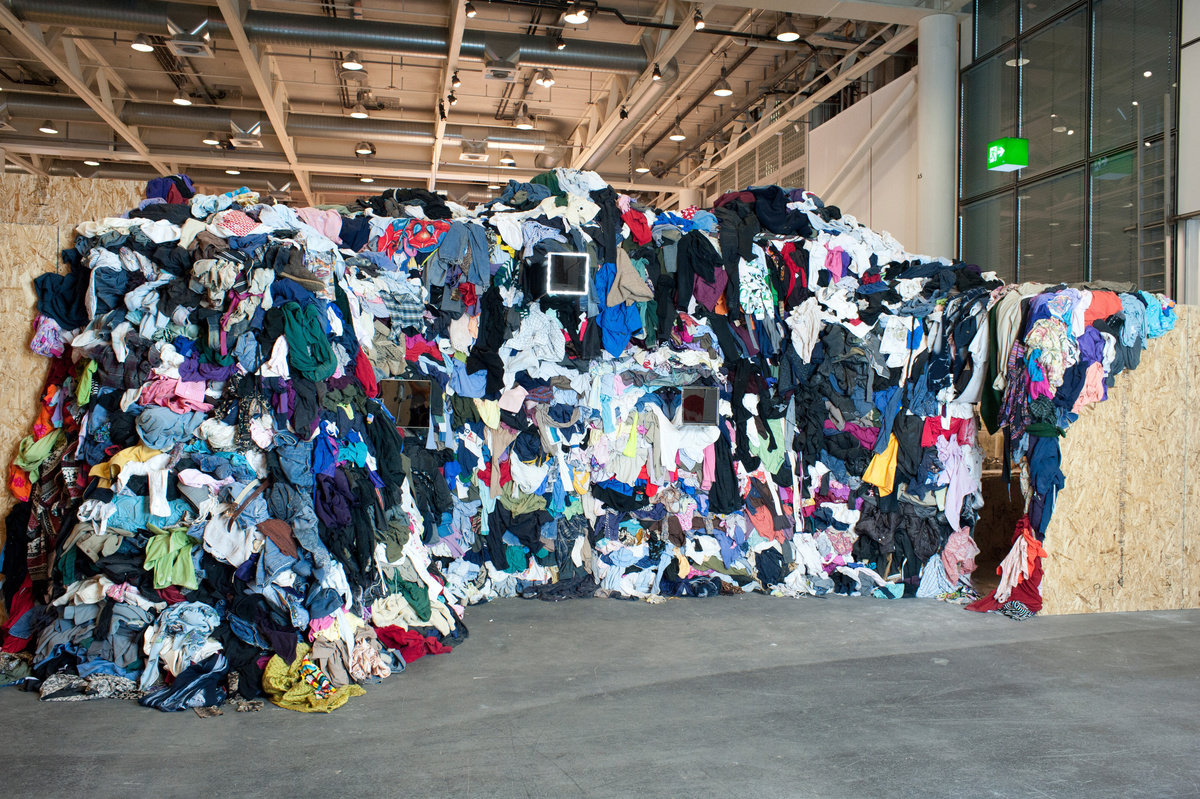
"Leave it to psychedelic- and counterculture-obsessed artists Jonah Freeman and Justin Lowe to disrupt the monotony of well-manicured booths at this week’s Art Basel: Unlimited in Basel, Switzerland. The artists’ large-scale installation, Artichoke Underground, continues to explore the narrative of the fictitious collective of the same name. As with previous installations, attention to detail, both in the execution and the colorful backstory, reigns supreme. Presented by Marlborough Chelsea, the piece features a series of seemingly disparate interiors including a Punjabi kitchen and an incubator for the study of plant consciousness—all part of the disorienting maze of scenes surrounding the Artichoke Underground (AU)’s print shop.
“The AU,” explain Freeman and Lowe, “was the beginning of a rebellion against corporate or government control of information.” Envisioned as a “conduit for underground information distribution,” the print shop is where the AU developed their magazines, posters, books, and alternative advertising materials. Founded by imagined cult figure Dr. Arthur Cook, the group also explored the development of mind-altering substances derived from plants. “Investigations into the consciousness of plants and the first plant and mineral hybrid species are things that go on in addition to the normal printing activities,” say Freeman and Lowe. These investigations were the predominant subject of Freeman and Lowe’s 2010 installation, Bright White Undergound, which depicted a house in which the group’s invented narcotic, Marasa, was manufactured. Psychedelics and printed matter converge when The AU ultimately attempt to invent their own type of media. “In the final days of AU, they began experiments into a new pharmacological/computer synthesis that would act as a new form of mind media alteration,” the artists tell us. “This was known as ‘The Octopus.'”
Never ones to steer clear of humor or rebellion, the artists included a familiar reference to Art Basel itself in their collection of carefully constructed interiors. “The empty trade fair booth is a slight dislodging of the art fair mode of display,” say Freeman and Lowe, who suggest that, just as their installation is part of the fair, the fair is in turn part of their installation. “The basic composition of our piece is a sequence of interiors, and the art fair could be seen as an extension of that sequence.”
— Allyson Shiffman for Interview, June 12, 2013
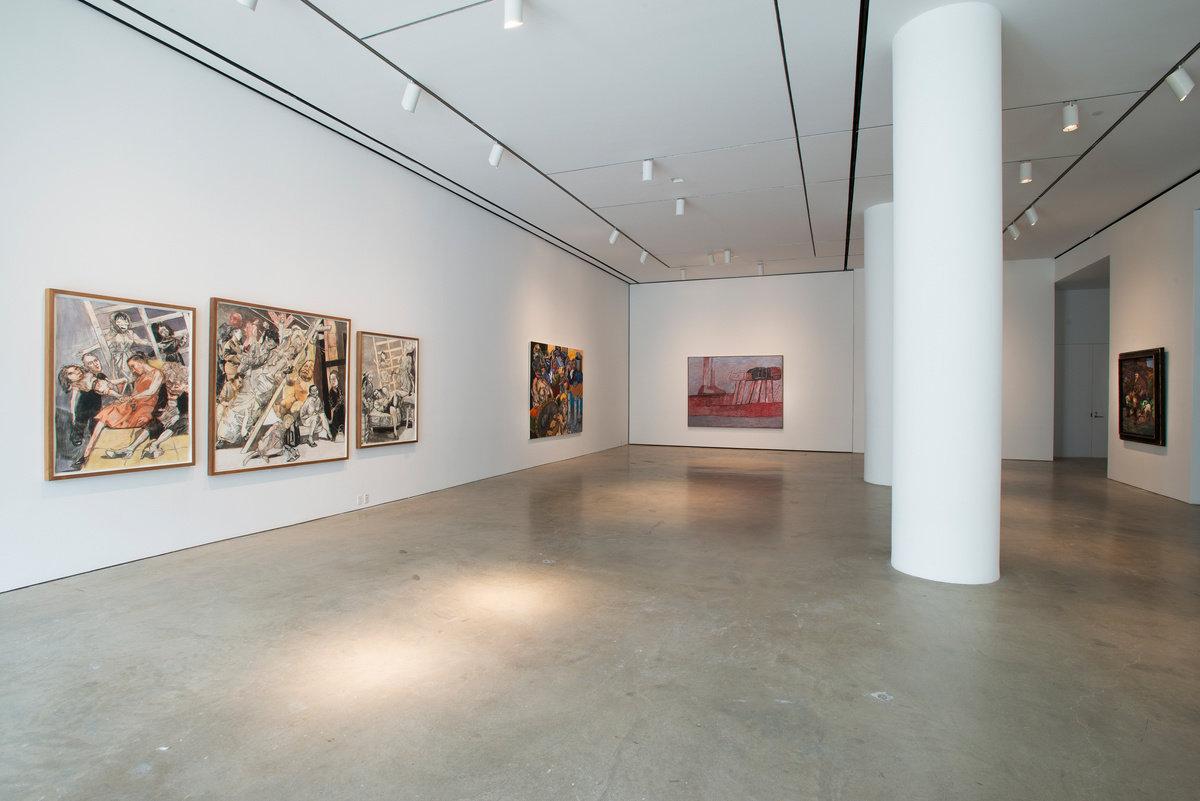
In February 2013, Marlborough Chelsea opened Alsoudani, Bacon, Guston, Rego, which brought together paintings of three world-renowned artists who had played major roles in Marlborough's history: Francis Bacon, Philip Guston and Paula Rego, as well as recent paintings by the New York based artist Ahmed Alsoudani (who would later join the gallery's roster 2017). Each of these artists confronts issues of violence and power, shifting between personal, political and historical events while maintaining a dialogue with the tradition of figurative painting. Bacon’s visceral approach to reality, Rego’s often menacing, Boschian stories and folk tales, and Guston’s singular and liberating figurative works of the 1970s are all reflected in the tumult and dynamism of Alsoudani’s work. Alsoudani’s synthesis of these influences lead to his signature conglomerations of symbolic form and gure.
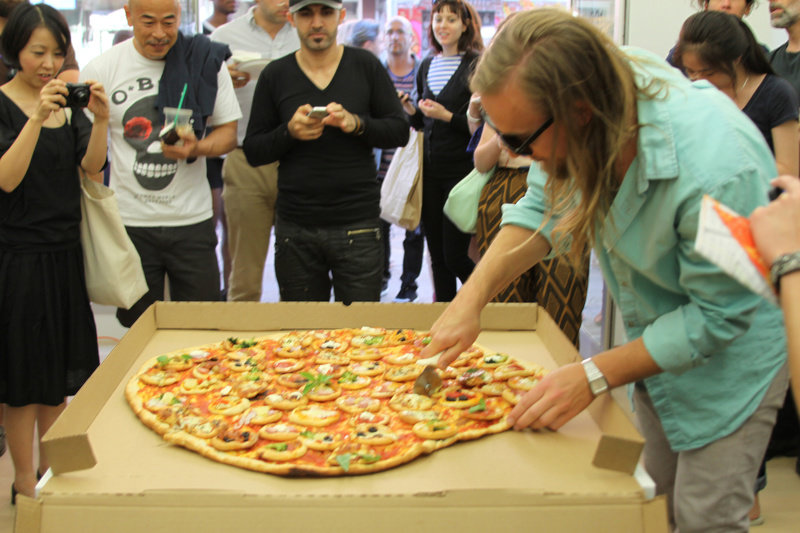
The opening reception for PIZZA TIME! at Marlborough Broome Street featured a performance by gallery artist John Riepenhoff titled Physical Pizza Networking Theory.

In February 2014, The Portikus Museum in Frankfurt, Germany presented Powered A-Hole Spanish Donkey Sport Dick Drink Donkey Dong Dongs Sunscreen Model, a collaborative exhibition between Marlborough artist Mike Bouchet and Paul McCarthy. The project initially started as a joke between the artists, who have known each other for over twenty-five years, involving a series of similar observations involving the Guggenheim Museum, which later evolved into a more serious project.
The resulting installation exemplified both artists’ use of excess, exaggeration, parody, mis-appropriation, dysfunctionality and immoderation result in their respective works. The collaborative “tour de force” turned Portikus into a rampant Gesamtkunstwerk. By employing a language of exorbitance, and extending this beyond the exhibition space and into various locations in the city of Frankfut, Mike Bouchet and Paul McCarthy created a sprawling exhibition that engaged with and parodied the multifacted excesses of contemporary art production and commodification.
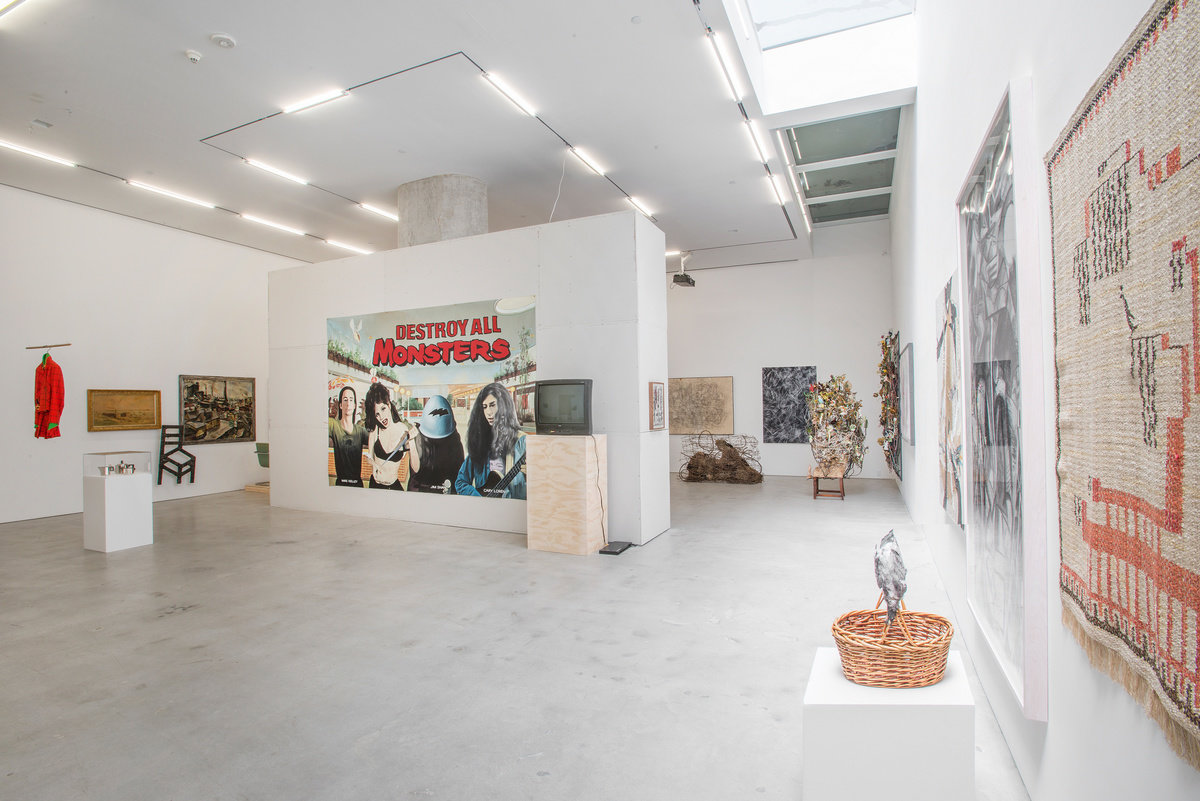
In Summer 2014, Marlborough Chelsea opened Another Look at Detroit, a joint project with nearby Marianne Boesky Gallery. The ambitious two-gallery exhibition, curated by Todd Levin, presented works and objects by over fifty artists, designers, and cultural contributors and focused on the city of Detroit as a creative center, historically through today. Spanning a period of 150 years, Another Look at Detroit was not intended to be a comprehensive survey, buth rather portrayed a vision as sprawling and complex as the biography of the city itself.
Contributers included: Mary Ann Aitken, Keith Aoki, William James Bennett, Harry Bertoia, McArthur Binion, James Lee Byars, Nick Cave, James Chatelain, Liz Cohen, Destroy All Monsters, Collective, Robert Duncanson, Charles and Ray Eames, John Egner, Ford Motor Company, Cyprien Gaillard, Michael Glancy, Brenda Goodman, Jay Heikes, Marie T. Hermann, Scott Hocking, Percy Ives, Ray Johnson, Mike Kelley, Arthur Nevill Kirk, Hughie Lee-Smith, Kate Levant, Morton Levin, Arnold Livshenko, Al Loving, Michael C. Luchs, P. Scott Makela, Tony Matelli, Katherine McCoy, Michael McCoy, Allie McGhee, Charles McGee, Julie Mehretu, Julius Garibaldi Melchers, Metroplex, Ann Mikolowski, Carl Milles, Wallace MacMahon Mitchell, Gordon Newton, Michele Oka Doner, Max Ortiz, Ellen Phelan, Pewabic Pottery, Bill Rauhauser, Scott Reeder, Jennifer Wynne Reeves, Richard Ritter, Diego Rivera, Eero Saarinen, Eliel Saarinen, Loja Saarinen, Dana Schutz, Zoltan Sepeshy, Robert Sestok, Jim Shaw, Shinola, Michael E. Smith, Mortimer Smith, Gilda Snowden, John Mix Stanley, Anna Sui, Graem Whyte and Robert Wilson
2014
From 2014-2015, Marlborough Chelsea, alongside the Broadway Mall Association and The New York City Parks Department, presented Broadway Morey Boogie, an offsite sculpture exhibition that spanned the island of Manhattan. The exhibition borrowed its title from Dutch painter Piet Mondrian’s 1942-43 masterpiece, Broadway Boogie Woogie. The painting, which today is one of the Museum of Modern Art’s most popular artworks, once mobilized the avant-garde ideals of abstraction in a brash ode to the dynamism and vitality of New York City street life. This exhibition aimed to do the same by populating the backbone of Manhattan—from Broadway and West 166th Street to Columbus Circle—with a group exhibition of outdoor sculpture by contemporary American artists. The first of its kind on ten highly-varied neighborhood sites, this show spanned a variety of mediums and methods employed by artists both emerging and established. The works were selected in an attempt to engage audiences at street level with accessible, thought-provoking artworks of modest to monumental scale.
Participating artists included: Sarah Braman, Dan Colen, Paul Druecke, Lars Fisk, Drew Heitzler, Matt Johnson, Joanna Malinowska, Tony Matelli, Davina Semo and Devin Troy Strother.
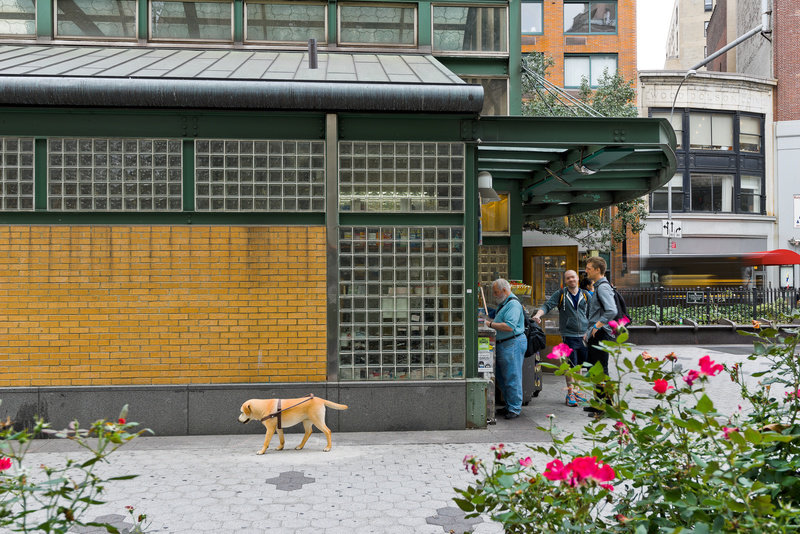
Tony Matelli's Stray Dog, 2000 installed at West 73rd Street and Broadway, New York during Broadway Morey Boogie. Photo: Mark Woods.
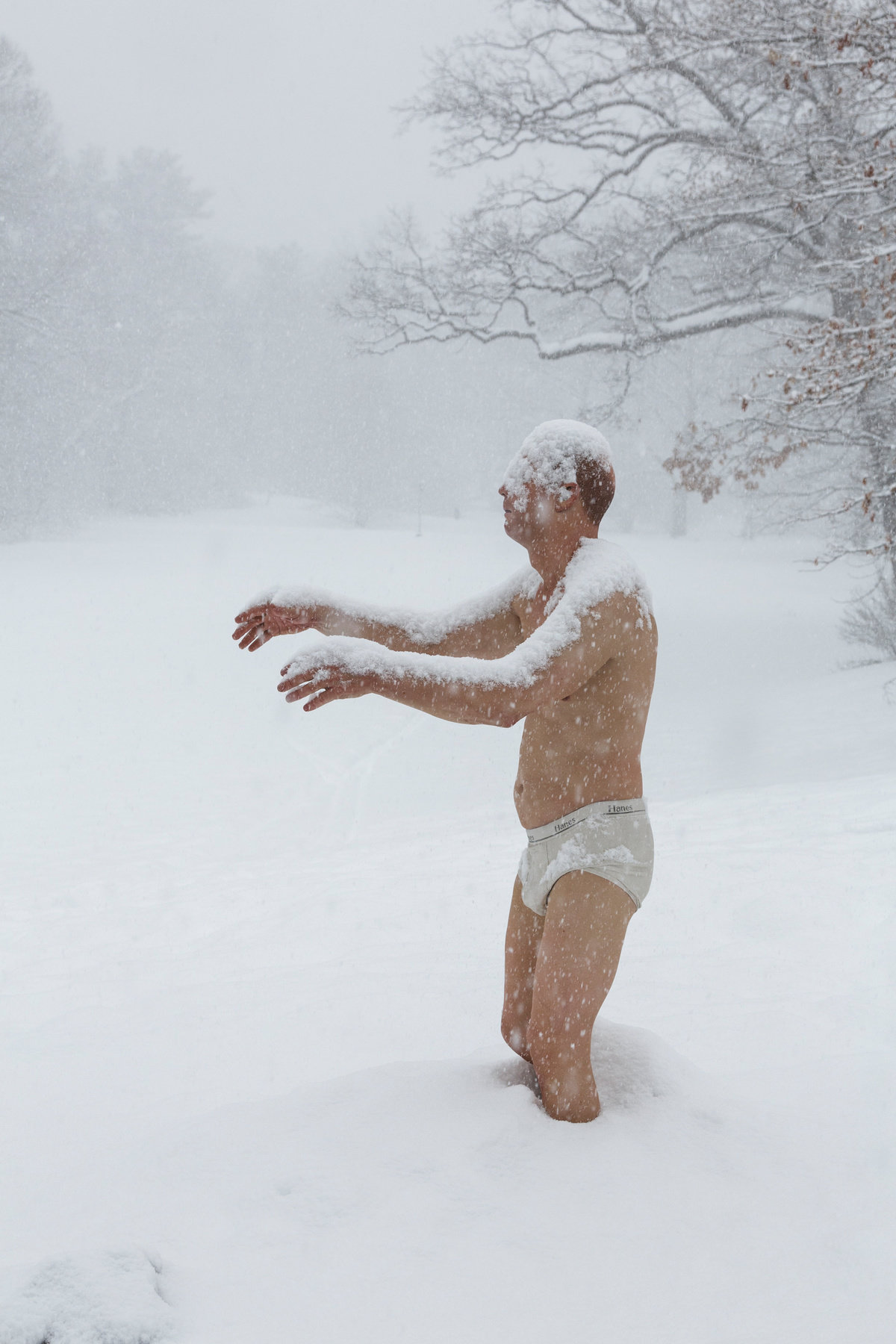
New Gravity marked Tony Matelli's first solo exhibition at a U.S museum. The exhibition opened in February 2014 at the Davis Museum at Wellesley College and focused on the artist’s discursive use of time, ambivalence, banality and wonder. As the museum notes, "In Matelli’s work the physical laws of objects are often reversed, upended or atomized, and with these deft manipulations of matter and gravity come profound reorientations in perspective and ways of seeing. Matelli creates a distortion field of sorts, a lens through which to question one reality and create another." The exhibition notably marked the debut of Matelli's bronze Sleepwalker, 2014, which was situated outside on the roadside just beyond the Davis.
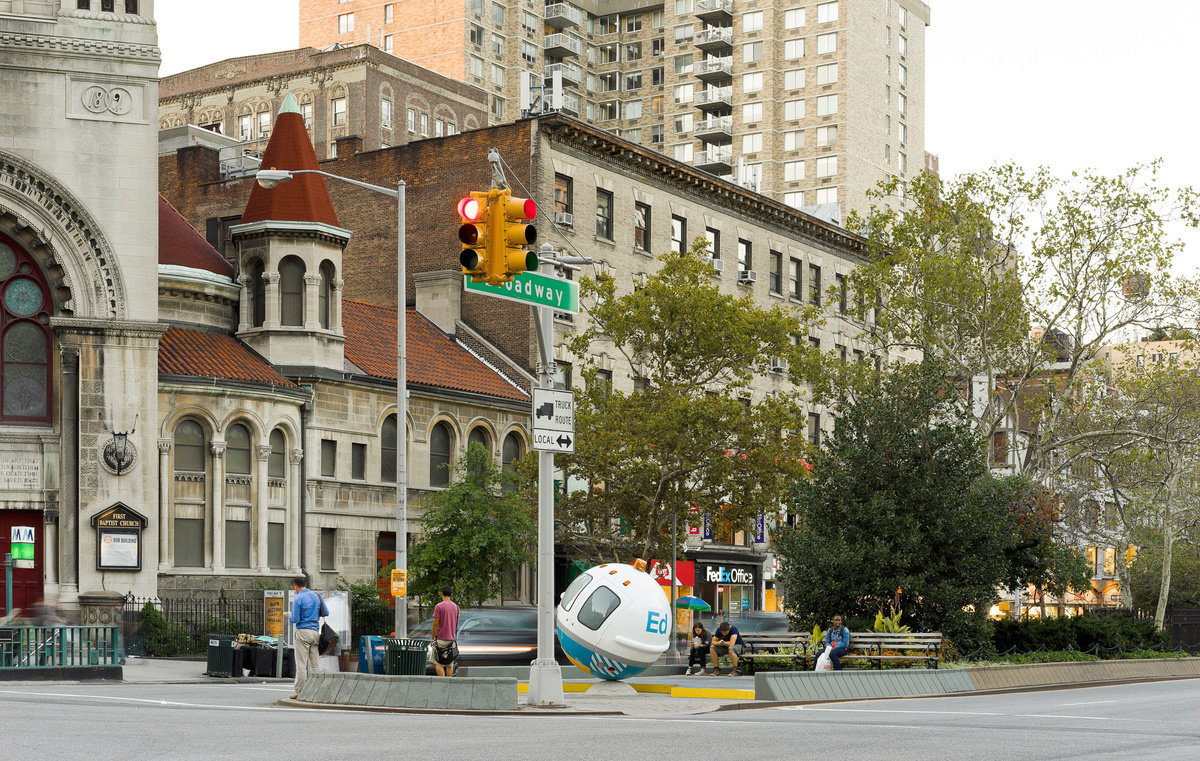
Lars Fisk's Con Ed Ball, 2014 installed at West 79th Street and Broadway, New York during Broadway Morey Boogie. Photo: Mark Woods.

Marlborough Broome Street's exterior during Red Grooms' 2014 exhibition, Beware a Wolf in the Alley.
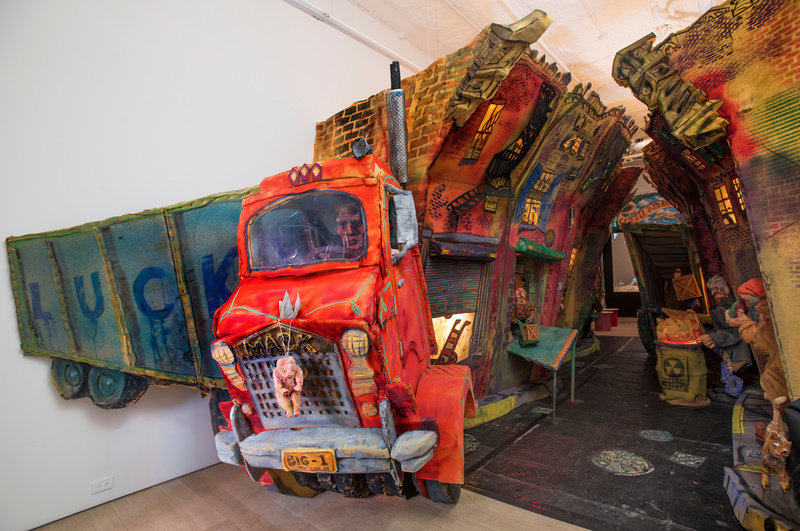
Installation view of Beware a Wolf in the Alley, a 2014 solo exhibition by the inimitable Red Grooms, at Marlborough Broome Street. The exhibition marked the re-installation of Grooms' immersive sculpto-pictorama, The Alley, 1984-1985 and his 16-minute film, Little Red Riding Hood, 1978.
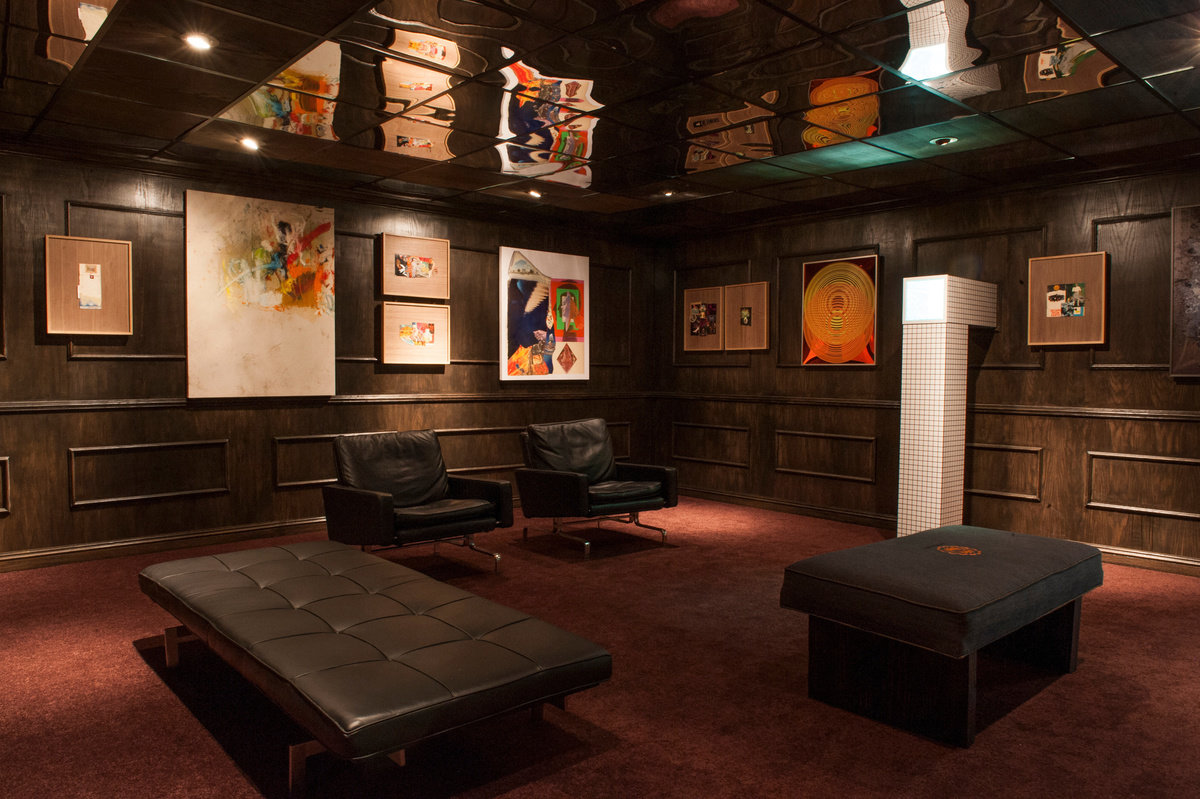
Installation view of Jonah Freeman and Justin Lowe's 2014 immersive installation, The Floating Chain (High Res Toni), at Marlborough Chelsea, New York.
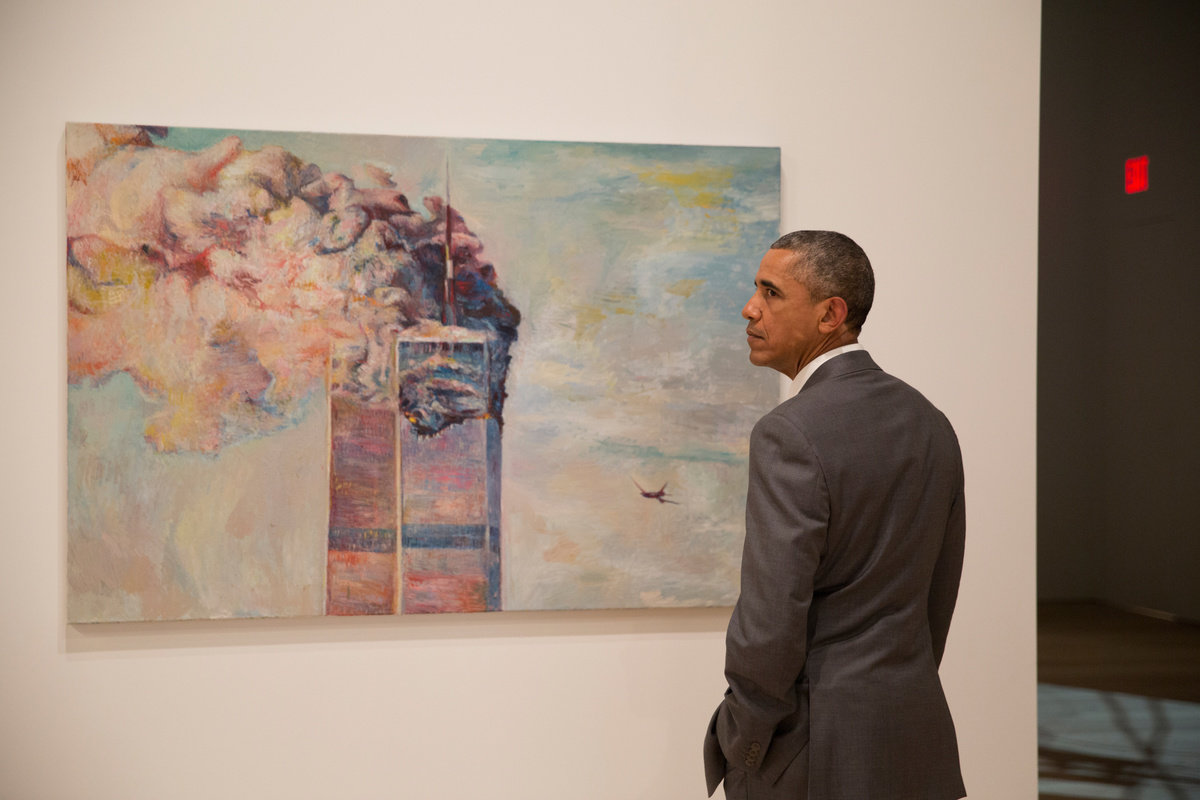
President Barack Obama sharing a quiet moment with Keith Mayerson's 9-11, 2007 while touring America is Hard to See, the inaugural exhibition in the Whitney Museum of American Art's Gansevoort Street space in New York. The painting is a part of the museum's permenant collection. Photo: Pete Souza.
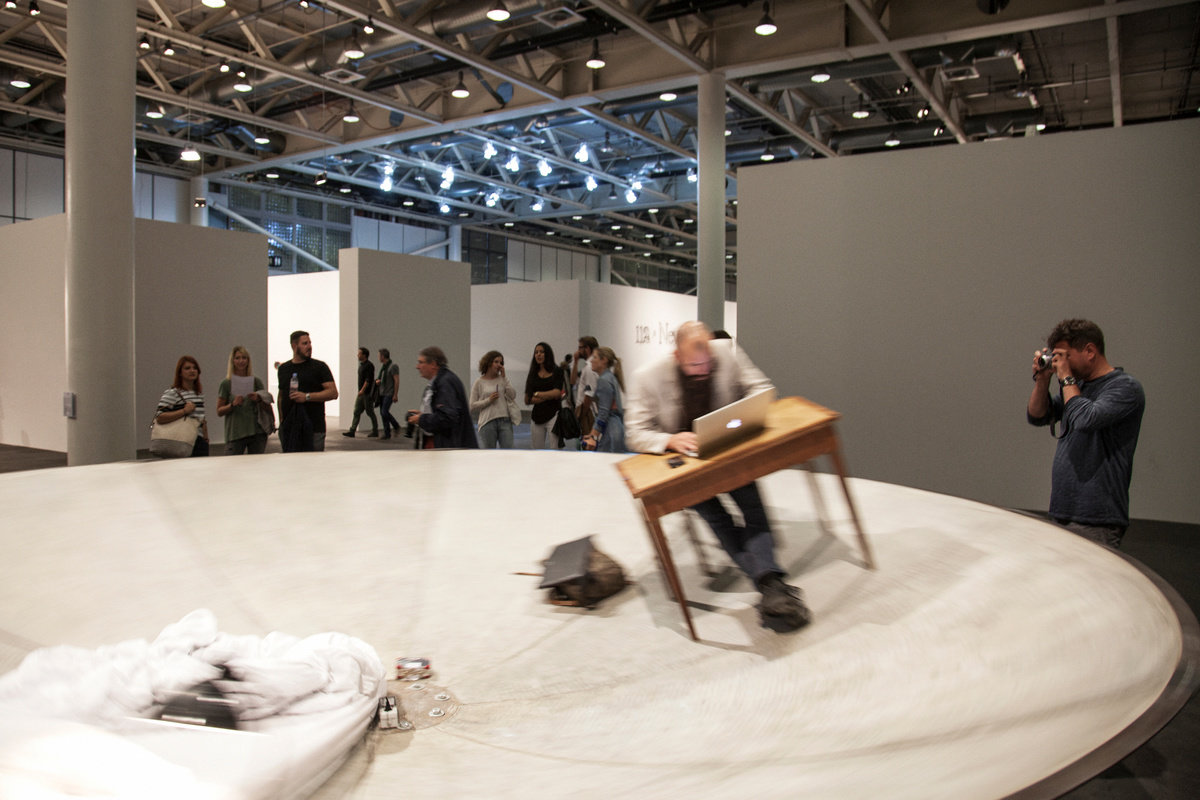
During the 2015 edition of Art Basel: Unlimited, Julius von Bismarck spent the duration of the fair on a paraboloid-shaped cement disc, titled Egocentric System. The artist slept, ate, read and talked on the telephone while on the platform, which rotated around its own axis at a speed of fifteen revolutions per minute. Passersby were able to see the artist clearly, although he was only able to perceive the external world as a blurred mass of people, whose voices merged in an incomprehensible murmur. In Egocentric System, the artist served as the object of an experiment, testing the perceptual and psychological effects of a rotating system in which the force of gravitation is distorted by centrifugal force.
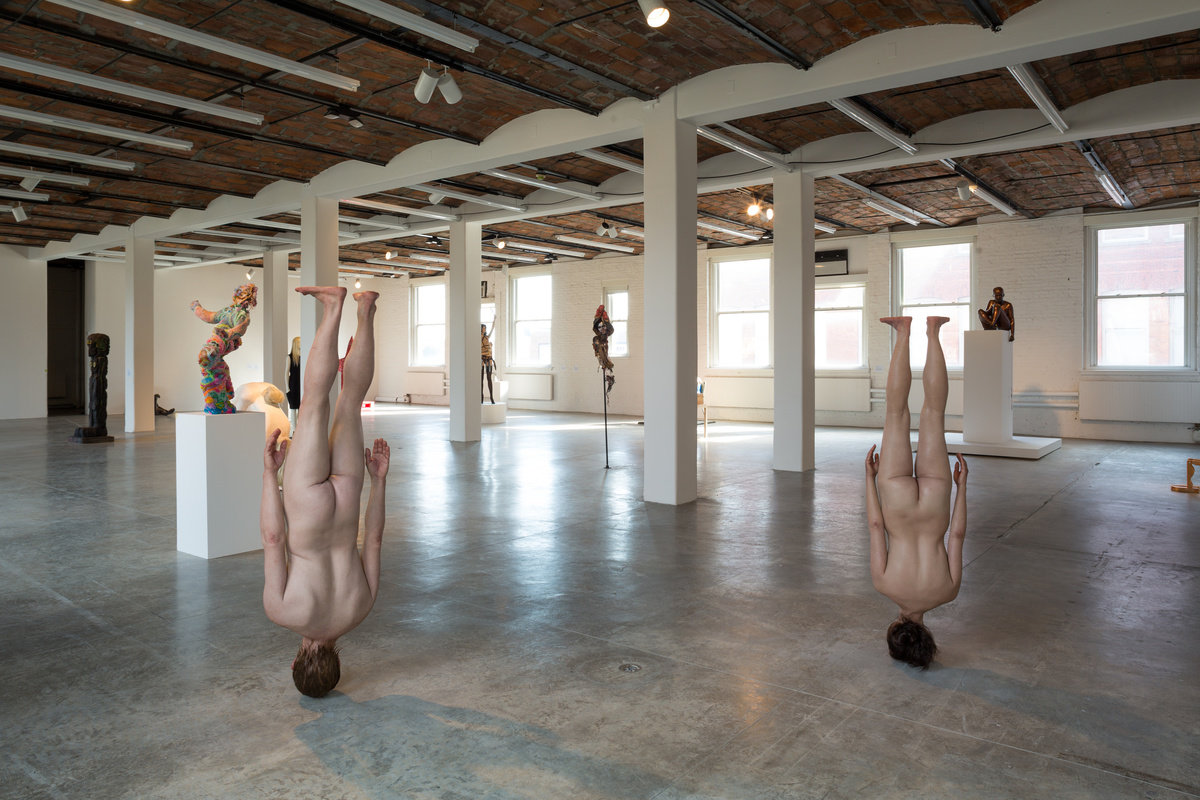
Installation view of Tony Matelli's Figure 1 and Figure 2, 2015 at the 2015 edition of Greater New York at MoMA PS1, New York. The sculptures, conceived for the artist's Spring 2015 solo exhibition, Garden, at Marlborough Chelsea, New York, are inescapably evocative of Adam and Eve; however, the duo is clearly contemporary and the artist intends them as a more generic couple. Still, the piece reminds us that the expulsion from Paradise is a perpetual and universal state, and points to the persistent romantic pessimism that is a prominent strain of the artist’s oeuvre.
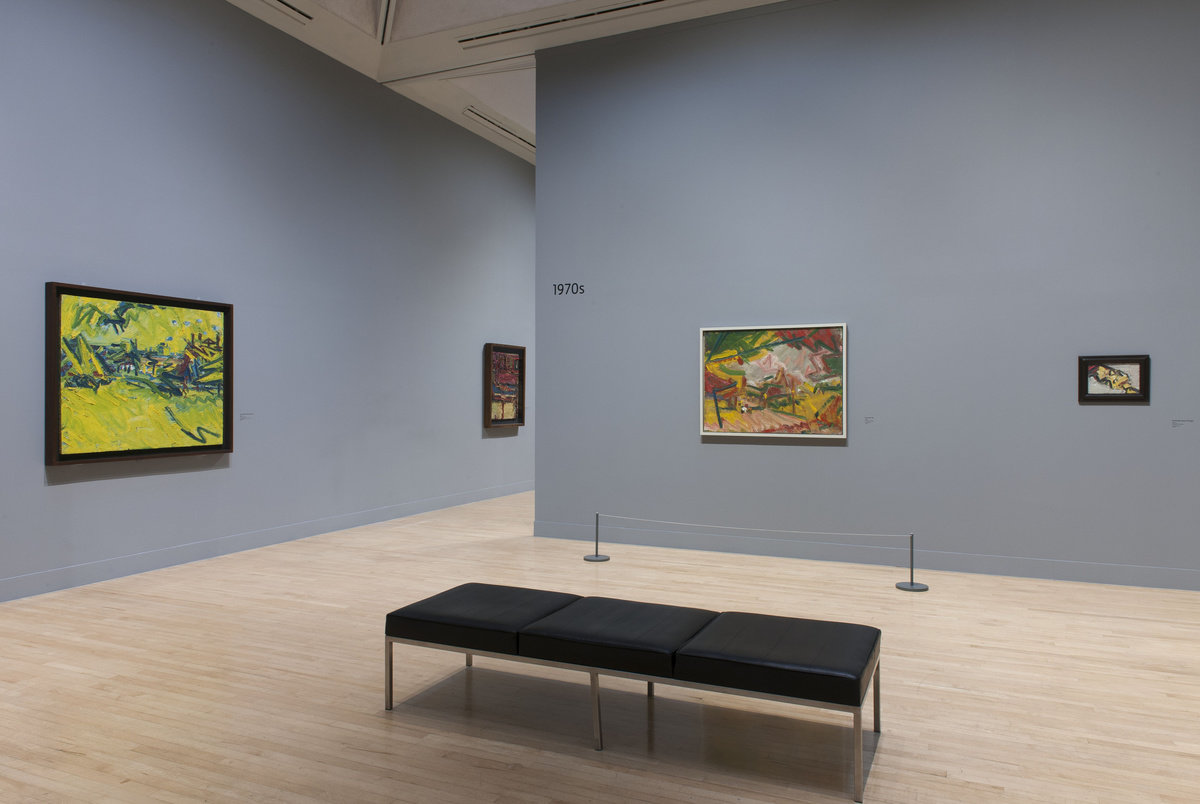
Installation view of Frank Auerbach's Retrospective Exhibition, October 9, 2015 - March 13, 2016, Tate Britain, London.

Joe Tilson’s Venice studio in 2015 before his 2016 exhibition, The Stones of Venice, which borrowed its title from John Ruskin’s three-volume examination of Venetian art and architecture.
Tilson first visited Italy in 1949 and has since drawn endless artistic inspiration from the country, dividing his time between London, Tuscany and Venice. The works in the exhibition celebrated the interdependence of painting, architecture, design and the written word. Venetian church façades, as well as the bold geometric patterns of the city’s stone streets, are recurring motifs.
Works such as PC from Venice Campana di San Marco, Calle dei Fabbri, 2015 and PC from Venice San Sebastiano, 2014 are presented as postcards from Venice, embedded in giant-sized replicas of envelopes—an idea first employed by Tilson in his 1960s Pop works. Other works such as The Stones of Venice Santa Maria Della Visitazione, Venusia, 2014 and The Stones of Venice, San Trovaso, Venaga, 2014 feature hand-written inscriptions of now defunct forms of the city’s name as outlined in the Italian poet Andrea Zanzotto’s work Filò. The varied decorative patterns within the works draw affinities with Islamic art, unsurprising in the light of Venice’s trading history and historical connections.
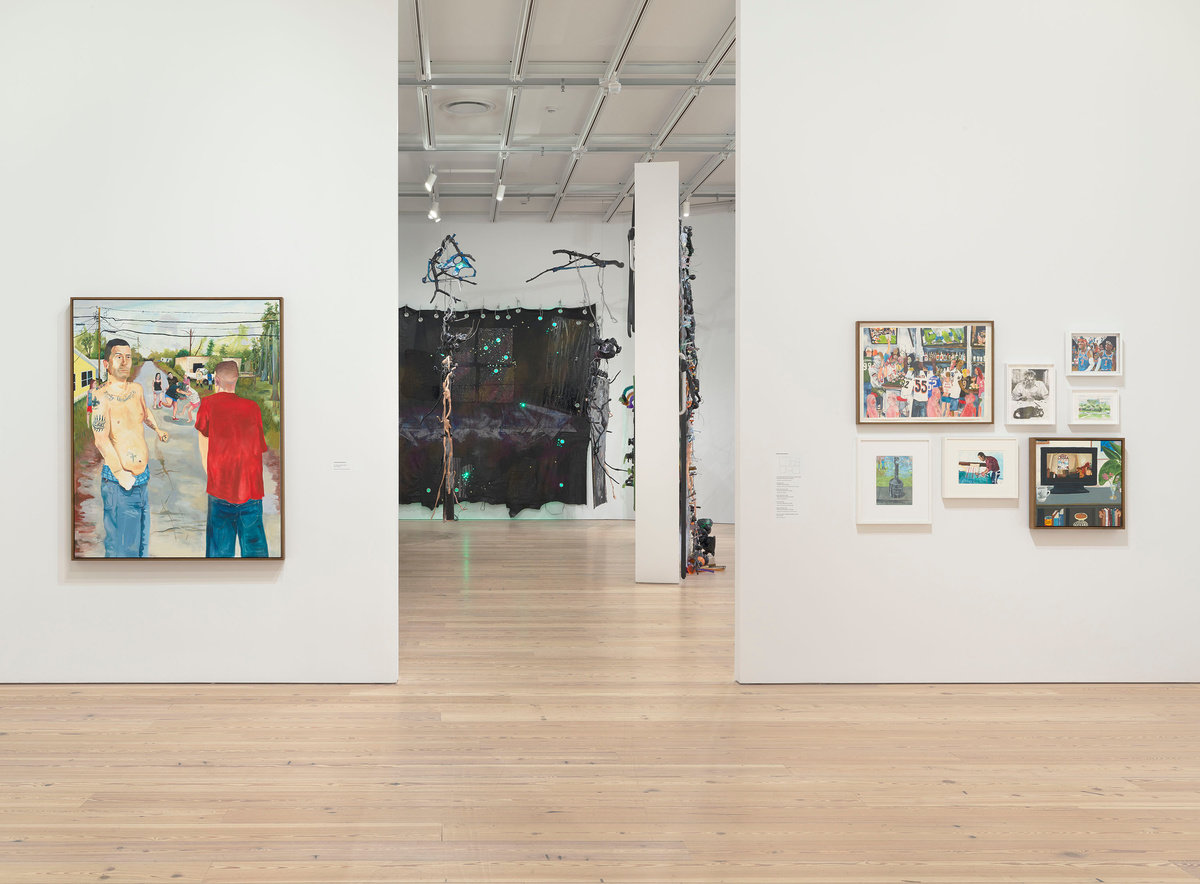
Celeste Dupuy-Spencer at the 2017 Whitney Biennial, curated by Christopher Lew and Mia Locks, at the Whitney Museum of American Art. Image courtesy of the Whitney Museum of American Art.
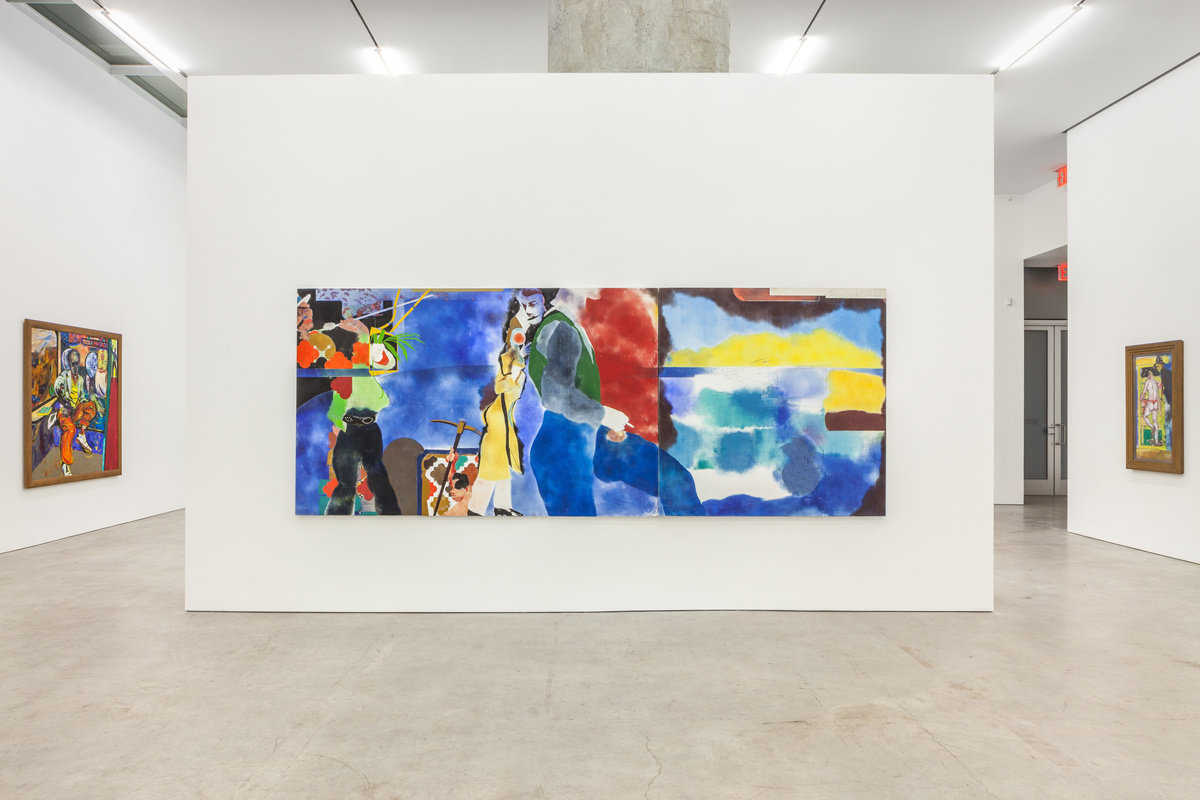
In March 2017, the gallery presented R.B. Kitaj: The Exile at Home to inaugurate the new Marlborough Contemporary’s programming in New York. The exhibition, curated by Barry Schwabsky, highlighted works from all phases of Kitaj’s career, from the late 1950s to several pieces made in 2007, the year of the artist’s death. Together, the works in the exhibition reiterated Kitaj’s passionate engagement with literary and artistic traditions (Cézanne and Matisse, Kafka and Walter Benjamin, to name a few), as well as his own personal quest to interpret and mythologize his identity and destiny.
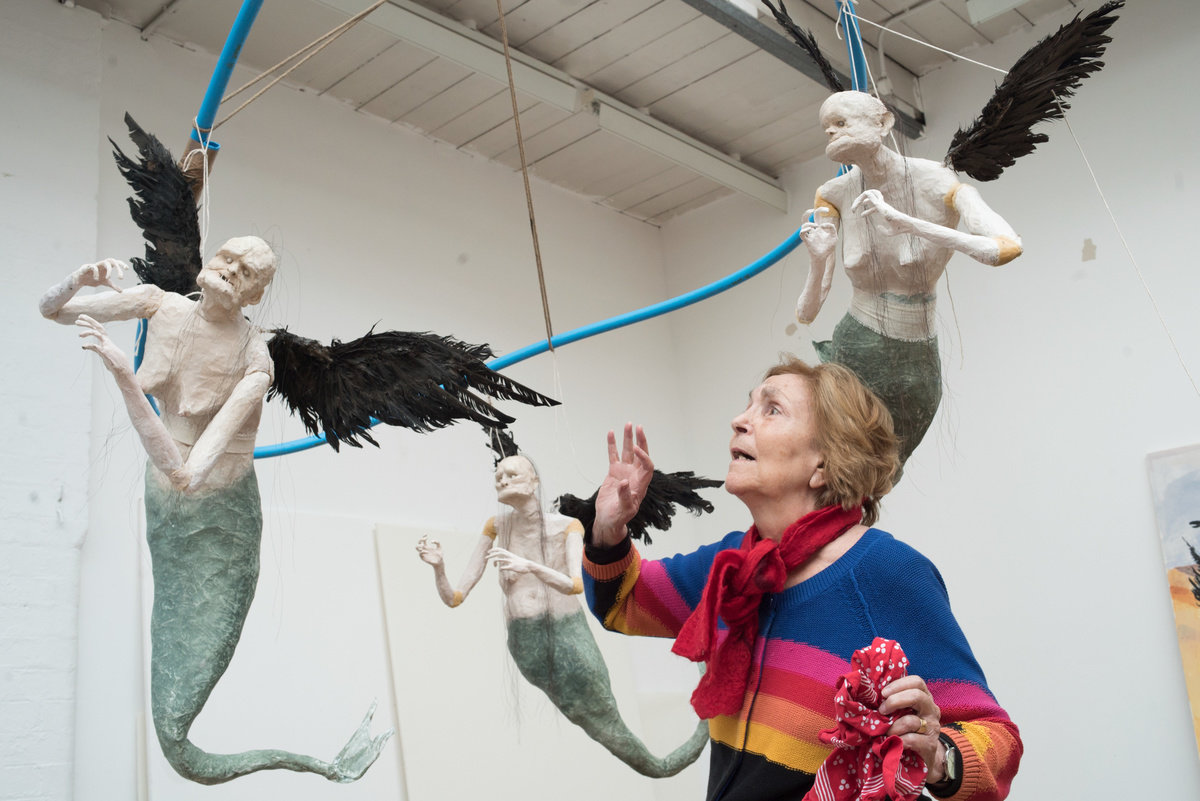
Paula Rego and The flying Mermaids in her London Studio. Photo: Nick Willing.

In Winter 2018, Marlborough Contemporary shut down West 25th Street in Manhattan to present a performance (and first commercial gallery exhibition) by San Francisco-based collective, Survival Research Laboratories (SRL). For the one night only performance, SRL activated eight kenetic sculptures dating from 1986 to the present including The Pitching Machine, which employs a 500 cubic-inch Cadillac Eldorado engine, linked to a sequence of spinning tires, that is capable of hurling a standard two-by-four at speeds up to 200 miles per hour. Photo: Walter Wlodarczyk.
2018
All Too Human was held at Tate Britain, London in 2018. The exhibition celebrated the painters in Britain who strove to intimately represent human figures, their relationships and surroundings.
The show brought together a small group of artists (Michael Andrews, Frank Auerbach, Francis Bacon, Lucian Freud, R.B. Kitaj, Leon Kossoff, Paula Rego and Euan Uglow) connected by ties of friendship and mutual admiration for the appearance and vulnerability of the body with the city of London as their surrounding context. Through their depictions of the figure and their own everyday landscapes, these artists conveyed the delicacy and vitality of the human condition while simultaneously developing new approaches and styles, reinventing their manner of representing life with pronounced individuality and imbuing painting with a rare intensity.
The exhibition also grounded this spirit in painting in a previous generation of artists, from Walter Sickert to David Bomberg, and how contemporary artists continue to express the tangible reality of life through paint.
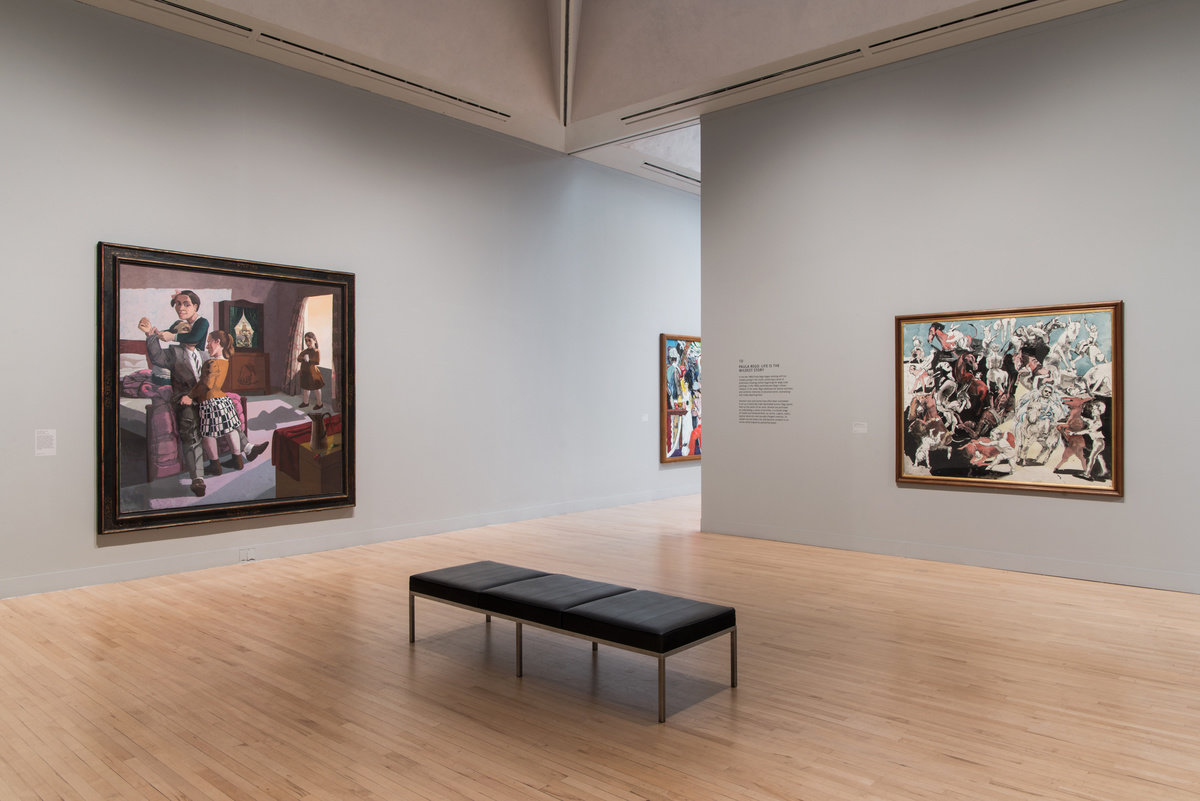
Instllation view of All Too Human February 28 - August 27, 2018, Tate Britain, London. Marlborough artists featured in the exhibition included Frank Auerbach, R.B. Kitaj, Leon Kossoff, Paula Rego and Euan Uglow.
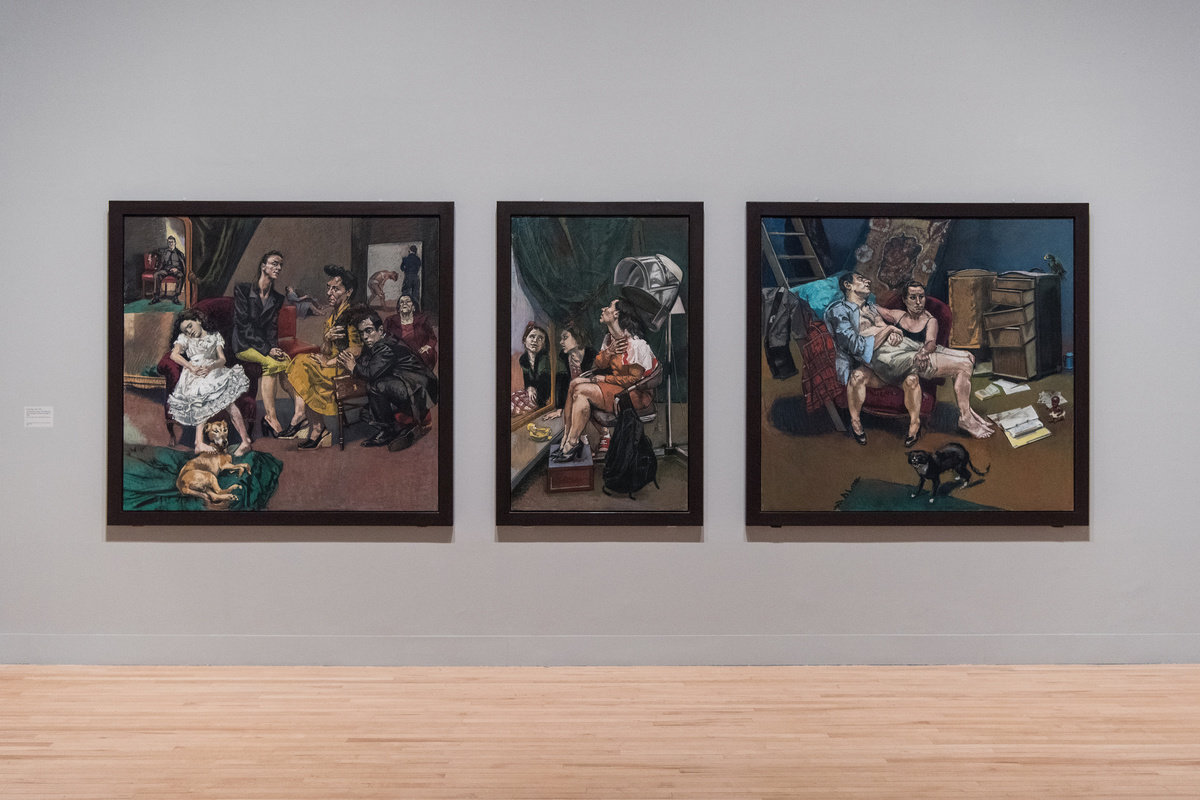
Installation view of All Too Human February 28 - August 27, 2018, Tate Britain, London. Marlborough artists featured in the exhibition included Frank Auerbach, R.B. Kitaj, Leon Kossoff, Paula Rego and Euan Uglow.
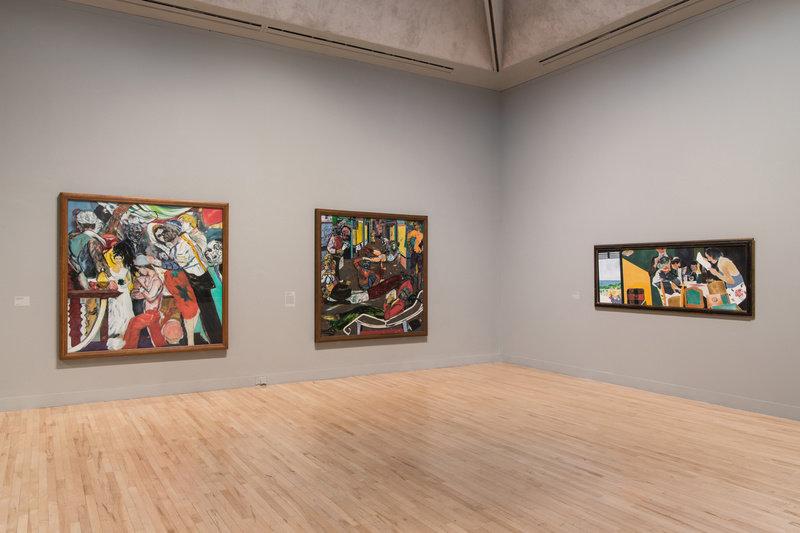
Instllation view of All Too Human February 28 - August 27, 2018, Tate Britain, London. Marlborough artists featured in the exhibition included Frank Auerbach, R.B. Kitaj, Leon Kossoff, Paula Rego and Euan Uglow.
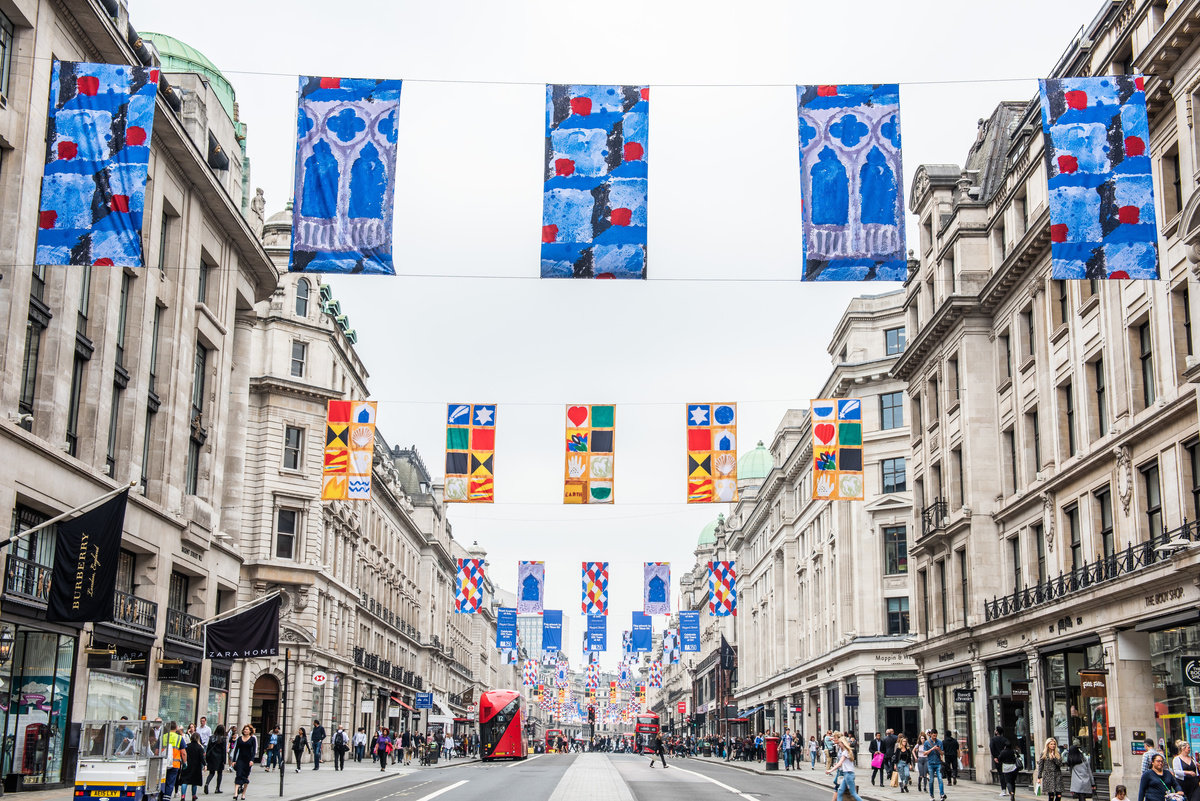
In Summer 2018, Joe Tilson’s flags depicting details from his ‘The Stones of Venice’ series hung from Regent Street in London to celebrate the Royal Academy’s 250th anniversary.

At Art Basel 2018, Marlborough presented a curated group show of German art centring on the post-modernist artist Werner Büttner. The exhibition demonstrated the complex interplay between Büttner’s work and that of his forebears in pre-war Germany. Büttner’s collages and paintings from the 1980s to the present day will be on displayed alongside an exclusive selection of 20th Century German masterpieces by artists including Max Beckmann, Lyonel Feininger, Emil Nolde and Kurt Schwitters. For all of these artists, like Büttner, painting constituted a formidable objection to the way things are. Büttner constantly tests convention with his images and iconography which often employ wit, word play, sarcasm and humor, as an effective counter to the aesthetics of modernism. This marks him out as an inimitable re-interpreter of painting’s history and one of the outstanding painters at work today.
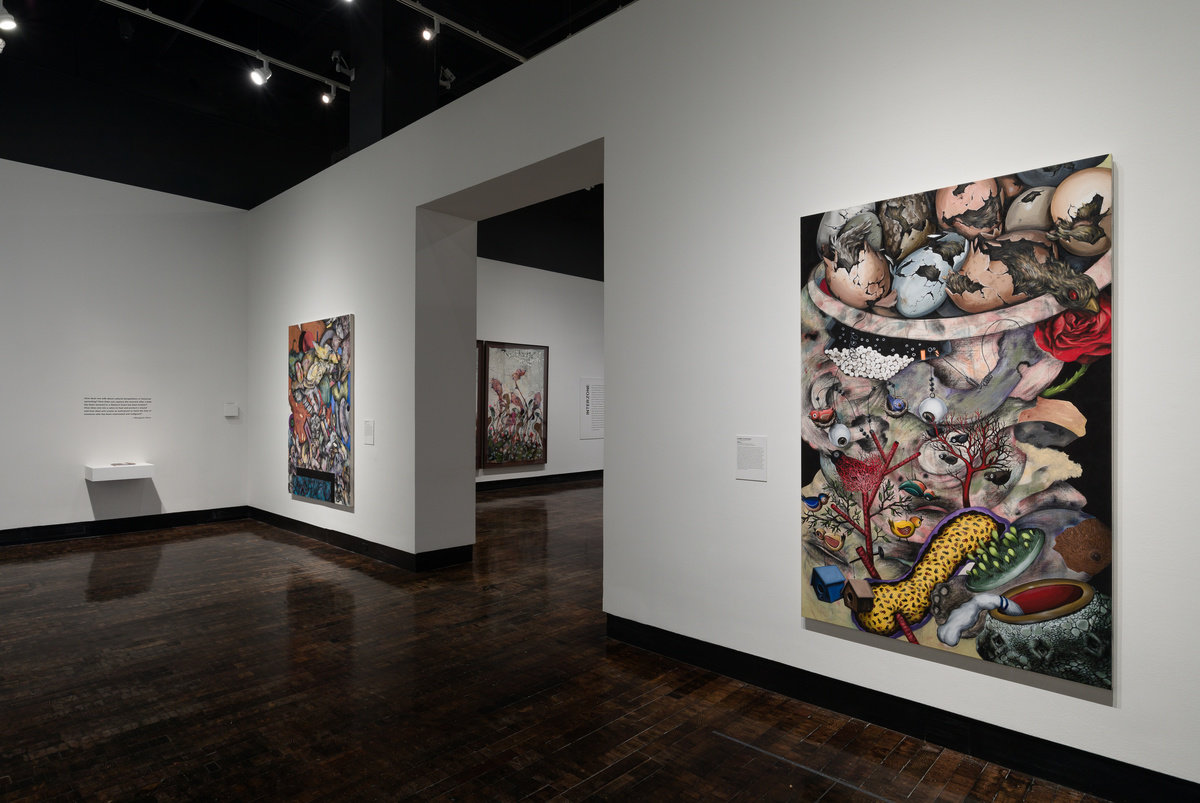
Installation view of Chaos and Awe: Painting for the 21st Century, featuring two works by Ahmed Alsoudani. The exhibition, a sweeping survey of contemporary art organized by Mark Scala, ran from June 22 - September 16, 2018 at the Frist Art Museum, Nashville, Tennessee, and travelled to the Chrysler Museum, Norfolk, Virginia from November 15, 2018 to April 28, 2019.
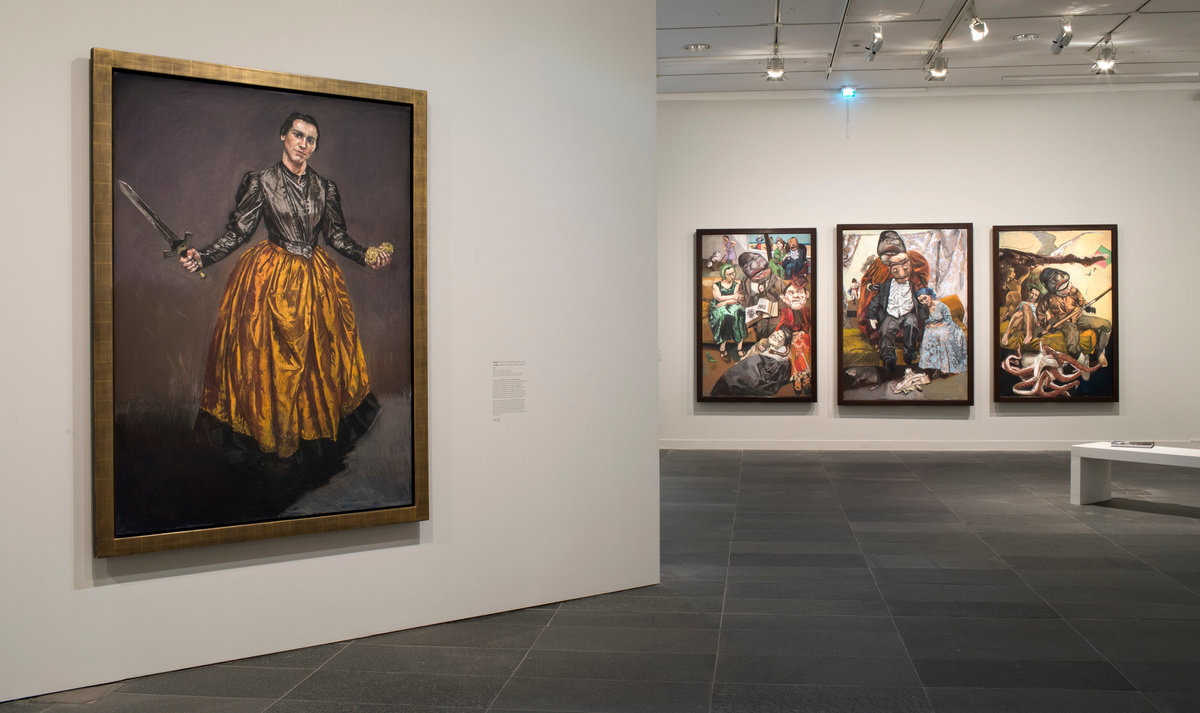
The Cruel Stories of Paula Rego, October 17, 2018 - January 14, 2019, Musée de l’Orangerie, Paris.
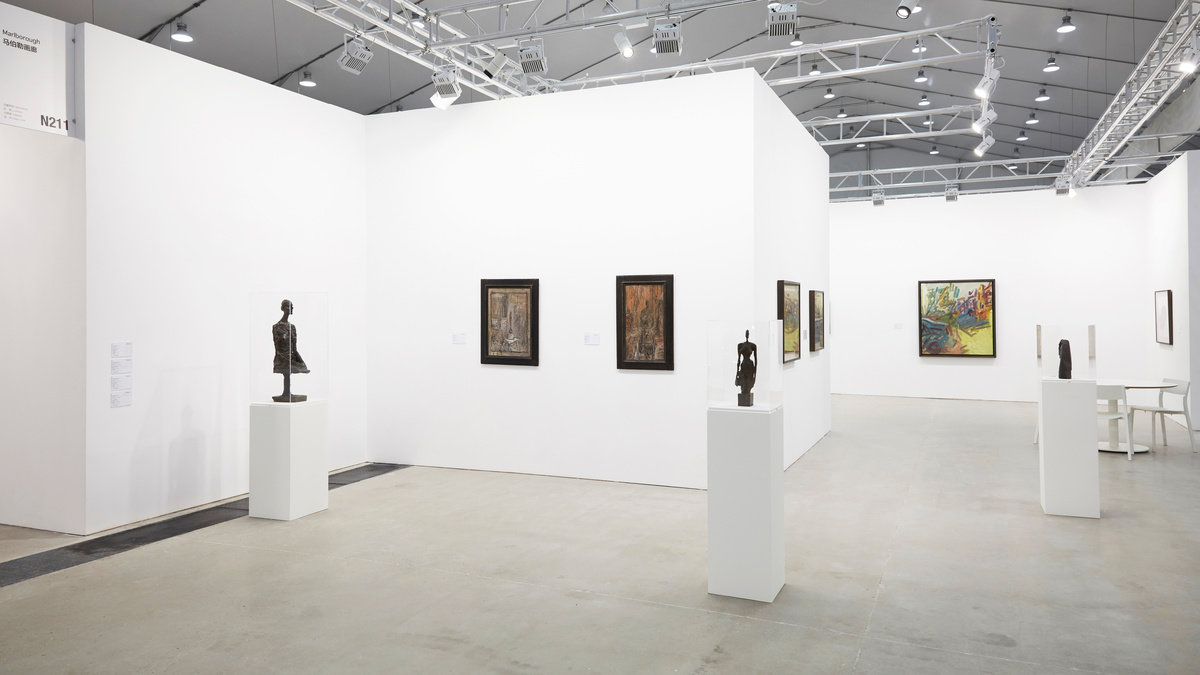
In 2018, Marlborough London presented works by two towering figures in post-war art, Frank Auerbach and Alberto Giacometti, at West Bund, Shanghai. Giacometti reinvented the human figure to express the profound trauma of the war and the doubts about the human condition that it raised. Complementing Giacometti’s sculpture was the quiet, thoughtful and intense art of Frank Auerbach, whose works express a combination of simple surroundings and an intimate portrayal of subjects tackled over many years with indefatigable energy.
Installation view of Marlborough's stand at the 2018 edition of West Bund Art & Design, Shanghai.
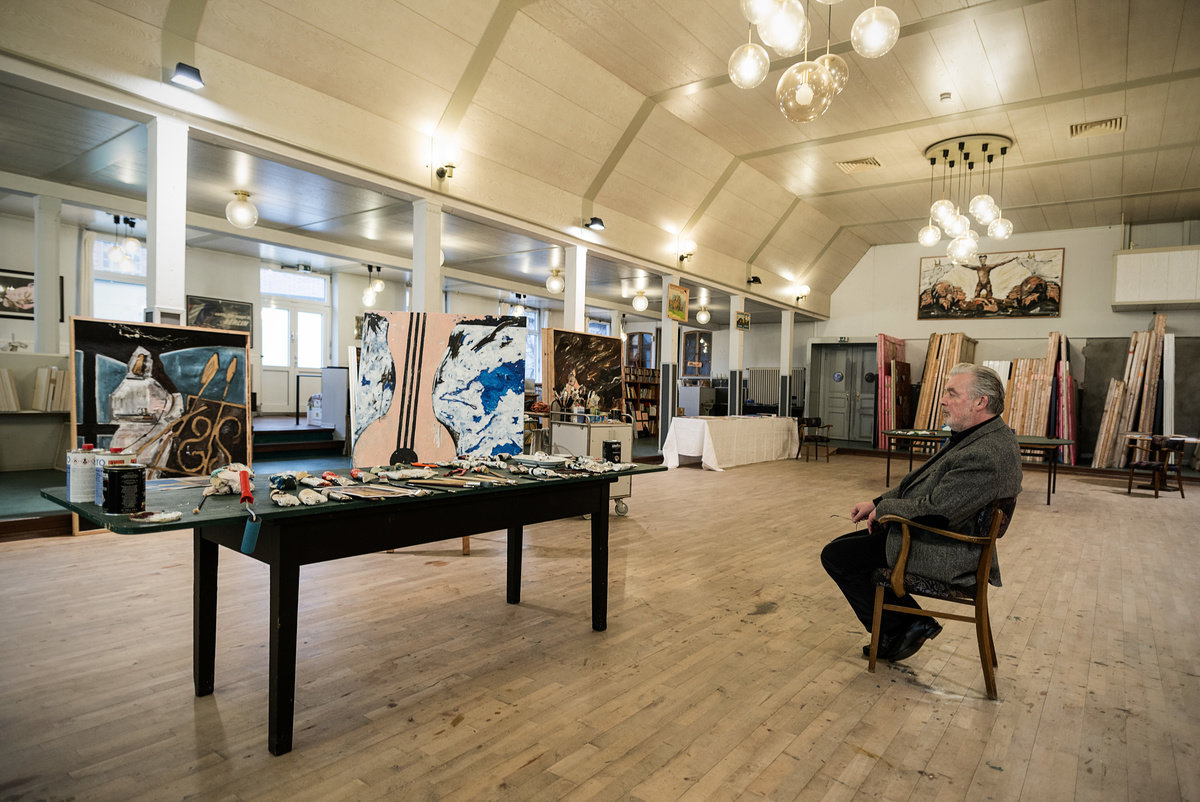
Werner Büttner in his studio in Geesthacht, Germany, 2018. Photo: Egbert Haneke.
There are many ways of creating reality. There is always a gap between theoretical reality and subjective reality. I want to create situations in which you have a chance to reconstruct your perception.
Julius von Bismarck on his 2019 installation at Palais de Tokyo, Paris, Die Mimik der Tethys.
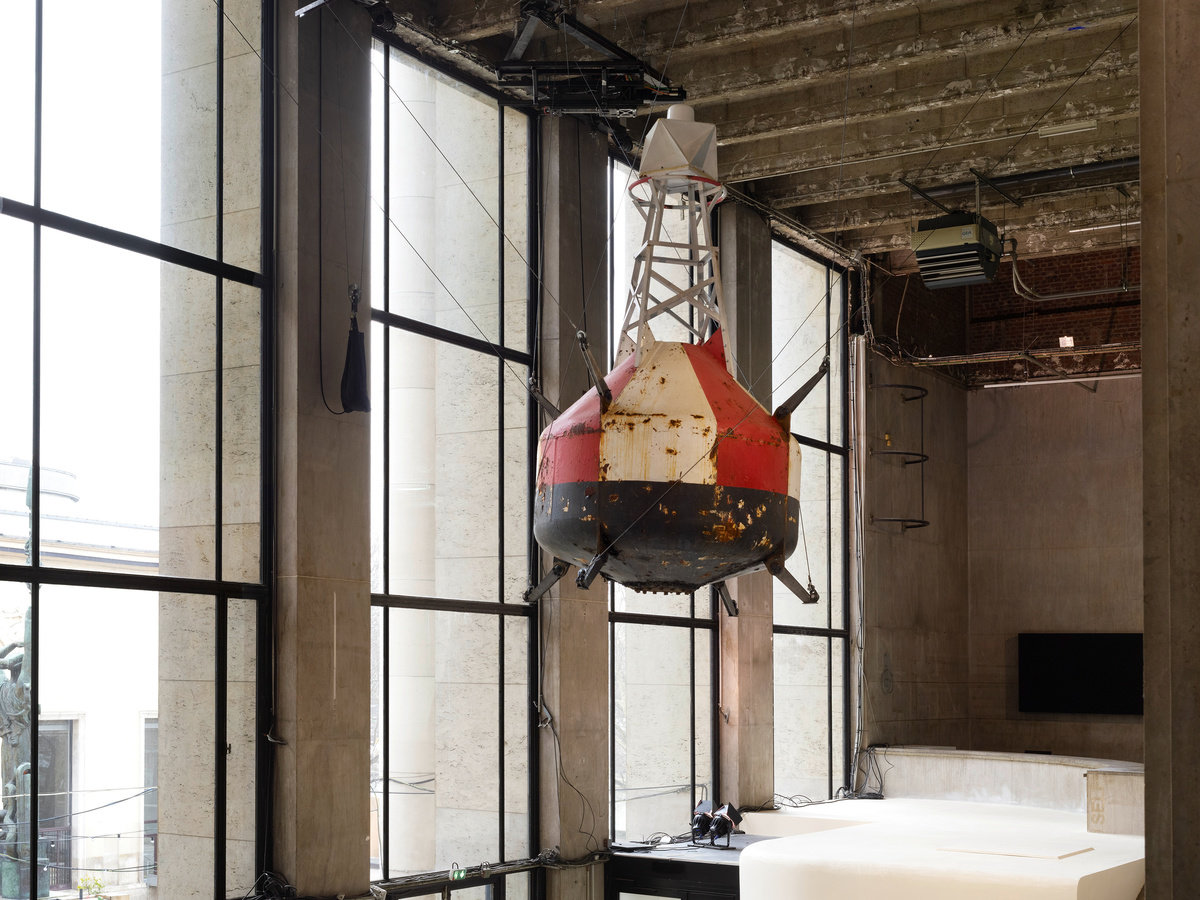
Installation view of Julius von Bismarck's Die Mimik der Tethys, 2019, at Palais de Tokyo, Paris.
Tate announces #5WomenArtists campaign featuring Magdalena Abakanowicz and Paula Rego
2019
In March 2019, Tate announced its #5WomenArtists campaign, consisting of five large-scale solo exhibitions of women artists all set to open in its galleries in 2020-2021. These will include a 2020 exhibition of Magdalena Abakanowicz at Tate Modern and a 2021 career-spanning retrospective of Paula Rego’s paintings, drawings and prints at Tate Britain.